-

Win a Free Custom Engraved Brass Coin!!!
As a way to introduce our brass coins to the community, we will raffle off a free coin during the month of August. Follow link ABOVE for instructions for entering.
You are using an out of date browser. It may not display this or other websites correctly.
You should upgrade or use an alternative browser.
You should upgrade or use an alternative browser.
Naval/Maritime History 27th of August - Today in Naval History - Naval / Maritime Events in History
Today in Naval History - Naval / Maritime Events in History
1 January 1807 - Squadron under Cptn. Charles Brisbane,HMS Arethusa (38), HMS Latona (38), James Athol Wood, HMS Anson (44), Charles Lydiard, HMS Fisguard (38), William Bolton, captured Curacoa.
Capture of Curaçao
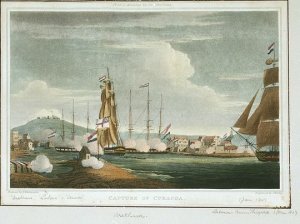
The capture of Curaçao, depicted by Thomas Whitcombe
HMS Anson was then assigned to Charles Brisbane's squadron and joined Brisbane's Arethusa and James Athol Wood's HMS Latona.
The ships were despatched in November 1806 by Vice-Admiral James Richard Dacres to reconnoitre Curaçao. They were joined in December by HMS Fisgard and Brisbane decided to launch an attack. The British ships approached early in the morning of 1 January 1807 and anchored in the harbour. They were attacked by the Dutch, at which Brisbane boarded and captured the 36-gun frigate Halstaar, while Lydiard attacked and secured the 20-gun corvette Suriname. Both Lydiard and Brisbane then led their forces on shore, and stormed Fort Amsterdam, which was defended by 270 Dutch troops. The fort was carried after ten minutes of fighting, after which two smaller forts, a citadel and the entire town were also taken. More troops were landed while the ships sailed round the harbour to attack Fort République. By 10 am the fort had surrendered, and by noon the entire island had capitulated.
Anson had seven men wounded. In all, the British lost three killed and 14 wounded. On the ships alone, the Dutch lost six men killed, including Commandant Cornelius J. Evertz, who commanded the Dutch naval force in Curaçao, and seven wounded, of whom one died later. With the colony, the British captured the frigate Kenau Hasselar, the sloop Suriname (a former Royal Naval sloop), and two naval schooners.
Anson was sent back to Britain carrying the despatches and captured colours. The dramatic success of the small British force carrying the heavily defended island was rewarded handsomely. Brisbane was knighted, and the captains received swords, medals and vases.
In 1847 the Admiralty authorised the issue of the Naval General Service Medal with clasp "Curacoa 1 Jany. 1807" to any surviving claimants from the action; 65 medals were issued.
HMS Halstarr was the Dutch frigate Kenau Hasselar (or Kenau Hasselaar), launched in 1800 that the British captured at Curaçao in 1807. The Royal Navy took her into service but the Admiralty sold her for breaking up in 1809.
The 20-gun French corvette Hussard (or Hussar) was launched in 1799 and the British captured her that same year when they captured Suriname. The Royal Navy took her into service as HMS Surinam, as there was already an HMS Hussar. The Dutch captured her in 1803, naming her Suriname, but the British recaptured her in 1807 and sent her to Britain. Thereafter she never again served on active duty. She disappeared from the Navy lists in 1809, but her fate is unknown.
https://en.wikipedia.org/wiki/HMS_Anson_(1781)
https://en.wikipedia.org/wiki/French_frigate_Résistance_(1796)
https://en.wikipedia.org/wiki/HMS_Latona_(1781)
https://en.wikipedia.org/wiki/French_corvette_Hussard_(1799)
https://en.wikipedia.org/wiki/HMS_Halstarr_(1807)
1 January 1807 - Squadron under Cptn. Charles Brisbane,HMS Arethusa (38), HMS Latona (38), James Athol Wood, HMS Anson (44), Charles Lydiard, HMS Fisguard (38), William Bolton, captured Curacoa.
Capture of Curaçao

The capture of Curaçao, depicted by Thomas Whitcombe
HMS Anson was then assigned to Charles Brisbane's squadron and joined Brisbane's Arethusa and James Athol Wood's HMS Latona.
The ships were despatched in November 1806 by Vice-Admiral James Richard Dacres to reconnoitre Curaçao. They were joined in December by HMS Fisgard and Brisbane decided to launch an attack. The British ships approached early in the morning of 1 January 1807 and anchored in the harbour. They were attacked by the Dutch, at which Brisbane boarded and captured the 36-gun frigate Halstaar, while Lydiard attacked and secured the 20-gun corvette Suriname. Both Lydiard and Brisbane then led their forces on shore, and stormed Fort Amsterdam, which was defended by 270 Dutch troops. The fort was carried after ten minutes of fighting, after which two smaller forts, a citadel and the entire town were also taken. More troops were landed while the ships sailed round the harbour to attack Fort République. By 10 am the fort had surrendered, and by noon the entire island had capitulated.
Anson had seven men wounded. In all, the British lost three killed and 14 wounded. On the ships alone, the Dutch lost six men killed, including Commandant Cornelius J. Evertz, who commanded the Dutch naval force in Curaçao, and seven wounded, of whom one died later. With the colony, the British captured the frigate Kenau Hasselar, the sloop Suriname (a former Royal Naval sloop), and two naval schooners.
Anson was sent back to Britain carrying the despatches and captured colours. The dramatic success of the small British force carrying the heavily defended island was rewarded handsomely. Brisbane was knighted, and the captains received swords, medals and vases.
In 1847 the Admiralty authorised the issue of the Naval General Service Medal with clasp "Curacoa 1 Jany. 1807" to any surviving claimants from the action; 65 medals were issued.
HMS Halstarr was the Dutch frigate Kenau Hasselar (or Kenau Hasselaar), launched in 1800 that the British captured at Curaçao in 1807. The Royal Navy took her into service but the Admiralty sold her for breaking up in 1809.
The 20-gun French corvette Hussard (or Hussar) was launched in 1799 and the British captured her that same year when they captured Suriname. The Royal Navy took her into service as HMS Surinam, as there was already an HMS Hussar. The Dutch captured her in 1803, naming her Suriname, but the British recaptured her in 1807 and sent her to Britain. Thereafter she never again served on active duty. She disappeared from the Navy lists in 1809, but her fate is unknown.
https://en.wikipedia.org/wiki/HMS_Anson_(1781)
https://en.wikipedia.org/wiki/French_frigate_Résistance_(1796)
https://en.wikipedia.org/wiki/HMS_Latona_(1781)
https://en.wikipedia.org/wiki/French_corvette_Hussard_(1799)
https://en.wikipedia.org/wiki/HMS_Halstarr_(1807)
Today in Naval History - Naval / Maritime Events in History
1 January 1813 – Launch of Competitor at Whitby in 1813. She was initially a West Indiaman and then traded with India, but made also two voyages as convict ship to Australia
Competitor was launched at Whitby in 1813. She was initially a West Indiaman and then traded with India. She made two voyages transporting convicts to Australia, one to Van Diemen's Land and one to Port Jackson. She is last listed in 1833.
Tons burthen: 423, or 425 30⁄94 (bm)
Length: 113 ft 6 in (34.6 m)
Beam: 29 ft 5 in (9.0 m)[1]
Propulsion: Sail
Sail plan: Brig
Armament:
Career
Competitor cost £10,396 19s 4d. She entered the Register of Shipping in 1814 with Anthony Buck, master, G. Smales, owner, and trade Whitby–West Indies.[3]Competitor only entered Lloyd's Register in the volume for 1815. She entered with trade Portsmouth–London.
On 10 June1816 Orpheus, Bathgate, master, was sailing from New Orleans to Liverpool when she foundered at 31°N 81°W. Competitor was coming from Jamaica when she saved the crew. Competitor then brought them into London.
In 1820 Competitor's registry shifted to London. On 6 September Captain G. Low sailed Competitor to Bombay under a license from the British East India Company. Her owner was now Longster.
Convict voyage to Van Dieman's Land (1823): Captain William Ascough sailed from England on 18 March 1823, bound for Van Diemen's Land. She sailed via the Cape of Good Hope and arrived at Hobart Town on 3 August. Competitor had embarked 160 male convicts and she landed 157.
On 6 December 1824 Competitor was at Portsmouth when her crew refused to put to sea because the wind was blowing so strongly. ALl the other outward-bound vessels left.
Convict voyage to Port Jackson (1828): Captain John Steward (or Stewart), sailed from England on 13 June 1828, bound for Port Jackson. Competitor arrived there on 10 October. She had embarked 99 female convicts and suffered no convict deaths en route.
Fate
Competitor is last listed in both Lloyd's Register and the Register of Shipping in 1833. However the data is stale. She last appears in Lloyd's List in 1830
https://en.wikipedia.org/wiki/Competitor_(1813_ship)
https://www.jenwilletts.com/convict_ship_competitor_1828.htm
1 January 1813 – Launch of Competitor at Whitby in 1813. She was initially a West Indiaman and then traded with India, but made also two voyages as convict ship to Australia
Competitor was launched at Whitby in 1813. She was initially a West Indiaman and then traded with India. She made two voyages transporting convicts to Australia, one to Van Diemen's Land and one to Port Jackson. She is last listed in 1833.
Tons burthen: 423, or 425 30⁄94 (bm)
Length: 113 ft 6 in (34.6 m)
Beam: 29 ft 5 in (9.0 m)[1]
Propulsion: Sail
Sail plan: Brig
Armament:
- 1814: 10 × 4-pounder guns
- 1815: 2 × 6-pounder guns
Career
Competitor cost £10,396 19s 4d. She entered the Register of Shipping in 1814 with Anthony Buck, master, G. Smales, owner, and trade Whitby–West Indies.[3]Competitor only entered Lloyd's Register in the volume for 1815. She entered with trade Portsmouth–London.
On 10 June1816 Orpheus, Bathgate, master, was sailing from New Orleans to Liverpool when she foundered at 31°N 81°W. Competitor was coming from Jamaica when she saved the crew. Competitor then brought them into London.
In 1820 Competitor's registry shifted to London. On 6 September Captain G. Low sailed Competitor to Bombay under a license from the British East India Company. Her owner was now Longster.
Convict voyage to Van Dieman's Land (1823): Captain William Ascough sailed from England on 18 March 1823, bound for Van Diemen's Land. She sailed via the Cape of Good Hope and arrived at Hobart Town on 3 August. Competitor had embarked 160 male convicts and she landed 157.
On 6 December 1824 Competitor was at Portsmouth when her crew refused to put to sea because the wind was blowing so strongly. ALl the other outward-bound vessels left.
Convict voyage to Port Jackson (1828): Captain John Steward (or Stewart), sailed from England on 13 June 1828, bound for Port Jackson. Competitor arrived there on 10 October. She had embarked 99 female convicts and suffered no convict deaths en route.
Fate
Competitor is last listed in both Lloyd's Register and the Register of Shipping in 1833. However the data is stale. She last appears in Lloyd's List in 1830
https://en.wikipedia.org/wiki/Competitor_(1813_ship)
https://www.jenwilletts.com/convict_ship_competitor_1828.htm
Today in Naval History - Naval / Maritime Events in History
1 January 1822 – Launch of HMS Samarang, a 28-gun, teak, Atholl-class sixth rate of the Royal Navy. She was launched at Cochin in 1822 by the East India Company.
HMS Samarang was a 28-gun, teak, Atholl-class sixth rate of the Royal Navy. She was launched at Cochin in 1822 by the East India Company.
Class and type: 28-gun Atholl-classsixth rate
Tons burthen: 499 91⁄94bm (as designed)
Length:
Sail plan: Full-rigged ship
Complement: 175
Armament:



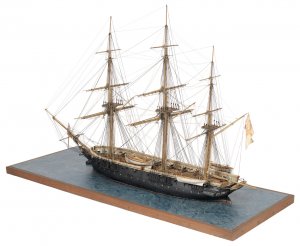
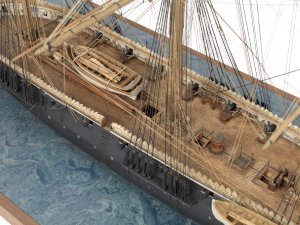
Scale: 1:48. A contemporary waterline model of the 28-gun sixth-rate frigate ‘Samarang’ (1822). A highly detailed model of a wooden frigate prior to the introduction of steam. It is complete with all the fittings on deck including the guns fully rigged to their carriages, hammocks stowed in the nettings around the gunwales, spare topmasts and spars under the boats in the waist and the shot stored around the hatch combings ready for use. The rigging is equally detailed and shows the sails bent on to the yards and in harbour stow, and the addition of the trysail ‘snow’ rigged just aft on each of the lower mast. Built by Cochin in the East Indies, the ‘Samarang’ measured 133 feet along the gun deck by 31 feet in the beam and was 500 tons burthen. It was fitted with both 32- and 18-pounder carronades and carried a complement of 175 men. Its career included duty stations around the world such as the Mediterranean, South America, Cape of Good Hope and in 1840–41, it saw action in the First Opium War at the Chuenpi Forts. ‘Samarang’ also carried out survey work in the East Indies from 1843–47 during which it encountered Malay pirates at Gikolo. The final years were spent as a guard ship at Gibraltar where it was eventually sold for breaking in 1880.
She served in various stations around the world until seeing action in the First Opium War, and was then employed, under Edward Belcher, in surveying the coast of Borneo from 1843 to 1846. English zoologist, Arthur Adams, who was assistant surgeon on the ship for this voyage later edited Zoology of the voyage of H.M.S. Samarang (1850), an account of the survey. She later became a guardship at Gibraltar before being sold for breaking in 1883.
The first application of cathodic protection was to HMS Samarang in 1824. Sacrificial anodes made from iron attached to the copper sheath of the hull below the waterline dramatically reduced the corrosion rate of the copper. However, a side effect of the cathodic protection was to increase marine growth. Copper, when corroding, releases copper ions which have an anti-fouling effect. Since excess marine growth affected the performance of the ship, the Royal Navy decided that it was better to allow the copper to corrode and have the benefit of reduced marine growth, so cathodic protection was not used further.
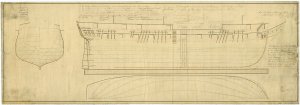
Scale 1:48. Plan showing the body plan, sheer lines with some midship framing and longitudinal half breadth for Ranger (1820), Tweed (1823), Rainbow (1823), Rattlesnake (1822), Crocodile (1825),Success (1825), Talbot (1824) and with alterations for Alligator (1821), Samarang (1822), Herald (1822) - ex Termagant, and later for North Star (1820), Daphne (cancelled 1832), Porcupine (cancelled 1832), Nimrod (1828) – ex Andromache, Alarm (cancelled 1826), all 28-gun Sixth Rate Sloops. Signed Joseph Tucker and Robert Seppings (Surveyors of the Navy) Annotation at the top right: "Mem: The Head was altered agreeably to a sketch dated Nov 6th 1821." Annotation on the right: " 14th May 1823. The following ships were ordered to be built agreeably to the alterations in ticked lines in the fore body viz Alarm, Crocodile, Daphne, Porcupine and Sucess." "2nd June 1830. The main rails of the head of the Talbot was directed to be moved 8ins and the Birthing rails about fuurther from the side at the front of the supporters." Annoted in pencil at bottom right: "Memo ? ? lines for the Model."
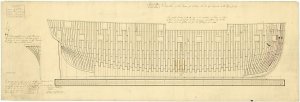
Scale 1:48. Plan showing the framing profile and disposition for building Niemen (1820), Ranger (1820), Tweed (1823), Rainbow (1823), Rattlesnake (1822),North Star (1820), Talbot (1824), Daphne (cancelled 1832), Porcupine (cancelled 1832), Nimrod (1828) – ex Andromache, Alarm (cancelled 1826), all 28-gun Sixth Rate Sloops. The bow modifications are dated 1821. In the bottom left of the plan is a list of ship names and the yards to which they were sent. Annoted on the right in faint pencil: "May 1821. A sketch as shown in red was sent to the severel yards viz Niemen, Ranger, Tweed, Rainbow, Rattlesnake,North Star, Talbot, Daphne, Porcupine,Andromache, Alarm "
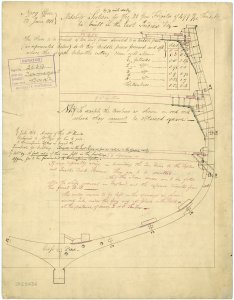
Scale 1:48. Plan showing the midship section with modifications for Termagant (1822), Alligator (1821), Samarang (1822), all 28-gun, Sixth Rate Sloops, building in the East Indies.
https://en.wikipedia.org/wiki/HMS_Samarang_(1822)
http://collections.rmg.co.uk/collec...el-345652;browseBy=vessel;vesselFacetLetter=S
http://collections.rmg.co.uk/collections.html#!csearch;searchTerm=Samarang_1822
https://en.wikipedia.org/wiki/Atholl-class_corvette
1 January 1822 – Launch of HMS Samarang, a 28-gun, teak, Atholl-class sixth rate of the Royal Navy. She was launched at Cochin in 1822 by the East India Company.
HMS Samarang was a 28-gun, teak, Atholl-class sixth rate of the Royal Navy. She was launched at Cochin in 1822 by the East India Company.
Class and type: 28-gun Atholl-classsixth rate
Tons burthen: 499 91⁄94bm (as designed)
Length:
- 113 ft 8 in (34.65 m) (gundeck)
- 94 ft 8 3⁄4 in (28.873 m) (keel)
Sail plan: Full-rigged ship
Complement: 175
Armament:
- Upper Deck: 20 × 32-pounder carronades
- QD: 6 × 18-pounder carronades
- Fc: 2 × 9-pounder guns





Scale: 1:48. A contemporary waterline model of the 28-gun sixth-rate frigate ‘Samarang’ (1822). A highly detailed model of a wooden frigate prior to the introduction of steam. It is complete with all the fittings on deck including the guns fully rigged to their carriages, hammocks stowed in the nettings around the gunwales, spare topmasts and spars under the boats in the waist and the shot stored around the hatch combings ready for use. The rigging is equally detailed and shows the sails bent on to the yards and in harbour stow, and the addition of the trysail ‘snow’ rigged just aft on each of the lower mast. Built by Cochin in the East Indies, the ‘Samarang’ measured 133 feet along the gun deck by 31 feet in the beam and was 500 tons burthen. It was fitted with both 32- and 18-pounder carronades and carried a complement of 175 men. Its career included duty stations around the world such as the Mediterranean, South America, Cape of Good Hope and in 1840–41, it saw action in the First Opium War at the Chuenpi Forts. ‘Samarang’ also carried out survey work in the East Indies from 1843–47 during which it encountered Malay pirates at Gikolo. The final years were spent as a guard ship at Gibraltar where it was eventually sold for breaking in 1880.
She served in various stations around the world until seeing action in the First Opium War, and was then employed, under Edward Belcher, in surveying the coast of Borneo from 1843 to 1846. English zoologist, Arthur Adams, who was assistant surgeon on the ship for this voyage later edited Zoology of the voyage of H.M.S. Samarang (1850), an account of the survey. She later became a guardship at Gibraltar before being sold for breaking in 1883.
The first application of cathodic protection was to HMS Samarang in 1824. Sacrificial anodes made from iron attached to the copper sheath of the hull below the waterline dramatically reduced the corrosion rate of the copper. However, a side effect of the cathodic protection was to increase marine growth. Copper, when corroding, releases copper ions which have an anti-fouling effect. Since excess marine growth affected the performance of the ship, the Royal Navy decided that it was better to allow the copper to corrode and have the benefit of reduced marine growth, so cathodic protection was not used further.

Scale 1:48. Plan showing the body plan, sheer lines with some midship framing and longitudinal half breadth for Ranger (1820), Tweed (1823), Rainbow (1823), Rattlesnake (1822), Crocodile (1825),Success (1825), Talbot (1824) and with alterations for Alligator (1821), Samarang (1822), Herald (1822) - ex Termagant, and later for North Star (1820), Daphne (cancelled 1832), Porcupine (cancelled 1832), Nimrod (1828) – ex Andromache, Alarm (cancelled 1826), all 28-gun Sixth Rate Sloops. Signed Joseph Tucker and Robert Seppings (Surveyors of the Navy) Annotation at the top right: "Mem: The Head was altered agreeably to a sketch dated Nov 6th 1821." Annotation on the right: " 14th May 1823. The following ships were ordered to be built agreeably to the alterations in ticked lines in the fore body viz Alarm, Crocodile, Daphne, Porcupine and Sucess." "2nd June 1830. The main rails of the head of the Talbot was directed to be moved 8ins and the Birthing rails about fuurther from the side at the front of the supporters." Annoted in pencil at bottom right: "Memo ? ? lines for the Model."

Scale 1:48. Plan showing the framing profile and disposition for building Niemen (1820), Ranger (1820), Tweed (1823), Rainbow (1823), Rattlesnake (1822),North Star (1820), Talbot (1824), Daphne (cancelled 1832), Porcupine (cancelled 1832), Nimrod (1828) – ex Andromache, Alarm (cancelled 1826), all 28-gun Sixth Rate Sloops. The bow modifications are dated 1821. In the bottom left of the plan is a list of ship names and the yards to which they were sent. Annoted on the right in faint pencil: "May 1821. A sketch as shown in red was sent to the severel yards viz Niemen, Ranger, Tweed, Rainbow, Rattlesnake,North Star, Talbot, Daphne, Porcupine,Andromache, Alarm "

Scale 1:48. Plan showing the midship section with modifications for Termagant (1822), Alligator (1821), Samarang (1822), all 28-gun, Sixth Rate Sloops, building in the East Indies.
https://en.wikipedia.org/wiki/HMS_Samarang_(1822)
http://collections.rmg.co.uk/collec...el-345652;browseBy=vessel;vesselFacetLetter=S
http://collections.rmg.co.uk/collections.html#!csearch;searchTerm=Samarang_1822
https://en.wikipedia.org/wiki/Atholl-class_corvette
Today in Naval History - Naval / Maritime Events in History
1 January 1863 - The Battle of Galveston was a naval and land battle of the American Civil War,
The Battle of Galveston was a naval and land battle of the American Civil War, when Confederate forces under Major Gen. John B. Magruder expelled occupying Union troops from the city of Galveston, Texas on January 1, 1863.
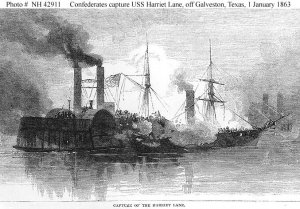
CS Bayou City captures USS Harriet Lane during the Battle of Galveston
After the loss of the cutter Harriet Lane, the Union Fleet Commander William B. Renshaw blew up the stranded vessel USS Westfield to save it from falling into enemy hands. Union troops on shore thought the fleet was surrendering, and laid down their arms.
The battle is sometimes called the Second Battle of Galveston, as the Battle of Galveston Harbor (October 1862) is sometimes called the First Battle of Galveston.
Battle
Two Confederate cottonclads, CS Bayou City and the CS Neptune commanded by Leon Smith, sailed from Houston to Galveston in an effort to engage the Union Fleet in Galveston Harbor, which consisted of USS Clifton, USS Harriet Lane, USS Westfield, USS Owasco, USS Corypheus and USS Sachem. Outnumbered six to two by the Northern ships, Neptune was severely damaged by the Union Fleet and eventually sank. While Neptune was quickly disabled, Bayou City succeeded in capturing USS Harriet Lane.
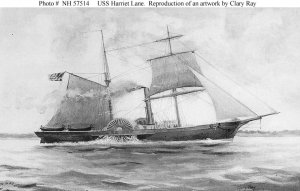
Artist's rendition of USS Harriet Lane
During this time, USS Westfield was grounded on a sandbar. A three-hour truce was called for by Magruder, but Union Fleet Commander William B. Renshaw, ignoring the negotiation offer, attempted to destroy the grounded Westfield with explosives rather than let it fall into enemy hands.
Renshaw and several Union troops were subsequently killed when the explosives were set off too early. Union troops on shore were convinced that their own ships were surrendering and, therefore, laid down their arms. The remaining U.S. ships did not surrender and succeeded in retreating to Union-controlled New Orleans.[
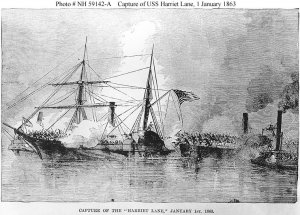
Artist's depiction of the capture of USS Harriet Lane.
Aftermath
The Union blockade around the city of Galveston was lifted temporarily for four days, and Galveston remained the only major port that remained in Confederate hands at the end of the war. The Confederate Congress stated this on the successful recapture of Galveston:
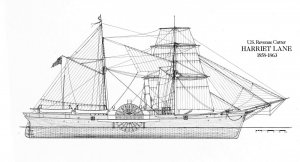
Plans of Harriet Lane
https://en.wikipedia.org/wiki/Battle_of_Galveston
https://en.wikipedia.org/wiki/USS_Westfield_(1861)
https://en.wikipedia.org/wiki/USRC_Harriet_Lane_(1857)
1 January 1863 - The Battle of Galveston was a naval and land battle of the American Civil War,
The Battle of Galveston was a naval and land battle of the American Civil War, when Confederate forces under Major Gen. John B. Magruder expelled occupying Union troops from the city of Galveston, Texas on January 1, 1863.

CS Bayou City captures USS Harriet Lane during the Battle of Galveston
After the loss of the cutter Harriet Lane, the Union Fleet Commander William B. Renshaw blew up the stranded vessel USS Westfield to save it from falling into enemy hands. Union troops on shore thought the fleet was surrendering, and laid down their arms.
The battle is sometimes called the Second Battle of Galveston, as the Battle of Galveston Harbor (October 1862) is sometimes called the First Battle of Galveston.
Battle
Two Confederate cottonclads, CS Bayou City and the CS Neptune commanded by Leon Smith, sailed from Houston to Galveston in an effort to engage the Union Fleet in Galveston Harbor, which consisted of USS Clifton, USS Harriet Lane, USS Westfield, USS Owasco, USS Corypheus and USS Sachem. Outnumbered six to two by the Northern ships, Neptune was severely damaged by the Union Fleet and eventually sank. While Neptune was quickly disabled, Bayou City succeeded in capturing USS Harriet Lane.

Artist's rendition of USS Harriet Lane
During this time, USS Westfield was grounded on a sandbar. A three-hour truce was called for by Magruder, but Union Fleet Commander William B. Renshaw, ignoring the negotiation offer, attempted to destroy the grounded Westfield with explosives rather than let it fall into enemy hands.
Renshaw and several Union troops were subsequently killed when the explosives were set off too early. Union troops on shore were convinced that their own ships were surrendering and, therefore, laid down their arms. The remaining U.S. ships did not surrender and succeeded in retreating to Union-controlled New Orleans.[

Artist's depiction of the capture of USS Harriet Lane.
Aftermath
The Union blockade around the city of Galveston was lifted temporarily for four days, and Galveston remained the only major port that remained in Confederate hands at the end of the war. The Confederate Congress stated this on the successful recapture of Galveston:
The bold, intrepid, and gallant conduct of Maj. Gen. J. Bankhead Magruder, Col. Thomas Green, Maj. Leon Smith and other officers, and of the Texan Rangers and soldiers engaged in the attack on, and victory achieved over, the land and naval forces of the enemy at Galveston, on the 1st of January, 1863, eminently entitle them to the thanks of Congress and the country... This brilliant achievement, resulting, under the providence of God, in the capture of the war steamer Harriet Lane and the defeat and ignominious flight of the hostile fleet from the harbor, the recapture of the city and the raising of the blockade of the port of Galveston, signally evinces that superior force may be overcome by skillful conception and daring courage.

Plans of Harriet Lane
https://en.wikipedia.org/wiki/Battle_of_Galveston
https://en.wikipedia.org/wiki/USS_Westfield_(1861)
https://en.wikipedia.org/wiki/USRC_Harriet_Lane_(1857)
Today in Naval History - Naval / Maritime Events in History
1 January 1908 - The british schooner Nimrod left under command of Ernest Shackleton the harbor of Lyttelton. for the Nimrod-expedition to find the the magnetic South Pole
The Nimrod Expedition of 1907–09, otherwise known as the British Antarctic Expedition, was the first of three expeditions to the Antarctic led by Ernest Shackleton. Its main target, among a range of geographical and scientific objectives, was to be first to the South Pole. This was not attained, but the expedition's southern march reached a Farthest South latitude of 88° 23' S, just 97.5 nautical miles (180.6 km; 112.2 mi) from the pole. This was by far the longest southern polar journey to that date and a record convergence on either Pole.[a] A separate group led by Welsh Australian geology professor Edgeworth David reached the estimated location of the South Magnetic Pole, and the expedition also achieved the first ascent of Mount Erebus, Antarctica's second highest volcano.
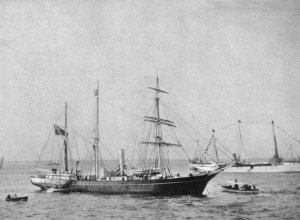
The expedition's ship Nimrod departing for the South Pole
The expedition lacked governmental or institutional support, and relied on private loans and individual contributions. It was beset by financial problems and its preparations were hurried. Its ship, Nimrod, was less than half of the size of Robert Falcon Scott's 1901–04 expedition ship Discovery, and Shackleton's crew lacked relevant experience. Controversy arose from Shackleton's decision to base the expedition in McMurdo Sound, close to Scott's old headquarters, in contravention of a promise to Scott that he would not do so. Nevertheless, although the expedition's profile was initially much lower than that of Scott's six years earlier, its achievements attracted nationwide interest and made Shackleton a public hero. The scientific team, which included the future Australasian Antarctic Expedition leader Douglas Mawson, carried out extensive geological, zoological and meteorological work. Shackleton's transport arrangements, based on Manchurian ponies, motor traction, and sled dogs, were innovations which, despite limited success, were later copied by Scott for his ill-fated Terra Nova Expedition.
On his return, Shackleton overcame the Royal Geographical Society's initial scepticism about his achievements and received many public honours, including a knighthood from King Edward VII. He made little financial gain from the expedition and eventually depended on a government grant to cover its liabilities. Within three years his southernmost record had been surpassed, as first Amundsen and then Scott reached the South Pole. In his own moment of triumph, Amundsen nevertheless observed: "Sir Ernest Shackleton's name will always be written in the annals of Antarctic exploration in letters of fire".
Voyage south
After inspection by King Edward VII and Queen Alexandra, Nimrod sailed on 11 August 1907. Shackleton remained behind on expedition business; he and other expedition members followed on a faster ship. The entire complement came together in New Zealand, ready for the ship's departure to Antarctica on New Year's Day, 1908. As a means of conserving fuel, Shackleton had arranged with the New Zealand government for Nimrod to be towed to the Antarctic circle, a distance of approximately 1,400 nautical miles (2,600 km; 1,600 mi), the costs of the tow being met partly by the government and partly by the Union Steam Ship Company as a contribution to the expedition. On 14 January, in sight of the first icebergs, the towline was cut; Nimrod, under her own power, proceeded southward into the floating pack ice, heading for the Barrier Inlet where six years earlier Discovery had paused to allow Scott and Shackleton to take experimental balloon flights.
The Barrier (later known as the Ross Ice Shelf) was sighted on 23 January, but the inlet had disappeared; the Barrier edge had changed significantly in the intervening years, and the section which had included the inlet had broken away to form a considerable bay, which Shackleton named the Bay of Whales after the large number of whales seen there. Shackleton was not prepared to risk wintering on a Barrier surface that might calve into the sea, so he turned the ship towards King Edward VII Land. After repeated efforts to approach this coast had failed, and with rapidly moving ice threatening to trap the ship, Nimrod was forced to retreat. Shackleton's only choice now, other than abandonment of the expedition's goals, was to break the promise he had given to Scott. On 25 January he ordered the ship to head for McMurdo Sound
...... Read more about the Expedition on wikipedia ........
Nimrod was the ship Ernest Shackleton used in his 1908 Antarctic Nimrod Expedition for the South Pole. It was a 41-year-old schooner of 334 gross register tons that had been used to hunt seals and whales. Shackleton, who paid £5,000 for the ship, had it re-rigged as a barquentine. It also had an auxiliary steam engine, but had a top speed of only six knots under this power. In addition, the ship was so overloaded with supplies for the expedition that it could not carry enough coal to make passage to the Antarctic from New Zealand, and Shackleton had to arrange for the ship to be towed to the edge of the pack ice by tramp steamer Koonya. The New Zealand government paid half the cost of the tow; Sir James Mills, Chairman of the Union Steamship Company, paid the other half. The Koonya was captained by Fredrick Pryce Evans during the tow.
Tonnage: 334 GRT
Propulsion: Sails, auxiliary steam engine
Sail plan: Originally schooner, rebuilt as barquentine
Speed: 6 knots (11 km/h) under steam
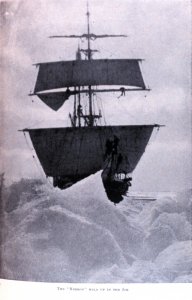
"The Nimrod Held Up in the Ice".
Nimrod was initially captained by Rupert England, but Shackleton was dissatisfied with him and replaced him with Frederick Pryce Evans, who commanded the ship on the relief voyage in 1909. Nimrod was sold on Shackleton's return to Great Britain.
Nimrod's fate, 10 years after its return from the Antarctic, was to be battered to pieces in the North Sea, after running aground on the Barber Sands off the Norfolk coast on 31 January 1919. Only two of her 12-person crew survived.
A number of geographic features of Antarctica were named after the ship, including Nimrod Glacier.
https://en.wikipedia.org/wiki/Nimrod_(ship)
https://en.wikipedia.org/wiki/Nimrod_Expedition
1 January 1908 - The british schooner Nimrod left under command of Ernest Shackleton the harbor of Lyttelton. for the Nimrod-expedition to find the the magnetic South Pole
The Nimrod Expedition of 1907–09, otherwise known as the British Antarctic Expedition, was the first of three expeditions to the Antarctic led by Ernest Shackleton. Its main target, among a range of geographical and scientific objectives, was to be first to the South Pole. This was not attained, but the expedition's southern march reached a Farthest South latitude of 88° 23' S, just 97.5 nautical miles (180.6 km; 112.2 mi) from the pole. This was by far the longest southern polar journey to that date and a record convergence on either Pole.[a] A separate group led by Welsh Australian geology professor Edgeworth David reached the estimated location of the South Magnetic Pole, and the expedition also achieved the first ascent of Mount Erebus, Antarctica's second highest volcano.

The expedition's ship Nimrod departing for the South Pole
The expedition lacked governmental or institutional support, and relied on private loans and individual contributions. It was beset by financial problems and its preparations were hurried. Its ship, Nimrod, was less than half of the size of Robert Falcon Scott's 1901–04 expedition ship Discovery, and Shackleton's crew lacked relevant experience. Controversy arose from Shackleton's decision to base the expedition in McMurdo Sound, close to Scott's old headquarters, in contravention of a promise to Scott that he would not do so. Nevertheless, although the expedition's profile was initially much lower than that of Scott's six years earlier, its achievements attracted nationwide interest and made Shackleton a public hero. The scientific team, which included the future Australasian Antarctic Expedition leader Douglas Mawson, carried out extensive geological, zoological and meteorological work. Shackleton's transport arrangements, based on Manchurian ponies, motor traction, and sled dogs, were innovations which, despite limited success, were later copied by Scott for his ill-fated Terra Nova Expedition.
On his return, Shackleton overcame the Royal Geographical Society's initial scepticism about his achievements and received many public honours, including a knighthood from King Edward VII. He made little financial gain from the expedition and eventually depended on a government grant to cover its liabilities. Within three years his southernmost record had been surpassed, as first Amundsen and then Scott reached the South Pole. In his own moment of triumph, Amundsen nevertheless observed: "Sir Ernest Shackleton's name will always be written in the annals of Antarctic exploration in letters of fire".
Voyage south
After inspection by King Edward VII and Queen Alexandra, Nimrod sailed on 11 August 1907. Shackleton remained behind on expedition business; he and other expedition members followed on a faster ship. The entire complement came together in New Zealand, ready for the ship's departure to Antarctica on New Year's Day, 1908. As a means of conserving fuel, Shackleton had arranged with the New Zealand government for Nimrod to be towed to the Antarctic circle, a distance of approximately 1,400 nautical miles (2,600 km; 1,600 mi), the costs of the tow being met partly by the government and partly by the Union Steam Ship Company as a contribution to the expedition. On 14 January, in sight of the first icebergs, the towline was cut; Nimrod, under her own power, proceeded southward into the floating pack ice, heading for the Barrier Inlet where six years earlier Discovery had paused to allow Scott and Shackleton to take experimental balloon flights.
The Barrier (later known as the Ross Ice Shelf) was sighted on 23 January, but the inlet had disappeared; the Barrier edge had changed significantly in the intervening years, and the section which had included the inlet had broken away to form a considerable bay, which Shackleton named the Bay of Whales after the large number of whales seen there. Shackleton was not prepared to risk wintering on a Barrier surface that might calve into the sea, so he turned the ship towards King Edward VII Land. After repeated efforts to approach this coast had failed, and with rapidly moving ice threatening to trap the ship, Nimrod was forced to retreat. Shackleton's only choice now, other than abandonment of the expedition's goals, was to break the promise he had given to Scott. On 25 January he ordered the ship to head for McMurdo Sound
...... Read more about the Expedition on wikipedia ........
Nimrod was the ship Ernest Shackleton used in his 1908 Antarctic Nimrod Expedition for the South Pole. It was a 41-year-old schooner of 334 gross register tons that had been used to hunt seals and whales. Shackleton, who paid £5,000 for the ship, had it re-rigged as a barquentine. It also had an auxiliary steam engine, but had a top speed of only six knots under this power. In addition, the ship was so overloaded with supplies for the expedition that it could not carry enough coal to make passage to the Antarctic from New Zealand, and Shackleton had to arrange for the ship to be towed to the edge of the pack ice by tramp steamer Koonya. The New Zealand government paid half the cost of the tow; Sir James Mills, Chairman of the Union Steamship Company, paid the other half. The Koonya was captained by Fredrick Pryce Evans during the tow.
Tonnage: 334 GRT
Propulsion: Sails, auxiliary steam engine
Sail plan: Originally schooner, rebuilt as barquentine
Speed: 6 knots (11 km/h) under steam

"The Nimrod Held Up in the Ice".
Nimrod was initially captained by Rupert England, but Shackleton was dissatisfied with him and replaced him with Frederick Pryce Evans, who commanded the ship on the relief voyage in 1909. Nimrod was sold on Shackleton's return to Great Britain.
Nimrod's fate, 10 years after its return from the Antarctic, was to be battered to pieces in the North Sea, after running aground on the Barber Sands off the Norfolk coast on 31 January 1919. Only two of her 12-person crew survived.
A number of geographic features of Antarctica were named after the ship, including Nimrod Glacier.
https://en.wikipedia.org/wiki/Nimrod_(ship)
https://en.wikipedia.org/wiki/Nimrod_Expedition
Today in Naval History - Naval / Maritime Events in History
1 January 1915 - HMS Formidable, lead ship of her class of pre-dreadnought battleships, was torpedoed by german U-24 and sunk
HMS Formidable, the third of four ships of that name to serve in the Royal Navy, was the lead ship of her class of pre-dreadnought battleships. The ship was laid down in March 1898, was launched in November that year, and was completed in September 1901. Formidable served initially with the Mediterranean Fleet, transferring to the Channel Fleet in 1908. In 1912, she was assigned to the 5th Battle Squadron, which was stationed at Nore.
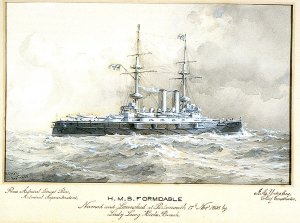
Painting of HMS Formidable, Sept. 1898
Following the outbreak of World War I in August 1914, the squadron conducted operations in the English Channel, and was based at Sheerness to guard against a possible German invasion. In the first days of the war, the 5th Battle Squadron covered the crossing of the British Expeditionary Force to France. On 31 December, the squadron was conducting training exercises in the English Channel, and despite the risk of German submarines, was without anti-submarine protection; the German U-24 stalked the ships during the day and in the early hours of 1 January 1915, torpedoed Formidable twice, sinking her with very heavy loss of life.
Design
Main article: Formidable-class battleship
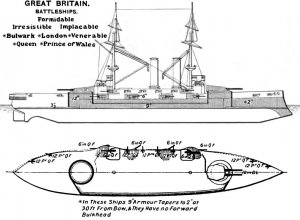
Line-drawing of the Formidable class
The design for the Formidable class was prepared in 1897; it was an incremental improvement over the preceding Majestic and Canopusclasses. Formidable adopted the larger size of the Majestics, while taking the stronger Krupp armour of the Canopus design. In addition, the new design incorporated longer (and thus more powerful) main and secondary guns and an improved hull form. These characteristics produced a ship with better armour protection than either earlier class, the same high speed of Canopus.
Formidable was 431 feet 9 inches (131.6 m) long overall, with a beam of 75 ft (22.9 m) and a draught of 25 ft 11 in (7.90 m). She displaced14,500 tonnes (14,300 long tons) normally and up to 15,800 tonnes (15,600 long tons) fully loaded. Her crew numbered 780 officers and ratings. The Formidable-class ships were powered by a pair of 3-cylinder triple-expansion engines, with steam provided by twenty Belleville boilers. The boilers were trunked into two funnels located amidships. The Formidable-class ships had a top speed of 18 knots (33 km/h; 21 mph) from 15,000 indicated horsepower (11,000 kW).
Formidable had four 12-inch (305 mm) 40-calibre guns mounted in twin gun turrets fore and aft; these guns were mounted in circular barbettes that allowed all-around loading or elevation. The ships also mounted twelve 6-inch (152 mm) 45-calibre guns mounted in casemates, in addition to ten 12-pounder 3 in (76 mm) gunsand six 3-pounder 47 mm (1.9 in) guns. As was customary for battleships of the period, she was also equipped with four 18-inch (457 mm) torpedo tubes submerged in the hull.
Formidable had an armoured belt that was 9 inches (229 mm) thick; the transverse bulkheads on either end of the belt were 9 to 12 in (229 to 305 mm) thick. Her main battery turrets sides were 8 to 10 in (203 to 254 mm) thick, atop 12 in (305 mm) barbettes, and the casemate battery was protected with 6 in of Krupp steel. Her conning tower had 14 in (356 mm) thick sides as well. She was fitted with two armoured decks, 1 and 3 in (25 and 76 mm) thick, respectively.
Service history
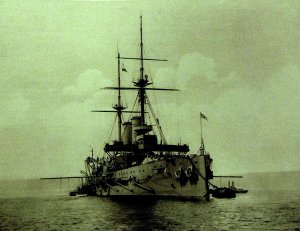
Starboard bow view of Formidable
HMS Formidable was laid down at Portsmouth Dockyard on 21 March 1898 and launched on 17 November 1898; she was, at the time of her launching, very incomplete, and she was launched primarily to clear the slipway so construction could begin on the battleship London. Formidable was completed in September 1901, and was commissioned at Portsmouth on 10 October for service in the Mediterranean Fleet. Captain Alexander William Chisholm-Batten paid off HMS Resolution on 9 October and he and his crew turned over to Formidable on the following day. In September 1902 she visited the Aegean sea with other ships of the station for combined manoeuvres near Nauplia,[4] and the following year she was escort ship to the royal yacht HMY Victoria and Albert when the King visited the Mediterranean. She began a refit at Malta in 1904 which lasted until April 1905, and in April 1908 transferred to the Channel Fleet.
Paid off at Chatham Dockyard on 17 August 1908, Formidable began another refit and recommissioned on 20 April 1909 for service in the 1st Division, Home Fleet, stationed at the Nore. On 29 May, she transferred to the Atlantic Fleet. In May 1912, Formidable was reduced to a nucleus crew and transferred to the 5th Battle Squadron in the Second Fleet, Home Fleet, again at the Nore, where she served until the outbreak of war in August 1914. Hard steaming during this service led to her developing serious machinery problems.
World War I
At the beginning of the First World War, Formidable and the 5th Battle Squadron were based at Portland and assigned to the Channel Fleet to defend the English Channel. After covering the safe transportation of the British Expeditionary Force to France in August 1914, Formidable took part in the transportation of the Portsmouth Marine Battalion to Ostend on 25 August. On 14 November, Formidable and the other ships of the 5th Battle Squadron were rebased at Sheerness because of concern that a German invasion of Great Britain was in the offing. The squadron was relieved by Duncan-class battleships of the 6th Battle Squadron and transferred to Portland on 30 December.
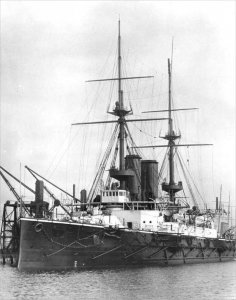
Loss
Under the command of Vice-Admiral Commanding, Channel Fleet, Sir Lewis Bayly, the 5th Battle Squadron spent 31 December participating in gunnery exercises off the Isle of Portland, supported by the light cruisers Topaze and Diamond. The squadron received no escort of destroyers for the operation. After the exercises, that night the fleet remained at sea on patrol even though submarine activity had been reported in the area. Visibility that night was good, though the sea was rough enough to make detection of a submarine difficult. Bayly suspected no danger from submarines, and so steamed his ships in line ahead formation at a speed of 10 knots (19 km/h; 12 mph). Formidable was the last battleship in the line, followed only by the two cruisers. Unknown to the British, the German submarine U-24 stalked the squadron while it was exercising all afternoon, trying to find a suitable attack position.
At around 02:20 on 1 January 1915, U-24 launched a torpedo at Formidable, striking her on the starboard side abreast of the forward funnel. Formidable's commander, Captain Loxley, hoped to save the ship by bringing her close to shore; the other British ships were at that point unaware of what had happened, but after Formidable turned out of line, Topaze increased speed to determine what she was doing. By the time Topaze closed with Formidable twenty minutes later, the latter vessel had already taken on a list of 20 degrees to starboard, and Loxley had issued the order to abandon ship. Men attempting to save the vessel remained aboard and through counter-flooding reduced the list, though Formidable was by then very low in the water.
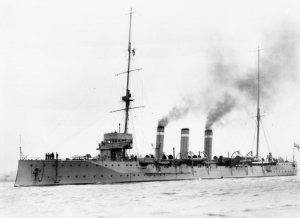
Topaze
At around 03:05, U-24 launched another torpedo at the stricken Formidable, hitting her again on the starboard side close to her bow. Topaze, joined by Diamond, began the rescue effort, but the heavy seas made it very difficult to bring men aboard. Formidable remained afloat for another hour and forty minutes, and at 04:45 began to capsize and sink by the bow. She remained afloat, with her stern in the air, for a few minutes before sinking. Loxley was last seen on the bridge calmly overseeing the evacuation of the ship. Diamond picked up thirty-seven officers and crew from the water. The Brixham trawler Provident picked up 73 members of Formidable's crew from the battleship's launch at around midday, while Formidable's pinnace managed to reach Lyme Regis after 22 hours at sea, saving another 47 men. A total of 35 officers and 512 men were killed in the sinking.
An inquiry from the Admiralty into the sinking determined that the risk of conducting training exercises in the Channel without destroyer protection was excessive and should not be continued. Bayly was relieved of command for failing to take adequate precautions against submarine attack.
Wreck site
Formidable's wreck site is designated as a controlled site under the Protection of Military Remains Act 1986.
SM U-24 was one of 329 submarines serving in the Imperial German Navy in World War I. She was engaged in commerce warfare during the First Battle of the Atlantic.
In seven patrols, U-24 sank a total of 34 ships totalling 106,103 GRT, damaged three more for 14,318 tons, and took one prize of 1,925 tons.
Her second kill was the most significant. The victim was HMS Formidable, torpedoed 30 nautical miles (56 km; 35 mi) south of Lyme Regis, at 50°13′N 03°04′W. She was hit in the number one boiler room on the port side. Out of a crew of approximately 711 men, 547 died as a result. This was one of the largest ships sunk by U-boats during the war.
In 1915, U-24 claimed another noted victim, the passenger steamer Arabic, causing 44 deaths, including three Americans. Arabic sank in 10 minutes. This escalated the U-boat fear in the U.S. and caused a diplomatic incident which resulted in the suspension of torpedoing non-military ships without notice.
https://en.wikipedia.org/wiki/HMS_Formidable_(1898)
https://en.wikipedia.org/wiki/SM_U-24
1 January 1915 - HMS Formidable, lead ship of her class of pre-dreadnought battleships, was torpedoed by german U-24 and sunk
HMS Formidable, the third of four ships of that name to serve in the Royal Navy, was the lead ship of her class of pre-dreadnought battleships. The ship was laid down in March 1898, was launched in November that year, and was completed in September 1901. Formidable served initially with the Mediterranean Fleet, transferring to the Channel Fleet in 1908. In 1912, she was assigned to the 5th Battle Squadron, which was stationed at Nore.

Painting of HMS Formidable, Sept. 1898
Following the outbreak of World War I in August 1914, the squadron conducted operations in the English Channel, and was based at Sheerness to guard against a possible German invasion. In the first days of the war, the 5th Battle Squadron covered the crossing of the British Expeditionary Force to France. On 31 December, the squadron was conducting training exercises in the English Channel, and despite the risk of German submarines, was without anti-submarine protection; the German U-24 stalked the ships during the day and in the early hours of 1 January 1915, torpedoed Formidable twice, sinking her with very heavy loss of life.
Design
Main article: Formidable-class battleship

Line-drawing of the Formidable class
The design for the Formidable class was prepared in 1897; it was an incremental improvement over the preceding Majestic and Canopusclasses. Formidable adopted the larger size of the Majestics, while taking the stronger Krupp armour of the Canopus design. In addition, the new design incorporated longer (and thus more powerful) main and secondary guns and an improved hull form. These characteristics produced a ship with better armour protection than either earlier class, the same high speed of Canopus.
Formidable was 431 feet 9 inches (131.6 m) long overall, with a beam of 75 ft (22.9 m) and a draught of 25 ft 11 in (7.90 m). She displaced14,500 tonnes (14,300 long tons) normally and up to 15,800 tonnes (15,600 long tons) fully loaded. Her crew numbered 780 officers and ratings. The Formidable-class ships were powered by a pair of 3-cylinder triple-expansion engines, with steam provided by twenty Belleville boilers. The boilers were trunked into two funnels located amidships. The Formidable-class ships had a top speed of 18 knots (33 km/h; 21 mph) from 15,000 indicated horsepower (11,000 kW).
Formidable had four 12-inch (305 mm) 40-calibre guns mounted in twin gun turrets fore and aft; these guns were mounted in circular barbettes that allowed all-around loading or elevation. The ships also mounted twelve 6-inch (152 mm) 45-calibre guns mounted in casemates, in addition to ten 12-pounder 3 in (76 mm) gunsand six 3-pounder 47 mm (1.9 in) guns. As was customary for battleships of the period, she was also equipped with four 18-inch (457 mm) torpedo tubes submerged in the hull.
Formidable had an armoured belt that was 9 inches (229 mm) thick; the transverse bulkheads on either end of the belt were 9 to 12 in (229 to 305 mm) thick. Her main battery turrets sides were 8 to 10 in (203 to 254 mm) thick, atop 12 in (305 mm) barbettes, and the casemate battery was protected with 6 in of Krupp steel. Her conning tower had 14 in (356 mm) thick sides as well. She was fitted with two armoured decks, 1 and 3 in (25 and 76 mm) thick, respectively.
Service history

Starboard bow view of Formidable
HMS Formidable was laid down at Portsmouth Dockyard on 21 March 1898 and launched on 17 November 1898; she was, at the time of her launching, very incomplete, and she was launched primarily to clear the slipway so construction could begin on the battleship London. Formidable was completed in September 1901, and was commissioned at Portsmouth on 10 October for service in the Mediterranean Fleet. Captain Alexander William Chisholm-Batten paid off HMS Resolution on 9 October and he and his crew turned over to Formidable on the following day. In September 1902 she visited the Aegean sea with other ships of the station for combined manoeuvres near Nauplia,[4] and the following year she was escort ship to the royal yacht HMY Victoria and Albert when the King visited the Mediterranean. She began a refit at Malta in 1904 which lasted until April 1905, and in April 1908 transferred to the Channel Fleet.
Paid off at Chatham Dockyard on 17 August 1908, Formidable began another refit and recommissioned on 20 April 1909 for service in the 1st Division, Home Fleet, stationed at the Nore. On 29 May, she transferred to the Atlantic Fleet. In May 1912, Formidable was reduced to a nucleus crew and transferred to the 5th Battle Squadron in the Second Fleet, Home Fleet, again at the Nore, where she served until the outbreak of war in August 1914. Hard steaming during this service led to her developing serious machinery problems.
World War I
At the beginning of the First World War, Formidable and the 5th Battle Squadron were based at Portland and assigned to the Channel Fleet to defend the English Channel. After covering the safe transportation of the British Expeditionary Force to France in August 1914, Formidable took part in the transportation of the Portsmouth Marine Battalion to Ostend on 25 August. On 14 November, Formidable and the other ships of the 5th Battle Squadron were rebased at Sheerness because of concern that a German invasion of Great Britain was in the offing. The squadron was relieved by Duncan-class battleships of the 6th Battle Squadron and transferred to Portland on 30 December.

Loss
Under the command of Vice-Admiral Commanding, Channel Fleet, Sir Lewis Bayly, the 5th Battle Squadron spent 31 December participating in gunnery exercises off the Isle of Portland, supported by the light cruisers Topaze and Diamond. The squadron received no escort of destroyers for the operation. After the exercises, that night the fleet remained at sea on patrol even though submarine activity had been reported in the area. Visibility that night was good, though the sea was rough enough to make detection of a submarine difficult. Bayly suspected no danger from submarines, and so steamed his ships in line ahead formation at a speed of 10 knots (19 km/h; 12 mph). Formidable was the last battleship in the line, followed only by the two cruisers. Unknown to the British, the German submarine U-24 stalked the squadron while it was exercising all afternoon, trying to find a suitable attack position.
At around 02:20 on 1 January 1915, U-24 launched a torpedo at Formidable, striking her on the starboard side abreast of the forward funnel. Formidable's commander, Captain Loxley, hoped to save the ship by bringing her close to shore; the other British ships were at that point unaware of what had happened, but after Formidable turned out of line, Topaze increased speed to determine what she was doing. By the time Topaze closed with Formidable twenty minutes later, the latter vessel had already taken on a list of 20 degrees to starboard, and Loxley had issued the order to abandon ship. Men attempting to save the vessel remained aboard and through counter-flooding reduced the list, though Formidable was by then very low in the water.

Topaze
At around 03:05, U-24 launched another torpedo at the stricken Formidable, hitting her again on the starboard side close to her bow. Topaze, joined by Diamond, began the rescue effort, but the heavy seas made it very difficult to bring men aboard. Formidable remained afloat for another hour and forty minutes, and at 04:45 began to capsize and sink by the bow. She remained afloat, with her stern in the air, for a few minutes before sinking. Loxley was last seen on the bridge calmly overseeing the evacuation of the ship. Diamond picked up thirty-seven officers and crew from the water. The Brixham trawler Provident picked up 73 members of Formidable's crew from the battleship's launch at around midday, while Formidable's pinnace managed to reach Lyme Regis after 22 hours at sea, saving another 47 men. A total of 35 officers and 512 men were killed in the sinking.
An inquiry from the Admiralty into the sinking determined that the risk of conducting training exercises in the Channel without destroyer protection was excessive and should not be continued. Bayly was relieved of command for failing to take adequate precautions against submarine attack.
Wreck site
Formidable's wreck site is designated as a controlled site under the Protection of Military Remains Act 1986.
SM U-24 was one of 329 submarines serving in the Imperial German Navy in World War I. She was engaged in commerce warfare during the First Battle of the Atlantic.
In seven patrols, U-24 sank a total of 34 ships totalling 106,103 GRT, damaged three more for 14,318 tons, and took one prize of 1,925 tons.
Her second kill was the most significant. The victim was HMS Formidable, torpedoed 30 nautical miles (56 km; 35 mi) south of Lyme Regis, at 50°13′N 03°04′W. She was hit in the number one boiler room on the port side. Out of a crew of approximately 711 men, 547 died as a result. This was one of the largest ships sunk by U-boats during the war.
In 1915, U-24 claimed another noted victim, the passenger steamer Arabic, causing 44 deaths, including three Americans. Arabic sank in 10 minutes. This escalated the U-boat fear in the U.S. and caused a diplomatic incident which resulted in the suspension of torpedoing non-military ships without notice.
https://en.wikipedia.org/wiki/HMS_Formidable_(1898)
https://en.wikipedia.org/wiki/SM_U-24
Today in Naval History - Naval / Maritime Events in History
1 January 1917 - SS Ivernia, a British ocean liner owned by the Cunard Line, torpedoed and sunk
SS Ivernia was a British ocean liner owned by the Cunard Line, built by the company Swan Hunter & Wigham Richardson of Newcastle upon Tyne, England, and launched in 1899. The Ivernia was one of Cunard's intermediate ships, that catered to the vast immigrant trade. Together with her sister ship RMS Saxonia, the Ivernia worked on Cunard's service from Liverpool to Boston and then later on the immigrant run the Cunard Line had established from Fiume and Trieste to New York City.
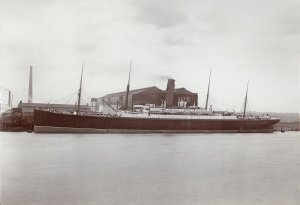
Cunard Liner Ivernia
Following the outbreak of World War I in August 1914 the Ivernia was hired by the British government as a troop transport. In autumn of 1916, William Thomas Turner (made famous for being the captain of RMS Lusitania at the time of her sinking) was given command.
On 1 January 1917, the Ivernia was carrying some 2,400 British troops from Marseille to Alexandria, when at 10:12am she was torpedoed by the German submarine UB-47 58 miles south-east of Cape Matapan in Greece, in the Kythira Strait. The ship went down fairly quickly with a loss of 36 crew members and 84 troops. Captain Turner, who had been criticised for not going down with the Lusitania (even though he had believed he was the last person on board), remained on the bridge until all aboard had departed in lifeboats and rafts "before striking out to swim as the vessel went down under his feet."
HMS Rifleman rescued a number of survivors and armed trawlers towed the bulk, who had taken to lifeboats, to Suda Bay in Crete.
Today Ivernia Road in Walton in Liverpool still bears the name of the doomed vessel.

SM UB-47 was a Type UB II submarine or U-boat for the German Imperial Navy (German: Kaiserliche Marine) during World War I. UB-47 was sold to the Austro-Hungarian Navy(German: Kaiserliche und Königliche Kriegsmarine or K.u.K. Kriegsmarine) during the war. In Austro-Hungarian service the B was dropped from her name and she was known as SM U-47 or U-XLVII as a member of the Austro-Hungarian U-43 class.
UB-47 was ordered in July 1915 and was laid down at the AG Weser shipyard in Bremen in September. UB-47 was a little more than 121 feet (37 m) in length and displaced between 270 and 305 tonnes (266 and 300 long tons), depending on whether surfaced or submerged. She was equipped to carry a complement of four torpedoes for her two bow torpedo tubesand had an 8.8-centimeter (3.5 in) deck gun. As part of a group of six submarines selected for Mediterranean service, UB-47 was broken into railcar sized components and shipped to Pola where she was assembled and launched in June 1916, and commissioned in July. Over the next year the U-boat sank twenty ships, which included the French battleship Gaulois and two Cunard Line steamers in use as troopships, Franconia and Ivernia.
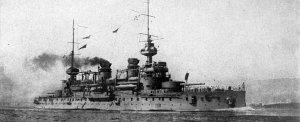
French battleship Gaulois
The German Imperial Navy was having difficulties in finding trained submarine crews and offered to sell UB-47 and a sister boat UB-43 to the Austro-Hungarian Navy. After the terms were agreed to in June 1917, both boats were handed over at Pola. When commissioned into the Austro-Hungarian Navy, the B in her designation was dropped so that she became U-47 or U-XLVII. She sank an additional three ships in Austro-Hungarian service through the end of the war. U-47 was ceded to France as a war reparation in 1920 and broken at Bizerta that same year.
https://en.wikipedia.org/wiki/SS_Ivernia
https://en.wikipedia.org/wiki/SM_UB-47
1 January 1917 - SS Ivernia, a British ocean liner owned by the Cunard Line, torpedoed and sunk
SS Ivernia was a British ocean liner owned by the Cunard Line, built by the company Swan Hunter & Wigham Richardson of Newcastle upon Tyne, England, and launched in 1899. The Ivernia was one of Cunard's intermediate ships, that catered to the vast immigrant trade. Together with her sister ship RMS Saxonia, the Ivernia worked on Cunard's service from Liverpool to Boston and then later on the immigrant run the Cunard Line had established from Fiume and Trieste to New York City.

Cunard Liner Ivernia
Following the outbreak of World War I in August 1914 the Ivernia was hired by the British government as a troop transport. In autumn of 1916, William Thomas Turner (made famous for being the captain of RMS Lusitania at the time of her sinking) was given command.
On 1 January 1917, the Ivernia was carrying some 2,400 British troops from Marseille to Alexandria, when at 10:12am she was torpedoed by the German submarine UB-47 58 miles south-east of Cape Matapan in Greece, in the Kythira Strait. The ship went down fairly quickly with a loss of 36 crew members and 84 troops. Captain Turner, who had been criticised for not going down with the Lusitania (even though he had believed he was the last person on board), remained on the bridge until all aboard had departed in lifeboats and rafts "before striking out to swim as the vessel went down under his feet."
HMS Rifleman rescued a number of survivors and armed trawlers towed the bulk, who had taken to lifeboats, to Suda Bay in Crete.
Today Ivernia Road in Walton in Liverpool still bears the name of the doomed vessel.

SM UB-47 was a Type UB II submarine or U-boat for the German Imperial Navy (German: Kaiserliche Marine) during World War I. UB-47 was sold to the Austro-Hungarian Navy(German: Kaiserliche und Königliche Kriegsmarine or K.u.K. Kriegsmarine) during the war. In Austro-Hungarian service the B was dropped from her name and she was known as SM U-47 or U-XLVII as a member of the Austro-Hungarian U-43 class.
UB-47 was ordered in July 1915 and was laid down at the AG Weser shipyard in Bremen in September. UB-47 was a little more than 121 feet (37 m) in length and displaced between 270 and 305 tonnes (266 and 300 long tons), depending on whether surfaced or submerged. She was equipped to carry a complement of four torpedoes for her two bow torpedo tubesand had an 8.8-centimeter (3.5 in) deck gun. As part of a group of six submarines selected for Mediterranean service, UB-47 was broken into railcar sized components and shipped to Pola where she was assembled and launched in June 1916, and commissioned in July. Over the next year the U-boat sank twenty ships, which included the French battleship Gaulois and two Cunard Line steamers in use as troopships, Franconia and Ivernia.

French battleship Gaulois
The German Imperial Navy was having difficulties in finding trained submarine crews and offered to sell UB-47 and a sister boat UB-43 to the Austro-Hungarian Navy. After the terms were agreed to in June 1917, both boats were handed over at Pola. When commissioned into the Austro-Hungarian Navy, the B in her designation was dropped so that she became U-47 or U-XLVII. She sank an additional three ships in Austro-Hungarian service through the end of the war. U-47 was ceded to France as a war reparation in 1920 and broken at Bizerta that same year.
https://en.wikipedia.org/wiki/SS_Ivernia
https://en.wikipedia.org/wiki/SM_UB-47
Today in Naval History - Naval / Maritime Events in History
1 January 1919 - His Majesty's Yacht Iolaire, ex Admiralty yacht Amalthaea of 1881, whose sinking on 1 January 1919 in the Minch -
one of the worst maritime disasters in United Kingdom waters during the 20th century. At least 201 men perished of the 283 aboard.
His Majesty's Yacht Iolaire (Scottish Gaelic for "Eagle") was the Admiralty yacht Amalthaea of 1881, renamed in 1918, whose sinking on 1 January 1919 in the Minch was one of the worst maritime disasters in United Kingdom waters during the 20th century.https://en.wikipedia.org/wiki/HMY_Iolaire#cite_note-2 At least 201 men perished of the 283 aboard.
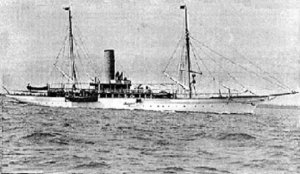
The Admiralty yacht HMS Iolaire under the name Amalthaea. It sank on the morning of 1 January 1919 on the Beasts of Holm, rocks outside Stornoway harbour.
Sinking
Iolaire was carrying sailors who had fought in the First World War back to the Scottish island of Lewis in the Outer Hebrides. She left the port of Kyle of Lochalsh on the mainland late on the evening of 31 December 1918. At 2:30 a.m. on New Year's Day, as the ship approached the port of Stornoway, a few yards offshore and a mile away from the safety of Stornoway Harbour, she hit the infamous rocks "The Beasts of Holm" and sank. Those on board would have been able to see the lights of Stornoway. The death toll was officially put at 205, of whom 181 men were islanders but as the ship was badly overcrowded and there was a lack of proper records, the toll could have been slightly higher. John F. Macleod from Ness, Isle of Lewis, saved 40 lives, swimming ashore with a heaving line, along which many of the survivors made their way to safety. Only 82 of the 283 (officially known) passengers survived the disaster; 71 percent of the people on the yacht perished in the incident. The impact of the disaster was devastating to the Islands; even though the number of those lost was only 205, they represented almost a generation of young men from the Islands.
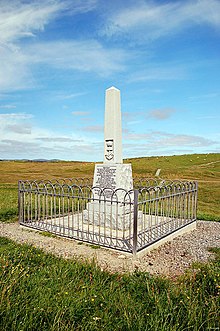
Iolaire memorial
The sailors were wearing their uniforms including heavy boots, which made swimming from the wreck difficult — indeed many men of that time had never had the opportunity to learn. Many songs and poems, such as An Iolaire, describe the women of these men finding their men washed up on the shore the next day. The sinking is the worst maritime disaster (for loss of life) in United Kingdom waters in peacetime, since the wreck of the SS Norge off Rockall in 1904 and the worst peacetime disaster involving a British ship since the Titanic on 15 April 1912.
An Admiralty enquiry found no satisfactory explanation for the disaster. Its inconclusive findings generated much ill feeling amongst the Lewis population, amidst accusations of a "whitewash". While drunkenness among the crew was discounted at the enquiry, the vessel was sailing at night, in poor visibility and in deteriorating weather. The entrance to Stornoway harbour is not the most straightforward of navigations and it is possible that navigational error was to blame. This hypothesis appears to be supported by the crew of a fishing vessel who noted that the Iolaire was not navigating the correct course for entering the harbour.
A memorial was erected in 1958 at Holm, outside Stornoway. A stone pillar sticks out of the water at the site of the wreck, which can be seen to starboard as the car ferry approaches the harbour entrance. A national commemorative service was held at the memorial on 1 January 2019 to mark the centenary of the disaster, attended by First Minister of Scotland Nicola Sturgeon and Charles, Prince of Wales.
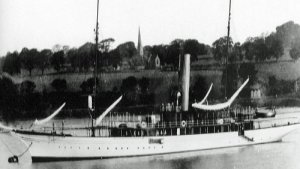
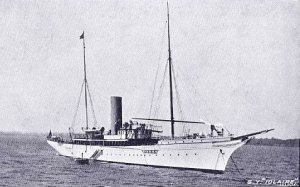
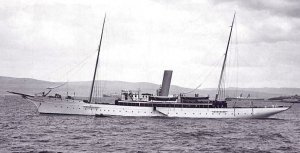
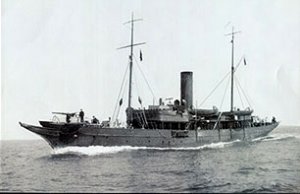
https://en.wikipedia.org/wiki/HMY_Iolaire
1 January 1919 - His Majesty's Yacht Iolaire, ex Admiralty yacht Amalthaea of 1881, whose sinking on 1 January 1919 in the Minch -
one of the worst maritime disasters in United Kingdom waters during the 20th century. At least 201 men perished of the 283 aboard.
His Majesty's Yacht Iolaire (Scottish Gaelic for "Eagle") was the Admiralty yacht Amalthaea of 1881, renamed in 1918, whose sinking on 1 January 1919 in the Minch was one of the worst maritime disasters in United Kingdom waters during the 20th century.https://en.wikipedia.org/wiki/HMY_Iolaire#cite_note-2 At least 201 men perished of the 283 aboard.

The Admiralty yacht HMS Iolaire under the name Amalthaea. It sank on the morning of 1 January 1919 on the Beasts of Holm, rocks outside Stornoway harbour.
Sinking
Iolaire was carrying sailors who had fought in the First World War back to the Scottish island of Lewis in the Outer Hebrides. She left the port of Kyle of Lochalsh on the mainland late on the evening of 31 December 1918. At 2:30 a.m. on New Year's Day, as the ship approached the port of Stornoway, a few yards offshore and a mile away from the safety of Stornoway Harbour, she hit the infamous rocks "The Beasts of Holm" and sank. Those on board would have been able to see the lights of Stornoway. The death toll was officially put at 205, of whom 181 men were islanders but as the ship was badly overcrowded and there was a lack of proper records, the toll could have been slightly higher. John F. Macleod from Ness, Isle of Lewis, saved 40 lives, swimming ashore with a heaving line, along which many of the survivors made their way to safety. Only 82 of the 283 (officially known) passengers survived the disaster; 71 percent of the people on the yacht perished in the incident. The impact of the disaster was devastating to the Islands; even though the number of those lost was only 205, they represented almost a generation of young men from the Islands.

Iolaire memorial
The sailors were wearing their uniforms including heavy boots, which made swimming from the wreck difficult — indeed many men of that time had never had the opportunity to learn. Many songs and poems, such as An Iolaire, describe the women of these men finding their men washed up on the shore the next day. The sinking is the worst maritime disaster (for loss of life) in United Kingdom waters in peacetime, since the wreck of the SS Norge off Rockall in 1904 and the worst peacetime disaster involving a British ship since the Titanic on 15 April 1912.
An Admiralty enquiry found no satisfactory explanation for the disaster. Its inconclusive findings generated much ill feeling amongst the Lewis population, amidst accusations of a "whitewash". While drunkenness among the crew was discounted at the enquiry, the vessel was sailing at night, in poor visibility and in deteriorating weather. The entrance to Stornoway harbour is not the most straightforward of navigations and it is possible that navigational error was to blame. This hypothesis appears to be supported by the crew of a fishing vessel who noted that the Iolaire was not navigating the correct course for entering the harbour.
A memorial was erected in 1958 at Holm, outside Stornoway. A stone pillar sticks out of the water at the site of the wreck, which can be seen to starboard as the car ferry approaches the harbour entrance. A national commemorative service was held at the memorial on 1 January 2019 to mark the centenary of the disaster, attended by First Minister of Scotland Nicola Sturgeon and Charles, Prince of Wales.




https://en.wikipedia.org/wiki/HMY_Iolaire
Today in Naval History - Naval / Maritime Events in History
1 January 1965 - SS Catala, a Canadian coastal passenger and cargo steamship, wrecked
SS Catala was a Canadian coastal passenger and cargo steamship built for service with the Union Steamship Company of British Columbia
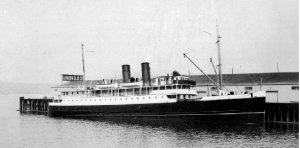
Catala in Vancouver, 1925
Nomenclature
Catala was named after Catala Island, which is at the entrance of Esperanza Inlet on the west coast of Vancouver Island. Catala Island had in turn been named in honour of Catholic missionary Fr. Magin Catalá, who was at Santa Cruz de Nuca on Vancouver Island in 1793.
Design and construction
Catala was built by the Coaster Construction Company of Montrose, Scotland, in 1925. The ship was similar to the Cardena, which was also owned by the Union Steamship Company. Catala was 229 feet long, with a beam of 37.1 feet and depth of hold of 18.4 feet. The ship was licensed to carry 267 passengers, with stateroom capacity for 120 persons and steerage bunks for 48. Catala had a cargo capacity of 300 tons, including a refrigerated chamber for 40 tons of boxed fish.
Catala was launched on February 25, 1925. The ship was delivered from Scotland to Vancouver under Capt. James Findlay, who had brought other steamships out from Scotland for the Union Steamship Company.
Union Steamship career
Under Capt. Andrew Johnstone, Catala began her first voyage for the company on July 28, 1925, steaming north from Vancouver to Prince Rupert and the Skeena and Nass rivers. Like her sister ship, the SS Cardena, Catala spent most of her operating career from 1925–58 on the British Columbia Coast, carrying coastal freight and passengers.
Grounding on Sparrowhawk Reef
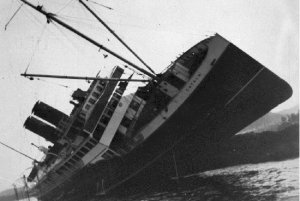
Catala aground on Sparrowhawk Reef, off the coast of British Columbia some time between November 8 and December 5, 1927.
On November 8, 1927, at 1:00 pm, on a south bound trip originating from Stewart, BC, Catala had left Port Simpson bound for Prince Rupert through the southern channel on the inside of Finlayson Island. This channel is called Cunningham Passage.
With Chief Officer Ernest Sheppard on the bridge, the ship struck a Sparrowhawk Reef.[6] Sparrowhawk Reef was reported to have been marked with a warning buoy. Later during an inquiry into the incident, glaring sunlight conditions were found to have had some role in reducing the visibility. Capt. Alfred E. Dickson ordered the lifeboats lowered immediately, and with the aid of local people of the First Nations and their canoes, all passengers were taken off the ship and reached safety at Port Simpson, without loss.
The depth of water over the reef ranged from 23 feet at high tide to only 7 feet at low tide. Catala was held at a 45 degree angle between two pillars of rock. So much of the ship jutted out unsupported in the air that there was a fear the ship might break in two. The ship had been built with a double-bottom, which helped keep the water out of the hold. Efforts by tugs, specifically Salvage Princess, Cape Scott, and, from Vancouver, Salvage King, to bring off the ship failed, even though the ship had been lightened by off-loading cargo into smaller service ship. The company gave up the ship as lost, and abandoned her to the insurance underwriters, who then assumed responsibility for the salvage efforts. The company management did state that they would take the ship back if she could be brought off the reef.
Eventually, by incrementally blasting out the rock pillars, and patching the holes in the hull as blasting proceeded, the salvage crew was able to free the ship by December 5, 1927. The salvors took the ship to a temporary anchorage about a mile away, and thereafter to Prince Rupert. Eventually Catala was brought south to Vancouver, where at a cost of $175,000 the ship was repaired. The repair was supervised by W.D. McLaren, who had been in charge of Coaster Construction in Scotland when Catala had been built there, and had since relocated to Vancouver. On March 30, 1928, Catala resumed her weekly sailing schedule out of Vancouver, again under the command of Capt. Dickson.
Later career
In 1958 she was sold to new owners in British Columbia for use as a fish-buying ship. In Seattle's Century 21 Exposition she was a floating "boatel" moored on the Seattle waterfront. Later in 1962 she was towed to California and used as a floating restaurant. In 1963 she was brought back north to Ocean Shores, Washington and used as a "boatel" again until she was driven aground by a storm on New Year's Day 1965.
Scrapping
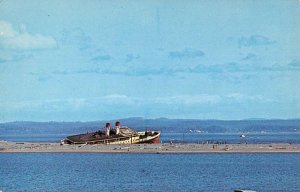
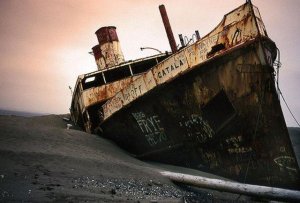
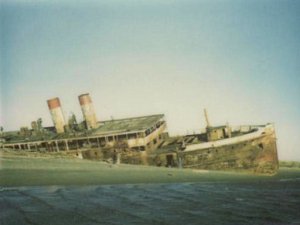
Catala aground in 1976
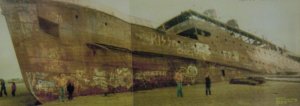
Following her grounding, efforts to re-float Catala failed, and the wreck was left to decay at the beach on Damon Point, Washington. Over the years she was vandalized and pillaged, and in the late 1980s a girl fell through a rusted portion of her deck, breaking her back. Her family sued the State of Washington, which in turn ordered the wreck cut up. Catala was cut down to sand level and buried, until a series of winter storms unburied her in the late 1990s. Subsequent storms gradually exposed more of the hull until in April 2006 a beachcomber noticed that oil was leaking from the wreck. The State of Washington Department of Ecology cordoned off the wreck and removed 34,500 US gallons (131,000 l) of heavy fuel oil before scrapping the rest of the ship. Several endangered bird species nest in the area, including the snowy plover.
https://en.wikipedia.org/wiki/SS_Catala
1 January 1965 - SS Catala, a Canadian coastal passenger and cargo steamship, wrecked
SS Catala was a Canadian coastal passenger and cargo steamship built for service with the Union Steamship Company of British Columbia

Catala in Vancouver, 1925
Nomenclature
Catala was named after Catala Island, which is at the entrance of Esperanza Inlet on the west coast of Vancouver Island. Catala Island had in turn been named in honour of Catholic missionary Fr. Magin Catalá, who was at Santa Cruz de Nuca on Vancouver Island in 1793.
Design and construction
Catala was built by the Coaster Construction Company of Montrose, Scotland, in 1925. The ship was similar to the Cardena, which was also owned by the Union Steamship Company. Catala was 229 feet long, with a beam of 37.1 feet and depth of hold of 18.4 feet. The ship was licensed to carry 267 passengers, with stateroom capacity for 120 persons and steerage bunks for 48. Catala had a cargo capacity of 300 tons, including a refrigerated chamber for 40 tons of boxed fish.
Catala was launched on February 25, 1925. The ship was delivered from Scotland to Vancouver under Capt. James Findlay, who had brought other steamships out from Scotland for the Union Steamship Company.
Union Steamship career
Under Capt. Andrew Johnstone, Catala began her first voyage for the company on July 28, 1925, steaming north from Vancouver to Prince Rupert and the Skeena and Nass rivers. Like her sister ship, the SS Cardena, Catala spent most of her operating career from 1925–58 on the British Columbia Coast, carrying coastal freight and passengers.
Grounding on Sparrowhawk Reef

Catala aground on Sparrowhawk Reef, off the coast of British Columbia some time between November 8 and December 5, 1927.
On November 8, 1927, at 1:00 pm, on a south bound trip originating from Stewart, BC, Catala had left Port Simpson bound for Prince Rupert through the southern channel on the inside of Finlayson Island. This channel is called Cunningham Passage.
With Chief Officer Ernest Sheppard on the bridge, the ship struck a Sparrowhawk Reef.[6] Sparrowhawk Reef was reported to have been marked with a warning buoy. Later during an inquiry into the incident, glaring sunlight conditions were found to have had some role in reducing the visibility. Capt. Alfred E. Dickson ordered the lifeboats lowered immediately, and with the aid of local people of the First Nations and their canoes, all passengers were taken off the ship and reached safety at Port Simpson, without loss.
The depth of water over the reef ranged from 23 feet at high tide to only 7 feet at low tide. Catala was held at a 45 degree angle between two pillars of rock. So much of the ship jutted out unsupported in the air that there was a fear the ship might break in two. The ship had been built with a double-bottom, which helped keep the water out of the hold. Efforts by tugs, specifically Salvage Princess, Cape Scott, and, from Vancouver, Salvage King, to bring off the ship failed, even though the ship had been lightened by off-loading cargo into smaller service ship. The company gave up the ship as lost, and abandoned her to the insurance underwriters, who then assumed responsibility for the salvage efforts. The company management did state that they would take the ship back if she could be brought off the reef.
Eventually, by incrementally blasting out the rock pillars, and patching the holes in the hull as blasting proceeded, the salvage crew was able to free the ship by December 5, 1927. The salvors took the ship to a temporary anchorage about a mile away, and thereafter to Prince Rupert. Eventually Catala was brought south to Vancouver, where at a cost of $175,000 the ship was repaired. The repair was supervised by W.D. McLaren, who had been in charge of Coaster Construction in Scotland when Catala had been built there, and had since relocated to Vancouver. On March 30, 1928, Catala resumed her weekly sailing schedule out of Vancouver, again under the command of Capt. Dickson.
Later career
In 1958 she was sold to new owners in British Columbia for use as a fish-buying ship. In Seattle's Century 21 Exposition she was a floating "boatel" moored on the Seattle waterfront. Later in 1962 she was towed to California and used as a floating restaurant. In 1963 she was brought back north to Ocean Shores, Washington and used as a "boatel" again until she was driven aground by a storm on New Year's Day 1965.
Scrapping



Catala aground in 1976

Following her grounding, efforts to re-float Catala failed, and the wreck was left to decay at the beach on Damon Point, Washington. Over the years she was vandalized and pillaged, and in the late 1980s a girl fell through a rusted portion of her deck, breaking her back. Her family sued the State of Washington, which in turn ordered the wreck cut up. Catala was cut down to sand level and buried, until a series of winter storms unburied her in the late 1990s. Subsequent storms gradually exposed more of the hull until in April 2006 a beachcomber noticed that oil was leaking from the wreck. The State of Washington Department of Ecology cordoned off the wreck and removed 34,500 US gallons (131,000 l) of heavy fuel oil before scrapping the rest of the ship. Several endangered bird species nest in the area, including the snowy plover.
https://en.wikipedia.org/wiki/SS_Catala
Today in Naval History - Naval / Maritime Events in History
Other Events on 1 January
1671 – Launch of French Basque, 36/44 guns, design by Joseph Saboulin, at Bayonne – renamed Brillant in June 1671, then Triton in June 1678; deleted 1694.
1717 – Launch of spanish San Juan Bautista 60 at Pasajes - Wrecked 26 December 1719
1727 – Launch of Spanish San Antonio 60 at Guarnizo - Stricken 1750
1739 – Bouvet Island, the world's remotest island is discovered by French explorer Jean-Baptiste Charles Bouvet de Lozier
Bouvet Island (Norwegian: Bouvetøya) is an uninhabited subantarctic high island and dependency of Norway located in the South Atlantic Ocean at 54°25.8′S 3°22.8′ECoordinates:
 54°25.8′S 3°22.8′E, thus putting it north of and outside the Antarctic Treaty System. It lies at the southern end of the Mid-Atlantic Ridge and is the most remote island in the world, approximately 1,700 kilometres (1,100 mi) north of the Princess Astrid Coast of Queen Maud Land, Antarctica and 2,600 kilometres (1,600 mi) south-southwest of the coast of South Africa.
54°25.8′S 3°22.8′E, thus putting it north of and outside the Antarctic Treaty System. It lies at the southern end of the Mid-Atlantic Ridge and is the most remote island in the world, approximately 1,700 kilometres (1,100 mi) north of the Princess Astrid Coast of Queen Maud Land, Antarctica and 2,600 kilometres (1,600 mi) south-southwest of the coast of South Africa.
The island has an area of 49 square kilometres (19 sq mi), of which 93 percent is covered by a glacier. The centre of the island is an ice-filled crater of an inactive volcano. Some skerries and one smaller island, Larsøya, lie along the coast. Nyrøysa, created by a rock slide in the late 1950s, is the only easy place to land and is the location of a weather station.
The island was first spotted on 1 January 1739 by Frenchman Jean-Baptiste Charles Bouvet de Lozier, after whom it was later named. He recorded inaccurate coordinates and the island was not sighted again until 1808, when the British whaler captain James Lindsay named it Lindsay Island. The first claim of landing, although disputed, was by American sailor Benjamin Morrell. In 1825, the island was claimed for the British Crown by George Norris, who named it Liverpool Island. He also reported Thompson Island as nearby, although this was later shown to be a phantom island. The first Norvegia expedition landed on the island in 1927 and claimed it for Norway. At this time the island was named Bouvet Island, or "Bouvetøya" in Norwegian. After a dispute with the United Kingdom, it was declared a Norwegian dependency in 1930. It became a nature reserve in 1971.
https://en.wikipedia.org/wiki/Bouvet_Island
https://en.wikipedia.org/wiki/Jean-Baptiste_Charles_Bouvet_de_Lozier
1758 - HMS Adventure, Cdr. John Bray, took privateer Machault (14) off Dungerness Road
HMS Adventure (1741) was a fourth rate ship of the line launched in 1741, rebuilt as a 32-gun fifth rate in 1758, and sold in 1770.
1771 - Horatio Nelson reported to the third-rate HMS Raisonnable as an ordinary seaman and coxswain under his maternal uncle, Captain Maurice Suckling, who commanded the vessel.
Nelson attended Paston Grammar School, North Walsham, until he was 12 years old, and also attended King Edward VI’s Grammar School in Norwich. His naval career began on 1 January 1771, when he reported to the third-rate HMS Raisonnable as an ordinary seaman and coxswain under his maternal uncle, Captain Maurice Suckling, who commanded the vessel. Shortly after reporting aboard, Nelson was appointed a midshipman and began officer training. Early in his service, Nelson discovered that he suffered from seasickness, a chronic complaint that dogged him for the rest of his life
https://en.wikipedia.org/wiki/Horatio_Nelson,_1st_Viscount_Nelson
and in 1801 - Horatio Nelson was promoted vice-admiral.
Parker and the Baltic
Shortly after his arrival in England Nelson was appointed to be second-in-command of the Channel Fleet under Lord St Vincent. He was promoted to Vice Admiral of the Blue on 1 January 1801 and travelled to Plymouth, where on 22 January he was granted the freedom of the city. On 29 January Emma gave birth to their daughter, Horatia. Nelson was delighted, but subsequently disappointed when he was instructed to move his flag from HMS San Josef to HMS St George in preparation for a planned expedition to the Baltic. Tired of British ships imposing a blockade against French trade and stopping and searching their merchantmen, the Russian, Prussian, Danish and Swedish governments had formed an alliance to break the blockade. Nelson joined Admiral Sir Hyde Parker's fleet at Yarmouth, from where they sailed for the Danish coast in March. On their arrival, Parker was inclined to blockade Denmark and control the entrance to the Baltic, but Nelson urged a pre-emptive attack on the Danish fleet at harbour in Copenhagen. He convinced Parker to allow him to make an assault and was given significant reinforcements. Parker himself would wait in the Kattegat, covering Nelson's fleet in case of the arrival of the Swedish or Russian fleets.
https://en.wikipedia.org/wiki/Horatio_Nelson,_1st_Viscount_Nelson
1801 - USS Chesapeake (36), Cptn. Samuel Barron, captures the French privateer La Jeune Creole (16) off Barbuda
Chesapeake was a 38-gun wooden-hulled, three-masted heavy frigate of the United States Navy. She was one of the original six frigates whose construction was authorized by the Naval Act of 1794. Joshua Humphreys designed these frigates to be the young navy's capital ships. Chesapeake was originally designed as a 44-gun frigate but construction delays, material shortages, and budget problems caused builder Josiah Fox to alter her design to 38 guns. Launched at the Gosport Navy Yard on 2 December 1799, Chesapeake began her career during the Quasi-War with France and saw service in the First Barbary War.
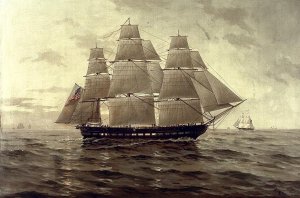
USS Chesapeake painting by F. Muller
On 22 June 1807 she was fired upon by HMS Leopard of the Royal Navy for refusing to comply with a search for deserters. The event, now known as the Chesapeake–Leopard Affair, angered the American populace and government and was a precipitating factor that led to the War of 1812. As a result of the affair, Chesapeake's commanding officer, James Barron, was court-martialed and the United States instituted the Embargo Act of 1807 against Great Britain.
Early in the War of 1812 she made one patrol and captured five British merchant ships before returning. She was captured by HMS Shannon shortly after sailing from Boston, Massachusetts, on 1 June 1813. The Royal Navy took her into their service as HMS Chesapeake, where she served until she was broken up and her timbers sold in 1819; they are now part of the Chesapeake Mill in Wickham, England.
https://en.wikipedia.org/wiki/USS_Chesapeake_(1799)
1801 - HM Gun Brig Requin (10), ex French brig 'Le Requin' (1794), Samuel Forvell, wrecked on the French coast near Quiberon
https://threedecks.org/index.php?display_type=show_ship&id=6160
1809 - HMS Onyx (10), Charles Gill, captured Dutch corvette Manly (16) off Lincolnshire coast.
HMS Onyx (1808) was a 10-gun Cherokee-class brig-sloop launched in 1808 and sold in 1819.
The Cherokee class was a class of brig-sloops of the Royal Navy, mounting 10 guns. Brig-sloops are sloops-of-war with two masts (a fore mast and a taller main mast) rather than the three masts of ship sloops. Orders for 115 vessels were placed, including 5 which were cancelled and 6 for which the orders were replaced by ones for equivalent steam-powered paddle vessels.
Many of these sailing vessels served as mail packet ships, and more than eight assisted with exploration and surveys. The best known of the class was HMS Beagle, then considerably modified for Beagle's second survey voyage under Robert FitzRoy, with the gentleman naturalist Charles Darwin on board as a self-funded supernumerary
https://en.wikipedia.org/wiki/Cherokee-class_brig-sloop
1813 - HM Brig Sloop Sarpedon (10), Thomas Parker, a Cherokee Class, foundered on the Norwegian coast with the loss of all hands
https://threedecks.org/index.php?display_type=show_ship&id=6447
1910 – Captain David Beatty is promoted to Rear admiral, and becomes the youngest admiral in the Royal Navy (except for Royal family members), since Horatio Nelson.
Admiral of the Fleet David Richard Beatty, 1st Earl Beatty GCB, OM, GCVO, DSO, PC (17 January 1871 – 11 March 1936) was a Royal Navy officer. After serving in the Mahdist War and then the response to the Boxer Rebellion, he commanded the 1st Battlecruiser Squadron at the Battle of Jutland in 1916, a tactically indecisive engagement after which his aggressive approach was contrasted with the caution of his commander Admiral Sir John Jellicoe. He is remembered for his comment at Jutland that "There seems to be something wrong with our bloody ships today", after two of his ships exploded. Later in the war he succeeded Jellicoe as Commander in Chief of the Grand Fleet, in which capacity he received the surrender of the German High Seas Fleet at the end of the war. He then followed Jellicoe's path a second time, serving as First Sea Lord—a position that Beatty held longer (7 years 9 months) than any other First Sea Lord in history. While First Sea Lord, he was involved in negotiating the Washington Naval Treaty of 1922 in which it was agreed that the United States, Britain and Japan should set their navies in a ratio of 5:5:3, with France and Italy maintaining smaller ratio fleets of 1.75 each.
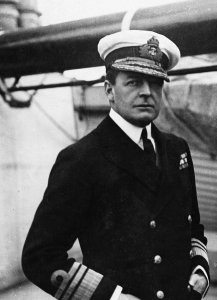
Advancement
In May 1902 he was passed fit for sea duty and was appointed captain of the cruiser HMS Juno on 2 June, spending two months in exercises with the Channel Fleet under Admiral Sir Arthur Wilson before joining the Mediterranean Fleet. Beatty worked hard to raise efficiency so that she was highly rated in gunnery and other competitions by the time he left the ship 19 December 1902. Ethel decided not to be left behind so rented the Capua Palace on Malta, home port of the Mediterranean Fleet, where she became part of the island's high society.
Beatty took command of the cruiser HMS Arrogant in the Mediterranean Fleet in November 1903 and then commanded the cruiser HMS Suffolk in the Mediterranean Fleet from October 1904. He then became the naval advisor to the Army Council in 1906 and, after having been appointed a naval Aide-de-Camp to the King on 5 November 1908, he became captain of the battleship HMS Queen in the Atlantic Fleet in December 1908. At the request of Alfred Winsloe, the Fourth Sea Lord, he was promoted to rear-admiral on 1 January 1910 by a special order in council since he had not completed the requisite time as a captain. He was offered the post of second-in-command of the Atlantic Fleet, but declined it and asked for one in the Home Fleet. As the Atlantic Fleet post was a major command, the Admiralty were very unimpressed and his attitude nearly ruined his career. Beatty, as a rapidly promoted war hero, with no financial worries and with a degree of support in Royal circles, felt more confident than most naval officers in standing firm on requesting a posting nearer home. He was approaching two years on half pay (which would trigger automatic retirement from the navy) when on 8 January 1912 his career was saved by the new First Lord of the Admiralty, Winston Churchill. Churchill had met Beatty when Beatty was commander of a gunboat on the Nile supporting the army at the Battle of Omdurman, in which Churchill took part as a cavalry officer. A "probably apocryphal" story relates that as Beatty walked into Churchill's office at the Admiralty, Churchill looked him over and said, "You seem very young to be an Admiral." Unfazed, Beatty replied, "And you seem very young to be First Lord." Churchill – who was himself only thirty-eight years old in 1912 – took to him immediately and he was appointed Naval Secretary
https://en.wikipedia.org/wiki/David_Beatty,_1st_Earl_Beatty
1944 - USS Ray (SS 271) sinks a Japanese gunboat at the mouth of Ambon Bay, while USS Puffer (SS 268) attacks a Japanese convoy at the western entrance of the Mindanao Sea, sinking an army cargo ship. On the same day USS Herring (SS 233) attacks a Japanese convoy, sinking an aircraft transport ship 220 miles off Tokyo Bay.
1962 - Navy SEAL teams are established with Teams One and Two formed with personnel from Underwater Demolition Teams.
Other Events on 1 January
1671 – Launch of French Basque, 36/44 guns, design by Joseph Saboulin, at Bayonne – renamed Brillant in June 1671, then Triton in June 1678; deleted 1694.
1717 – Launch of spanish San Juan Bautista 60 at Pasajes - Wrecked 26 December 1719
1727 – Launch of Spanish San Antonio 60 at Guarnizo - Stricken 1750
1739 – Bouvet Island, the world's remotest island is discovered by French explorer Jean-Baptiste Charles Bouvet de Lozier
Bouvet Island (Norwegian: Bouvetøya) is an uninhabited subantarctic high island and dependency of Norway located in the South Atlantic Ocean at 54°25.8′S 3°22.8′ECoordinates:

The island has an area of 49 square kilometres (19 sq mi), of which 93 percent is covered by a glacier. The centre of the island is an ice-filled crater of an inactive volcano. Some skerries and one smaller island, Larsøya, lie along the coast. Nyrøysa, created by a rock slide in the late 1950s, is the only easy place to land and is the location of a weather station.
The island was first spotted on 1 January 1739 by Frenchman Jean-Baptiste Charles Bouvet de Lozier, after whom it was later named. He recorded inaccurate coordinates and the island was not sighted again until 1808, when the British whaler captain James Lindsay named it Lindsay Island. The first claim of landing, although disputed, was by American sailor Benjamin Morrell. In 1825, the island was claimed for the British Crown by George Norris, who named it Liverpool Island. He also reported Thompson Island as nearby, although this was later shown to be a phantom island. The first Norvegia expedition landed on the island in 1927 and claimed it for Norway. At this time the island was named Bouvet Island, or "Bouvetøya" in Norwegian. After a dispute with the United Kingdom, it was declared a Norwegian dependency in 1930. It became a nature reserve in 1971.
https://en.wikipedia.org/wiki/Bouvet_Island
https://en.wikipedia.org/wiki/Jean-Baptiste_Charles_Bouvet_de_Lozier
1758 - HMS Adventure, Cdr. John Bray, took privateer Machault (14) off Dungerness Road
HMS Adventure (1741) was a fourth rate ship of the line launched in 1741, rebuilt as a 32-gun fifth rate in 1758, and sold in 1770.
1771 - Horatio Nelson reported to the third-rate HMS Raisonnable as an ordinary seaman and coxswain under his maternal uncle, Captain Maurice Suckling, who commanded the vessel.
Nelson attended Paston Grammar School, North Walsham, until he was 12 years old, and also attended King Edward VI’s Grammar School in Norwich. His naval career began on 1 January 1771, when he reported to the third-rate HMS Raisonnable as an ordinary seaman and coxswain under his maternal uncle, Captain Maurice Suckling, who commanded the vessel. Shortly after reporting aboard, Nelson was appointed a midshipman and began officer training. Early in his service, Nelson discovered that he suffered from seasickness, a chronic complaint that dogged him for the rest of his life
https://en.wikipedia.org/wiki/Horatio_Nelson,_1st_Viscount_Nelson
and in 1801 - Horatio Nelson was promoted vice-admiral.
Parker and the Baltic
Shortly after his arrival in England Nelson was appointed to be second-in-command of the Channel Fleet under Lord St Vincent. He was promoted to Vice Admiral of the Blue on 1 January 1801 and travelled to Plymouth, where on 22 January he was granted the freedom of the city. On 29 January Emma gave birth to their daughter, Horatia. Nelson was delighted, but subsequently disappointed when he was instructed to move his flag from HMS San Josef to HMS St George in preparation for a planned expedition to the Baltic. Tired of British ships imposing a blockade against French trade and stopping and searching their merchantmen, the Russian, Prussian, Danish and Swedish governments had formed an alliance to break the blockade. Nelson joined Admiral Sir Hyde Parker's fleet at Yarmouth, from where they sailed for the Danish coast in March. On their arrival, Parker was inclined to blockade Denmark and control the entrance to the Baltic, but Nelson urged a pre-emptive attack on the Danish fleet at harbour in Copenhagen. He convinced Parker to allow him to make an assault and was given significant reinforcements. Parker himself would wait in the Kattegat, covering Nelson's fleet in case of the arrival of the Swedish or Russian fleets.
https://en.wikipedia.org/wiki/Horatio_Nelson,_1st_Viscount_Nelson
1801 - USS Chesapeake (36), Cptn. Samuel Barron, captures the French privateer La Jeune Creole (16) off Barbuda
Chesapeake was a 38-gun wooden-hulled, three-masted heavy frigate of the United States Navy. She was one of the original six frigates whose construction was authorized by the Naval Act of 1794. Joshua Humphreys designed these frigates to be the young navy's capital ships. Chesapeake was originally designed as a 44-gun frigate but construction delays, material shortages, and budget problems caused builder Josiah Fox to alter her design to 38 guns. Launched at the Gosport Navy Yard on 2 December 1799, Chesapeake began her career during the Quasi-War with France and saw service in the First Barbary War.

USS Chesapeake painting by F. Muller
On 22 June 1807 she was fired upon by HMS Leopard of the Royal Navy for refusing to comply with a search for deserters. The event, now known as the Chesapeake–Leopard Affair, angered the American populace and government and was a precipitating factor that led to the War of 1812. As a result of the affair, Chesapeake's commanding officer, James Barron, was court-martialed and the United States instituted the Embargo Act of 1807 against Great Britain.
Early in the War of 1812 she made one patrol and captured five British merchant ships before returning. She was captured by HMS Shannon shortly after sailing from Boston, Massachusetts, on 1 June 1813. The Royal Navy took her into their service as HMS Chesapeake, where she served until she was broken up and her timbers sold in 1819; they are now part of the Chesapeake Mill in Wickham, England.
https://en.wikipedia.org/wiki/USS_Chesapeake_(1799)
1801 - HM Gun Brig Requin (10), ex French brig 'Le Requin' (1794), Samuel Forvell, wrecked on the French coast near Quiberon
https://threedecks.org/index.php?display_type=show_ship&id=6160
1809 - HMS Onyx (10), Charles Gill, captured Dutch corvette Manly (16) off Lincolnshire coast.
HMS Onyx (1808) was a 10-gun Cherokee-class brig-sloop launched in 1808 and sold in 1819.
The Cherokee class was a class of brig-sloops of the Royal Navy, mounting 10 guns. Brig-sloops are sloops-of-war with two masts (a fore mast and a taller main mast) rather than the three masts of ship sloops. Orders for 115 vessels were placed, including 5 which were cancelled and 6 for which the orders were replaced by ones for equivalent steam-powered paddle vessels.
Many of these sailing vessels served as mail packet ships, and more than eight assisted with exploration and surveys. The best known of the class was HMS Beagle, then considerably modified for Beagle's second survey voyage under Robert FitzRoy, with the gentleman naturalist Charles Darwin on board as a self-funded supernumerary
https://en.wikipedia.org/wiki/Cherokee-class_brig-sloop
1813 - HM Brig Sloop Sarpedon (10), Thomas Parker, a Cherokee Class, foundered on the Norwegian coast with the loss of all hands
https://threedecks.org/index.php?display_type=show_ship&id=6447
1910 – Captain David Beatty is promoted to Rear admiral, and becomes the youngest admiral in the Royal Navy (except for Royal family members), since Horatio Nelson.
Admiral of the Fleet David Richard Beatty, 1st Earl Beatty GCB, OM, GCVO, DSO, PC (17 January 1871 – 11 March 1936) was a Royal Navy officer. After serving in the Mahdist War and then the response to the Boxer Rebellion, he commanded the 1st Battlecruiser Squadron at the Battle of Jutland in 1916, a tactically indecisive engagement after which his aggressive approach was contrasted with the caution of his commander Admiral Sir John Jellicoe. He is remembered for his comment at Jutland that "There seems to be something wrong with our bloody ships today", after two of his ships exploded. Later in the war he succeeded Jellicoe as Commander in Chief of the Grand Fleet, in which capacity he received the surrender of the German High Seas Fleet at the end of the war. He then followed Jellicoe's path a second time, serving as First Sea Lord—a position that Beatty held longer (7 years 9 months) than any other First Sea Lord in history. While First Sea Lord, he was involved in negotiating the Washington Naval Treaty of 1922 in which it was agreed that the United States, Britain and Japan should set their navies in a ratio of 5:5:3, with France and Italy maintaining smaller ratio fleets of 1.75 each.

Advancement
In May 1902 he was passed fit for sea duty and was appointed captain of the cruiser HMS Juno on 2 June, spending two months in exercises with the Channel Fleet under Admiral Sir Arthur Wilson before joining the Mediterranean Fleet. Beatty worked hard to raise efficiency so that she was highly rated in gunnery and other competitions by the time he left the ship 19 December 1902. Ethel decided not to be left behind so rented the Capua Palace on Malta, home port of the Mediterranean Fleet, where she became part of the island's high society.
Beatty took command of the cruiser HMS Arrogant in the Mediterranean Fleet in November 1903 and then commanded the cruiser HMS Suffolk in the Mediterranean Fleet from October 1904. He then became the naval advisor to the Army Council in 1906 and, after having been appointed a naval Aide-de-Camp to the King on 5 November 1908, he became captain of the battleship HMS Queen in the Atlantic Fleet in December 1908. At the request of Alfred Winsloe, the Fourth Sea Lord, he was promoted to rear-admiral on 1 January 1910 by a special order in council since he had not completed the requisite time as a captain. He was offered the post of second-in-command of the Atlantic Fleet, but declined it and asked for one in the Home Fleet. As the Atlantic Fleet post was a major command, the Admiralty were very unimpressed and his attitude nearly ruined his career. Beatty, as a rapidly promoted war hero, with no financial worries and with a degree of support in Royal circles, felt more confident than most naval officers in standing firm on requesting a posting nearer home. He was approaching two years on half pay (which would trigger automatic retirement from the navy) when on 8 January 1912 his career was saved by the new First Lord of the Admiralty, Winston Churchill. Churchill had met Beatty when Beatty was commander of a gunboat on the Nile supporting the army at the Battle of Omdurman, in which Churchill took part as a cavalry officer. A "probably apocryphal" story relates that as Beatty walked into Churchill's office at the Admiralty, Churchill looked him over and said, "You seem very young to be an Admiral." Unfazed, Beatty replied, "And you seem very young to be First Lord." Churchill – who was himself only thirty-eight years old in 1912 – took to him immediately and he was appointed Naval Secretary
https://en.wikipedia.org/wiki/David_Beatty,_1st_Earl_Beatty
1944 - USS Ray (SS 271) sinks a Japanese gunboat at the mouth of Ambon Bay, while USS Puffer (SS 268) attacks a Japanese convoy at the western entrance of the Mindanao Sea, sinking an army cargo ship. On the same day USS Herring (SS 233) attacks a Japanese convoy, sinking an aircraft transport ship 220 miles off Tokyo Bay.
1962 - Navy SEAL teams are established with Teams One and Two formed with personnel from Underwater Demolition Teams.
Today in Naval History - Naval / Maritime Events in History
2 January 1689 - HMS Sedgemoor (1687 - 50) was driven ashore and wrecked at South Foreland, Kent
HMS Sedgemoor was a 50-gun fourth rate ship of the line of the English Royal Navy, launched at Chatham Dockyard in 1687.
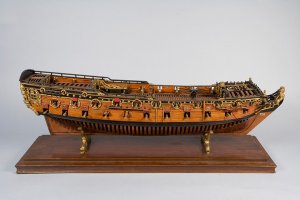
model of the HMS Sedgemoor in the Maritime Museum St.Petersburg
Class and type: 50-gun fourth rate ship of the line
Tons burthen: 677 long tons (687.9 t)
Length: 123 ft (37.5 m) (gundeck)
Beam: 34 ft 6 in (10.5 m)
Depth of hold: 13 ft 7 in (4.1 m)
Propulsion: Sails
Sail plan: Full rigged ship
Armament: 50 guns of various weights of shot
Sedgemoor was driven ashore and wrecked at South Foreland, Kent on 2 January 1689
https://en.wikipedia.org/wiki/HMS_Sedgemoor_(1687)
2 January 1689 - HMS Sedgemoor (1687 - 50) was driven ashore and wrecked at South Foreland, Kent
HMS Sedgemoor was a 50-gun fourth rate ship of the line of the English Royal Navy, launched at Chatham Dockyard in 1687.

model of the HMS Sedgemoor in the Maritime Museum St.Petersburg
Class and type: 50-gun fourth rate ship of the line
Tons burthen: 677 long tons (687.9 t)
Length: 123 ft (37.5 m) (gundeck)
Beam: 34 ft 6 in (10.5 m)
Depth of hold: 13 ft 7 in (4.1 m)
Propulsion: Sails
Sail plan: Full rigged ship
Armament: 50 guns of various weights of shot
Sedgemoor was driven ashore and wrecked at South Foreland, Kent on 2 January 1689
https://en.wikipedia.org/wiki/HMS_Sedgemoor_(1687)
Today in Naval History - Naval / Maritime Events in History
2 January 1779 – Launch of HMS Sibyl, a 28-gun Enterprise-class sixth-rate frigate of the Royal Navy.
HMS Sibyl was a 28-gun Enterprise-class sixth-rate frigate of the Royal Navy. The Sibyl was first commissioned in October 1778 under the command of Captain Thomas Pasley.
Class and type: 28-gun Enterprise-class sixth-rate frigate
Tons burthen: 599 20⁄94 (bm)
Length:
Depth of hold: 11 ft 0 in (3.35 m)
Sail plan: Full-rigged ship
Complement: 200 officers and men
Armament:
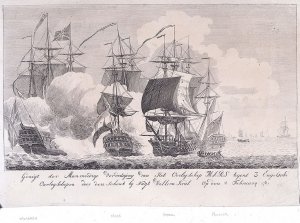
Monarch (left), Sybil (right) and Panther (right background) take the Dutch ship Mars (centre)
In 1783 Sibyl, Captain Vashon, was in company with HMS Alarm and Tobago when they encountered the American frigate Alliance, which was escorting USS Duc de Lauzun. An inconclusive engagement developed between Sibyl and Alliance that proved to be the last battle of the American Revolutionary War. Alarm and Tobago neither participated in the engagement nor captured Duc de Lauzun. Sibyl was renamed Garland in 1795.
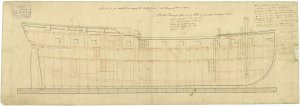
Scale 1:48. Plan showing the inboard profile plan for the Enterprize Class 1770: Enterprize (1774), Siren (1773), Fox (1773), Surprize (1774), Acteon (1775), Medea (1778), Serpine (1777), Andromeda (1777), Aurora (1777), Sibyl (1779), Brilliant (1779), Pomona (1778), Crescent (1779), Nemesis (1780), Resource (1778), Mercury (1779), Cyclops (1779), Vestal (1779), Laurel (1779), Pegasus (1779), and with modifications, written in green ink, for Hussar (1784), Rose (1783), Dido (1784), Thisbe (1783), Alligator (1787), Circe (1783), Lapwing (1785), all 28-gun, Sixth Rate Frigates building at various Royal and private yards. The reverse of the plan shows a section through the deck for the after Bitts as they appear face on, from upper deck to keel.
Loss
In February 1798 Captain J. C. Searle sailed Garland for the Cape of Good Hope. There Captain James Athol Wood replaced him.
Wood received information that a large French ship was anchored off Port Dauphiné, Madagascar. He sailed Garland to investigate but as she approached the vessel on 26 July, Garland struck a rock and sank before she could be run onshore. Still, the crew was able to take to the boats. Wood then decided to capture the French ship, which turned out to be a merchantman armed with 24 guns and carrying a crew of 150 men. The French crew had run their ship onshore at Garland's approach and abandoned her. However, when they saw Garland run onshore, they tried to retrieve their own vessel. Wood and his boats had the wind and reached the merchantman first. Wood was able to convince the natives to hand most of the Frenchmen over to the British. It was five months before Star arrived to rescue Wood, his crew, and his prisoners. Star took the prisoners to Île de France. Wood and his men returned to the Cape in their prize, a small boat of 15 tons burthen that they had built, and some small vessels that were prizes to the Cape squadron.
Wood returned to England, where on 15 December 1798 he and his officers were acquitted at the court martial for the loss of their ship.
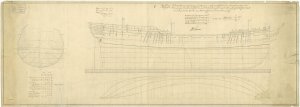
Scale 1:48. Plan showing the body plan, sheer lines and longitudinal half breadth as proposed and approved for building Siren [Syren] (1773) and Fox (1773), and later for building Enterprize (1773), and Surprize (1774), all 28-gun, Sixth Rate Frigates. The plan includes a table of the mast and yard dimensions. Signed by John Williams [Surveyor of the Navy, 1765-1784].
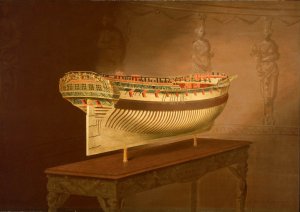
A painting showing a model of the frigate 'Enterprise' in starboard-quarter view. It has been depicted fixed to a table base, with a label on the side that reads 'Enterprise 28 Guns 200 Men'. The finely detailed painting was part of a commission of twelve perspective paintings, each of a different class, ordered by King George III. Each was accompanied by a memorandum describing the improvements in design that had been introduced since 1745. The work of producing these perspectives from the original Navy Board plans of the ships was divided between two draughtsmen, Joseph Williams and J. Binmer, whilst Joseph Marshall painted all the pictures. Their task was completed in August 1775. The model of the 'Enterprise' is positioned in a corner of a room, implied by the decorated wall behind featuring classical figures, and a wall frieze. The painting is signed and dated 'J Marshall pt. 1777'.
https://en.wikipedia.org/wiki/HMS_Sibyl_(1779)
https://en.wikipedia.org/wiki/Enterprise-class_frigate
http://collections.rmg.co.uk/collections.html#!csearch;searchTerm=Sibyl_1779
http://collections.rmg.co.uk/collec...el-310573;browseBy=vessel;vesselFacetLetter=E
2 January 1779 – Launch of HMS Sibyl, a 28-gun Enterprise-class sixth-rate frigate of the Royal Navy.
HMS Sibyl was a 28-gun Enterprise-class sixth-rate frigate of the Royal Navy. The Sibyl was first commissioned in October 1778 under the command of Captain Thomas Pasley.
Class and type: 28-gun Enterprise-class sixth-rate frigate
Tons burthen: 599 20⁄94 (bm)
Length:
- 120 ft 7 in (36.75 m) (overall)
- 99 ft 7 5⁄8 in (30.369 m) (keel)
Depth of hold: 11 ft 0 in (3.35 m)
Sail plan: Full-rigged ship
Complement: 200 officers and men
Armament:
- Upper deck: 24 × 9-pounder guns
- QD: 4 x 6-pounder guns + 4 x 18-pounder carronades
- Fc: 2 x 18-pounder carronades
- 12 × swivel guns

Monarch (left), Sybil (right) and Panther (right background) take the Dutch ship Mars (centre)
In 1783 Sibyl, Captain Vashon, was in company with HMS Alarm and Tobago when they encountered the American frigate Alliance, which was escorting USS Duc de Lauzun. An inconclusive engagement developed between Sibyl and Alliance that proved to be the last battle of the American Revolutionary War. Alarm and Tobago neither participated in the engagement nor captured Duc de Lauzun. Sibyl was renamed Garland in 1795.

Scale 1:48. Plan showing the inboard profile plan for the Enterprize Class 1770: Enterprize (1774), Siren (1773), Fox (1773), Surprize (1774), Acteon (1775), Medea (1778), Serpine (1777), Andromeda (1777), Aurora (1777), Sibyl (1779), Brilliant (1779), Pomona (1778), Crescent (1779), Nemesis (1780), Resource (1778), Mercury (1779), Cyclops (1779), Vestal (1779), Laurel (1779), Pegasus (1779), and with modifications, written in green ink, for Hussar (1784), Rose (1783), Dido (1784), Thisbe (1783), Alligator (1787), Circe (1783), Lapwing (1785), all 28-gun, Sixth Rate Frigates building at various Royal and private yards. The reverse of the plan shows a section through the deck for the after Bitts as they appear face on, from upper deck to keel.
Loss
In February 1798 Captain J. C. Searle sailed Garland for the Cape of Good Hope. There Captain James Athol Wood replaced him.
Wood received information that a large French ship was anchored off Port Dauphiné, Madagascar. He sailed Garland to investigate but as she approached the vessel on 26 July, Garland struck a rock and sank before she could be run onshore. Still, the crew was able to take to the boats. Wood then decided to capture the French ship, which turned out to be a merchantman armed with 24 guns and carrying a crew of 150 men. The French crew had run their ship onshore at Garland's approach and abandoned her. However, when they saw Garland run onshore, they tried to retrieve their own vessel. Wood and his boats had the wind and reached the merchantman first. Wood was able to convince the natives to hand most of the Frenchmen over to the British. It was five months before Star arrived to rescue Wood, his crew, and his prisoners. Star took the prisoners to Île de France. Wood and his men returned to the Cape in their prize, a small boat of 15 tons burthen that they had built, and some small vessels that were prizes to the Cape squadron.
Wood returned to England, where on 15 December 1798 he and his officers were acquitted at the court martial for the loss of their ship.

Scale 1:48. Plan showing the body plan, sheer lines and longitudinal half breadth as proposed and approved for building Siren [Syren] (1773) and Fox (1773), and later for building Enterprize (1773), and Surprize (1774), all 28-gun, Sixth Rate Frigates. The plan includes a table of the mast and yard dimensions. Signed by John Williams [Surveyor of the Navy, 1765-1784].

A painting showing a model of the frigate 'Enterprise' in starboard-quarter view. It has been depicted fixed to a table base, with a label on the side that reads 'Enterprise 28 Guns 200 Men'. The finely detailed painting was part of a commission of twelve perspective paintings, each of a different class, ordered by King George III. Each was accompanied by a memorandum describing the improvements in design that had been introduced since 1745. The work of producing these perspectives from the original Navy Board plans of the ships was divided between two draughtsmen, Joseph Williams and J. Binmer, whilst Joseph Marshall painted all the pictures. Their task was completed in August 1775. The model of the 'Enterprise' is positioned in a corner of a room, implied by the decorated wall behind featuring classical figures, and a wall frieze. The painting is signed and dated 'J Marshall pt. 1777'.
https://en.wikipedia.org/wiki/HMS_Sibyl_(1779)
https://en.wikipedia.org/wiki/Enterprise-class_frigate
http://collections.rmg.co.uk/collections.html#!csearch;searchTerm=Sibyl_1779
http://collections.rmg.co.uk/collec...el-310573;browseBy=vessel;vesselFacetLetter=E
Today in Naval History - Naval / Maritime Events in History
2 January 1780 - The Affair of Fielding and Bylandt
British squadron under Commodore Charles Fielding exacted the right to search a Dutch convoy escorted by a squadron under Rear-admiral Lodewijk van Bylandt. A brief naval engagement took place off the Isle of Wight. The commotion this incident caused in the Republic would eventually lead to the Fourth Anglo-Dutch War.
The affair of Fielding and Bylandt was a brief naval engagement off the Isle of Wight on 31 December 1779 between a Royal Navy squadron, commanded by Commodore Charles Fielding, and a naval squadron of the Dutch Republic, commanded by rear-admiral Lodewijk van Bylandt, escorting a Dutch convoy. The Dutch and British were not yet at war, but the British wished to inspect the Dutch merchantmen for what they considered contraband destined for France, then engaged in the American War of Independence. Bylandt attempted to avoid the engagement by offering the ships' manifests, but when Fielding insisted on a physical inspection, Bylandt put up a brief show of force, before striking his colours. The British then seized the Dutch merchantmen and conducted them as prizes to Portsmouth, followed by the Dutch squadron. The incident worsened the diplomatic relations between Great Britain and the Dutch Republic almost to breaking point. It also contributed to the formation of the First League of Armed Neutrality to which the Dutch acceded in December, 1780. To prevent their receiving assistance from other members of that League, Britain declared the Fourth Anglo-Dutch War shortly afterwards.
Background
The Dutch Republic had, after a period of strife during the second half of the seventeenth century, become a steadfast ally of the Kingdom of Great Britain, initially (after the Glorious Revolution of 1688) as the senior partner in the alliance, but later in the eighteenth century as the increasingly junior partner. It was bound to Britain by a number of treaties of military alliance (notably those of 1678, 1689 and 1716) which arguably obliged it to offer armed support. On the other hand, it had obtained in the Treaty of Breda and its offshoot, the Commercial Treaty of 1668 (confirmed in the Treaty of Westminster) an important concession from England: the right to transport non-contraband goods in its ships to countries with which Britain was at war, without these goods being subject to seizure by Britain even if they were owned by subjects of belligerent powers (this was usually referred to as the principle of "free ship, free goods"). The concept "contraband" was narrowly defined in these treaties as "arms and munitions." So-called "naval stores" (by which were commonly understood: ship's timbers, masts and spars, rope, canvas, tar and pitch) were not to be considered contraband. This right became important during wars in which Britain was a participant, but the Republic remained neutral, like the Seven Years' War and after 1778 the American Revolutionary War, in which Britain opposed the rebelling American Colonies and their allies, France and Spain. Arguably it exempted Dutch bottoms from inspection by the Royal Navy (or at least from confiscation of the goods in British prize courts), thereby undermining Britain's ability to maintain an effective embargo on the trade of her enemies, especially because Dutch shipping at the time still played a major role in the European carrying trade.
Though public opinion in the Republic became more and more sympathetic to the American Revolution in the years after 1776, the Dutch government that was dominated by stadtholder William V and his autocratic regime, inclined to support the British. However, the highly federalized structure of the Republic prevented the central government from effectively interfering with the commerce of cities like Amsterdam, which conducted a highly profitable trade with the American rebels (exchanging arms and munitions for colonial wares, like tobacco) via the entrepôt of the Dutch West India Company in its colony of St. Eustatius. The Amsterdam merchants also supplied France with naval stores, which that country needed for its naval construction, but was unable to procure itself in Norway and the Baltic countries, due to the British blockade. The Republic as a neutral power was therefore very useful for the French and their war effort. Britain, of course, viewed these developments with disfavour, and tried to force the Dutch government to put a stop to them. Diplomatic means failed, however. The Republic refused to provide military assistance in the form of the "loan" of its mercenary Scottish Brigade, when Britain requested that brigade for service in America. It also (reluctantly) provided shelter in Dutch territorial waters for the squadron of the American privateer John Paul Jones in 1779, and refused to embargo the export of arms and munitions. These refusals were due to the influence of Amsterdam, but also to diplomatic counter-pressure of France, exerted by its highly able ambassador Paul François de Quelen de la Vauguyon. When diplomatic means did not suffice, Britain resorted increasingly to seizure of what it considered "contraband" in Dutch bottoms on the high seas by the Royal Navy and British privateers. This elicited howls of protest from the affected merchants, for which the Dutch government at first remained deaf. France then started to exert pressure on the Dutch government to "defend its treaty rights" by selectively subjecting the Dutch cities, that supported the stadtholder in his opposition to taking countermeasures against the British "depredations," to economic sanctions. This soon convinced those cities to fall in line with Amsterdam and start clamouring for escort by Dutch naval vessels of convoys of merchantmen.
The States-General of the Netherlands (the governing body of the Republic) changed its position in November, 1779 and ordered the stadtholder, in his quality of commander-in-chief of the Dutch armed forces, to start offering limited convoy services to Dutch shipping. This despite the fact that the Dutch navy, because of long neglect, had become only a shadow of its former self. The 20 ships of the line that were not too old to serve, were no match for the British ships armed with 90 or 80 guns. According to the Dutch historian De Jonge the Royal Navy at the time had 137 ships of the line and France 68. After much discussion the States-General had decided on a programme of naval construction in 1778. Twenty-four new ships of the line were to be built, but this programme progressed only slowly, mainly because only the province of Holland paid its share of the cost. None of the new ships were as yet available. This did not bode well for a future naval conflict between the Republic and Great Britain and may help explain a certain lack of enthusiasm in the Dutch navy to engage in such a conflict. It should be noted that though the Republic did not concede the British interpretation of the Commercial Treaty that naval stores were to be considered contraband after all, the stadtholder prevailed in his policy of nevertheless excluding such stores from the convoys, to minimize friction with the British.
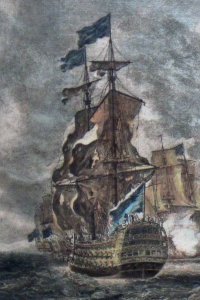
Battle of Lagos: HMS Namur
The incident
When the first convoys were prepared in December 1779 (one to the West Indies, under Rear-Admiral Willem Crul, and another to France and the Mediterranean under Rear-Admiral Count Lodewijk van Bylandt), the stadtholder gave written instructions that these should exclude ships that transported naval stores (as he at the time understood that the British defined those: in essence ships' timbers). He also prohibited allowing ships from "nations not recognized by the Republic" (i.e. the ships of John Paul Jones) to become part of the convoys. Finally, he enjoined Bylandt to avoid anything that might jeopardize the neutrality of the Republic.
The squadron of Admiral Bylandt departed from the Texel on 27 December 1779. It consisted of his flagship, the 54-gun ship of the line Prinses Royal Frederika Sophia Maria, the 40-gun Argo (Captain Jan Hendrik van Kinsbergen), the 44-gun Zwieten (Captain Nauman), the 26-gun Valk (Captain Silvester) and the 26-gun Alarm (Captain Mulder). They escorted 17 Dutch merchantmen. After progressing calmly a few days through the English Channel the convoy encountered a British squadron in the morning of 30 December. This consisted of the 90-gun HMS Namur, flying the broad pennant of Commodore Fielding, the 74-gun ships HMS Courageux (Captain Thomas Allen), HMS Centaur (Captain J. N. P. Nott), HMS Thunderer (Captain James Bradby) and HMS Valiant (Captain Samuel Goodall), the 60-gun HMS Buffalo (Captain H. Bromedge), the 50-gun HMS Portland (Captain Anthony Hunt), the 32-gun HMS Emerald (Captain Samuel Marshall), the 20-gun ships HMS Seaford (Captain Isaac Prescott) and HMS Camel (Captain Richard Rodney Bligh), the 12-gun HMS Hawk (Captain Richard Murray) and the 8-gun HMS Wolf (Captain M. Cole). Courageux hailed the Dutch flagship and asked for a parley to which Bylandt agreed. Fielding then sent a boat with two parlimentaires, one of which was his flag captain Marshall. Marshall demanded Bylandt's acquiescence in a physical inspection of the Dutch merchantmen by the British.
Bylandt replied that such a request was unprecedented as in peacetime the bona fides of the naval escorts of the convoy were usually accepted when the commanding officer asserted on his word of honour that the convoy did not transport contraband. He produced the manifests of the ships in the convoy and sworn statements of the captains of the merchantmen that they did not transport contraband, and added that he had personally satisfied himself that the convoy did not contain ship's timbers, though the Dutch did not consider this contraband. Marshall asked whether the ships carried hemp or iron (he apparently was well informed) and Bylandt admitted that they did and that this had never been considered contraband. Marshall replied that according to the British these particular commodities now constituted contraband. Seeing that he would not get any further with Marshall, Bylandt then sent his own flag captain, his nephew Frederik Sigismond van Bylandt, to the Namur to negotiate directly with Fielding. This failed to produce agreement. Fielding announced that he would start searching the Dutch vessels the next morning (as night had now fallen) and the younger Bylandt replied that in that case the Dutch would open fire.
During the night twelve of the Dutch merchantmen managed to slip away so that the next morning the convoy only consisted of the remaining five. Fielding now closed in with three of his ships of the line (Namur and two 74s) but was blocked by Bylandt with Prinses Royal, Argo and the frigate Alarm (the other two Dutch ships were out of reach). Nevertheless, Namur sent a launch to one of the Dutch merchantmen and Prinses Royal then fired two shots across its bow to make it veer away. About what happened next the British and Dutch versions differ. According to Bylandt and his captains in their depositions under oath during his court martial the three British ships immediately fired a broadside, to which the Dutch ships replied with one broadside of their own. According to Fielding he fired a single shot, which was answered by a broadside, to which the British answered with broadsides of their own.
After this exchange of fire Bylandt immediately struck his colours and signalled the other Dutch ships to do the same. This was remarkable, as the Dutch standing orders explicitly prohibited Dutch ships from surrendering if they were still capable of fighting, even when the flagship surrendered. It transpired at Bylandt's court martial that he had given sealed orders to his captains before departure from the Texel that they had to surrender when he gave a designated signal. He later explained that he had written these secret orders, because he foresaw that he would be confronted with an overwhelming superiority in numbers and guns, against which resistance would be useless. He had decided to offer only token resistance in such a case, just enough to "satisfy honour", but that it was imperative to restrain his captains of undue displays of courage in such a case, as that would defeat his purpose of avoiding needless bloodshed.
This was a typical example of eighteenth-century warfare that, more than modern warfare, was aimed at avoiding needless casualties. The British interpreted the striking of the colours as it was intended: to break off the fight and not a real surrender. They made no attempt to board the Dutch warships. Fielding proceeded with his inspection of the five merchantmen and duly arrested them when he found the "contraband" hemp. He then sent a message to Bylandt allowing him to rehoist his colours and proceed on his way. Bylandt replied, however, that he would stay with the merchantmen. Possibly annoyed by this, Fielding then demanded that the Dutch warships would salute the British flag as was his right under the several Anglo-Dutch treaties. Normally the Dutch did not object to this procedure, but in this case Bylandt hesitated. However, to avoid a needless firefight, and because he wished to carefully observe the treaties (as in his view Fielding had failed to do), so strengthening the Dutch case for presenting the British as aggressors, Bylandt complied under protest with this demand. Dutch public opinion would hold it against him. Finally the British sailed with their captives to Portsmouth, followed into port by Bylandt, who sent a complaint to the Dutch ambassador in Britain, count Van Welderen, as soon as he arrived.
Aftermath
Dutch public opinion was understandably outraged, both by the British action and by what they considered Bylandt's pusillanimity, that in the view of many amounted to cowardice, if not treason. To defend his honour Bylandt then demanded a court martial to clear his name. This blue-ribbon panel, consisting of no less than seven admirals, soon acquitted him of all charges brought against him though his secret surrender orders required some suppleness of mind in explaining them away. However, the prosecutor delivered a statement for the prosecution that might easily have been taken for a statement for the defence, thereby giving a strong impression of a whitewash to contemporaries (though not to sympathetic historians like De Jonge). Many even suspected that Bylandt's conduct was the result of a conspiracy by the stadtholder to support the British.
As a consequence of the political unrest, the stadtholder had to cease his resistance to unlimited convoy. The Dutch would henceforth try to defend their full treaty rights, to the satisfaction of France, which suspended its economic sanctions. The British, on the other hand, ceased all pretence of respecting those treaty rights. In April, 1780 the British abrogated the Commercial Treaty of 1668, and declared that they would henceforth treat the Dutch like any other neutral, without benefit of "free ship, free goods." Meanwhile, however, Empress Catherine II of Russia, shocked by the incident and even more by a similar mistreatment by Spain of two Russian ships, decided to issue a manifesto in which she demanded respect of the "free ship, free goods" principle for all neutrals by the belligerents. France and Spain were quick to comply (Spain issued abject apologies), but Britain, of course, demurred: the declaration was mainly aimed at the practices of the Royal Navy. Catherine then started negotiations with other neutral powers, including the Republic, to form what was to become the (First) League of Armed Neutrality.
The Republic saw an opportunity in it to protect itself from the British attacks on its trade without having to join the war against Great Britain. However, the Dutch overplayed their hand by asking for a guarantee of their colonies by the other members of the League. This Catherine was loath to grant. Eventually the Dutch settled for what was on offer and joined the League in December, 1780. The British then negated this gambit by declaring war on the Dutch for ostensibly unrelated reasons, thereby providing the other members of the League with an excuse to withhold their armed assistance to the Dutch. The Fourth Anglo-Dutch War had started.
From Threedecks:
On the last day of the year 1779 a British squadron under Captain Charles Feilding came up with a large Dutch convoy in charge of the Dutch Rear-Admiral van Bylandt, who had with him two sail of the line and two frigates. It was notorious that the Dutch ships were laden with naval stores and other contraband of war for the French. Captain Feilding requested permission to search these ships, but it was refused him; and van Bylandt declared that he would fire if any such search were attempted. Next day, however (January 1st), boats were sent from the British ships, on which the Dutch fired, and the British warships replied by opening on the Dutch. His honour being now satisfied, van Bylandt struck, though no blood had been shed in the interchange of compliments. Captain Feilding refused to accept the surrender, and returned to port with nine prizes, which were all condemned in due course.
Dutch Republic
Dutch Squadron, Lodewijk van Bylandt (1718-1793)
Ship Name Commander Notes
Prinses Royaal Fredrika Sophia Wilhelmina (64) Fleet Flagship
Zwieten (44) Nauman
Argo (40) Jan Hendrik van Kinsbergen (1735-1819)
Valk (24) Silvester
Alarm (24) Mulder
Great Britain
British Squadron, Charles Fielding (1738-1783)
Ship Name Commander Notes
Namur (90) Charles Fielding (1738-1783) Fleet Flagship
Centaur (74) John Neale Pleydell Nott (d.1781)
Courageux (74) Lord Constantine John Phipps (2nd Baron Mulgrave) (1744-1792)
Thunderer (74) The Hon. Robert Boyle (1736-1780), James Bradley
Valiant (74) The Hon. John Leveson Gower (1740-1792), Samuel Granston Goodall (d.1801)
Portland (50) Anthony Hunt (d.1796)
Buffalo (30) Hugh Bromedge (c.1714-1792)
Emerald (32) Samuel Marshall (1741-1795)
Camel (24) Richard Rodney Bligh (1737-1821)
Seaford (20) Isaac Prescott (d.1830)
Hawk (10) Richard Murray (d.1789)
Wolf (8) Martin Cole (c.1728-1803)
https://en.wikipedia.org/wiki/Affair_of_Fielding_and_Bylandt
https://threedecks.org/index.php?display_type=show_battle&id=467
2 January 1780 - The Affair of Fielding and Bylandt
British squadron under Commodore Charles Fielding exacted the right to search a Dutch convoy escorted by a squadron under Rear-admiral Lodewijk van Bylandt. A brief naval engagement took place off the Isle of Wight. The commotion this incident caused in the Republic would eventually lead to the Fourth Anglo-Dutch War.
The affair of Fielding and Bylandt was a brief naval engagement off the Isle of Wight on 31 December 1779 between a Royal Navy squadron, commanded by Commodore Charles Fielding, and a naval squadron of the Dutch Republic, commanded by rear-admiral Lodewijk van Bylandt, escorting a Dutch convoy. The Dutch and British were not yet at war, but the British wished to inspect the Dutch merchantmen for what they considered contraband destined for France, then engaged in the American War of Independence. Bylandt attempted to avoid the engagement by offering the ships' manifests, but when Fielding insisted on a physical inspection, Bylandt put up a brief show of force, before striking his colours. The British then seized the Dutch merchantmen and conducted them as prizes to Portsmouth, followed by the Dutch squadron. The incident worsened the diplomatic relations between Great Britain and the Dutch Republic almost to breaking point. It also contributed to the formation of the First League of Armed Neutrality to which the Dutch acceded in December, 1780. To prevent their receiving assistance from other members of that League, Britain declared the Fourth Anglo-Dutch War shortly afterwards.
Background
The Dutch Republic had, after a period of strife during the second half of the seventeenth century, become a steadfast ally of the Kingdom of Great Britain, initially (after the Glorious Revolution of 1688) as the senior partner in the alliance, but later in the eighteenth century as the increasingly junior partner. It was bound to Britain by a number of treaties of military alliance (notably those of 1678, 1689 and 1716) which arguably obliged it to offer armed support. On the other hand, it had obtained in the Treaty of Breda and its offshoot, the Commercial Treaty of 1668 (confirmed in the Treaty of Westminster) an important concession from England: the right to transport non-contraband goods in its ships to countries with which Britain was at war, without these goods being subject to seizure by Britain even if they were owned by subjects of belligerent powers (this was usually referred to as the principle of "free ship, free goods"). The concept "contraband" was narrowly defined in these treaties as "arms and munitions." So-called "naval stores" (by which were commonly understood: ship's timbers, masts and spars, rope, canvas, tar and pitch) were not to be considered contraband. This right became important during wars in which Britain was a participant, but the Republic remained neutral, like the Seven Years' War and after 1778 the American Revolutionary War, in which Britain opposed the rebelling American Colonies and their allies, France and Spain. Arguably it exempted Dutch bottoms from inspection by the Royal Navy (or at least from confiscation of the goods in British prize courts), thereby undermining Britain's ability to maintain an effective embargo on the trade of her enemies, especially because Dutch shipping at the time still played a major role in the European carrying trade.
Though public opinion in the Republic became more and more sympathetic to the American Revolution in the years after 1776, the Dutch government that was dominated by stadtholder William V and his autocratic regime, inclined to support the British. However, the highly federalized structure of the Republic prevented the central government from effectively interfering with the commerce of cities like Amsterdam, which conducted a highly profitable trade with the American rebels (exchanging arms and munitions for colonial wares, like tobacco) via the entrepôt of the Dutch West India Company in its colony of St. Eustatius. The Amsterdam merchants also supplied France with naval stores, which that country needed for its naval construction, but was unable to procure itself in Norway and the Baltic countries, due to the British blockade. The Republic as a neutral power was therefore very useful for the French and their war effort. Britain, of course, viewed these developments with disfavour, and tried to force the Dutch government to put a stop to them. Diplomatic means failed, however. The Republic refused to provide military assistance in the form of the "loan" of its mercenary Scottish Brigade, when Britain requested that brigade for service in America. It also (reluctantly) provided shelter in Dutch territorial waters for the squadron of the American privateer John Paul Jones in 1779, and refused to embargo the export of arms and munitions. These refusals were due to the influence of Amsterdam, but also to diplomatic counter-pressure of France, exerted by its highly able ambassador Paul François de Quelen de la Vauguyon. When diplomatic means did not suffice, Britain resorted increasingly to seizure of what it considered "contraband" in Dutch bottoms on the high seas by the Royal Navy and British privateers. This elicited howls of protest from the affected merchants, for which the Dutch government at first remained deaf. France then started to exert pressure on the Dutch government to "defend its treaty rights" by selectively subjecting the Dutch cities, that supported the stadtholder in his opposition to taking countermeasures against the British "depredations," to economic sanctions. This soon convinced those cities to fall in line with Amsterdam and start clamouring for escort by Dutch naval vessels of convoys of merchantmen.
The States-General of the Netherlands (the governing body of the Republic) changed its position in November, 1779 and ordered the stadtholder, in his quality of commander-in-chief of the Dutch armed forces, to start offering limited convoy services to Dutch shipping. This despite the fact that the Dutch navy, because of long neglect, had become only a shadow of its former self. The 20 ships of the line that were not too old to serve, were no match for the British ships armed with 90 or 80 guns. According to the Dutch historian De Jonge the Royal Navy at the time had 137 ships of the line and France 68. After much discussion the States-General had decided on a programme of naval construction in 1778. Twenty-four new ships of the line were to be built, but this programme progressed only slowly, mainly because only the province of Holland paid its share of the cost. None of the new ships were as yet available. This did not bode well for a future naval conflict between the Republic and Great Britain and may help explain a certain lack of enthusiasm in the Dutch navy to engage in such a conflict. It should be noted that though the Republic did not concede the British interpretation of the Commercial Treaty that naval stores were to be considered contraband after all, the stadtholder prevailed in his policy of nevertheless excluding such stores from the convoys, to minimize friction with the British.

Battle of Lagos: HMS Namur
The incident
When the first convoys were prepared in December 1779 (one to the West Indies, under Rear-Admiral Willem Crul, and another to France and the Mediterranean under Rear-Admiral Count Lodewijk van Bylandt), the stadtholder gave written instructions that these should exclude ships that transported naval stores (as he at the time understood that the British defined those: in essence ships' timbers). He also prohibited allowing ships from "nations not recognized by the Republic" (i.e. the ships of John Paul Jones) to become part of the convoys. Finally, he enjoined Bylandt to avoid anything that might jeopardize the neutrality of the Republic.
The squadron of Admiral Bylandt departed from the Texel on 27 December 1779. It consisted of his flagship, the 54-gun ship of the line Prinses Royal Frederika Sophia Maria, the 40-gun Argo (Captain Jan Hendrik van Kinsbergen), the 44-gun Zwieten (Captain Nauman), the 26-gun Valk (Captain Silvester) and the 26-gun Alarm (Captain Mulder). They escorted 17 Dutch merchantmen. After progressing calmly a few days through the English Channel the convoy encountered a British squadron in the morning of 30 December. This consisted of the 90-gun HMS Namur, flying the broad pennant of Commodore Fielding, the 74-gun ships HMS Courageux (Captain Thomas Allen), HMS Centaur (Captain J. N. P. Nott), HMS Thunderer (Captain James Bradby) and HMS Valiant (Captain Samuel Goodall), the 60-gun HMS Buffalo (Captain H. Bromedge), the 50-gun HMS Portland (Captain Anthony Hunt), the 32-gun HMS Emerald (Captain Samuel Marshall), the 20-gun ships HMS Seaford (Captain Isaac Prescott) and HMS Camel (Captain Richard Rodney Bligh), the 12-gun HMS Hawk (Captain Richard Murray) and the 8-gun HMS Wolf (Captain M. Cole). Courageux hailed the Dutch flagship and asked for a parley to which Bylandt agreed. Fielding then sent a boat with two parlimentaires, one of which was his flag captain Marshall. Marshall demanded Bylandt's acquiescence in a physical inspection of the Dutch merchantmen by the British.
Bylandt replied that such a request was unprecedented as in peacetime the bona fides of the naval escorts of the convoy were usually accepted when the commanding officer asserted on his word of honour that the convoy did not transport contraband. He produced the manifests of the ships in the convoy and sworn statements of the captains of the merchantmen that they did not transport contraband, and added that he had personally satisfied himself that the convoy did not contain ship's timbers, though the Dutch did not consider this contraband. Marshall asked whether the ships carried hemp or iron (he apparently was well informed) and Bylandt admitted that they did and that this had never been considered contraband. Marshall replied that according to the British these particular commodities now constituted contraband. Seeing that he would not get any further with Marshall, Bylandt then sent his own flag captain, his nephew Frederik Sigismond van Bylandt, to the Namur to negotiate directly with Fielding. This failed to produce agreement. Fielding announced that he would start searching the Dutch vessels the next morning (as night had now fallen) and the younger Bylandt replied that in that case the Dutch would open fire.
During the night twelve of the Dutch merchantmen managed to slip away so that the next morning the convoy only consisted of the remaining five. Fielding now closed in with three of his ships of the line (Namur and two 74s) but was blocked by Bylandt with Prinses Royal, Argo and the frigate Alarm (the other two Dutch ships were out of reach). Nevertheless, Namur sent a launch to one of the Dutch merchantmen and Prinses Royal then fired two shots across its bow to make it veer away. About what happened next the British and Dutch versions differ. According to Bylandt and his captains in their depositions under oath during his court martial the three British ships immediately fired a broadside, to which the Dutch ships replied with one broadside of their own. According to Fielding he fired a single shot, which was answered by a broadside, to which the British answered with broadsides of their own.
After this exchange of fire Bylandt immediately struck his colours and signalled the other Dutch ships to do the same. This was remarkable, as the Dutch standing orders explicitly prohibited Dutch ships from surrendering if they were still capable of fighting, even when the flagship surrendered. It transpired at Bylandt's court martial that he had given sealed orders to his captains before departure from the Texel that they had to surrender when he gave a designated signal. He later explained that he had written these secret orders, because he foresaw that he would be confronted with an overwhelming superiority in numbers and guns, against which resistance would be useless. He had decided to offer only token resistance in such a case, just enough to "satisfy honour", but that it was imperative to restrain his captains of undue displays of courage in such a case, as that would defeat his purpose of avoiding needless bloodshed.
This was a typical example of eighteenth-century warfare that, more than modern warfare, was aimed at avoiding needless casualties. The British interpreted the striking of the colours as it was intended: to break off the fight and not a real surrender. They made no attempt to board the Dutch warships. Fielding proceeded with his inspection of the five merchantmen and duly arrested them when he found the "contraband" hemp. He then sent a message to Bylandt allowing him to rehoist his colours and proceed on his way. Bylandt replied, however, that he would stay with the merchantmen. Possibly annoyed by this, Fielding then demanded that the Dutch warships would salute the British flag as was his right under the several Anglo-Dutch treaties. Normally the Dutch did not object to this procedure, but in this case Bylandt hesitated. However, to avoid a needless firefight, and because he wished to carefully observe the treaties (as in his view Fielding had failed to do), so strengthening the Dutch case for presenting the British as aggressors, Bylandt complied under protest with this demand. Dutch public opinion would hold it against him. Finally the British sailed with their captives to Portsmouth, followed into port by Bylandt, who sent a complaint to the Dutch ambassador in Britain, count Van Welderen, as soon as he arrived.
Aftermath
Dutch public opinion was understandably outraged, both by the British action and by what they considered Bylandt's pusillanimity, that in the view of many amounted to cowardice, if not treason. To defend his honour Bylandt then demanded a court martial to clear his name. This blue-ribbon panel, consisting of no less than seven admirals, soon acquitted him of all charges brought against him though his secret surrender orders required some suppleness of mind in explaining them away. However, the prosecutor delivered a statement for the prosecution that might easily have been taken for a statement for the defence, thereby giving a strong impression of a whitewash to contemporaries (though not to sympathetic historians like De Jonge). Many even suspected that Bylandt's conduct was the result of a conspiracy by the stadtholder to support the British.
As a consequence of the political unrest, the stadtholder had to cease his resistance to unlimited convoy. The Dutch would henceforth try to defend their full treaty rights, to the satisfaction of France, which suspended its economic sanctions. The British, on the other hand, ceased all pretence of respecting those treaty rights. In April, 1780 the British abrogated the Commercial Treaty of 1668, and declared that they would henceforth treat the Dutch like any other neutral, without benefit of "free ship, free goods." Meanwhile, however, Empress Catherine II of Russia, shocked by the incident and even more by a similar mistreatment by Spain of two Russian ships, decided to issue a manifesto in which she demanded respect of the "free ship, free goods" principle for all neutrals by the belligerents. France and Spain were quick to comply (Spain issued abject apologies), but Britain, of course, demurred: the declaration was mainly aimed at the practices of the Royal Navy. Catherine then started negotiations with other neutral powers, including the Republic, to form what was to become the (First) League of Armed Neutrality.
The Republic saw an opportunity in it to protect itself from the British attacks on its trade without having to join the war against Great Britain. However, the Dutch overplayed their hand by asking for a guarantee of their colonies by the other members of the League. This Catherine was loath to grant. Eventually the Dutch settled for what was on offer and joined the League in December, 1780. The British then negated this gambit by declaring war on the Dutch for ostensibly unrelated reasons, thereby providing the other members of the League with an excuse to withhold their armed assistance to the Dutch. The Fourth Anglo-Dutch War had started.
From Threedecks:
On the last day of the year 1779 a British squadron under Captain Charles Feilding came up with a large Dutch convoy in charge of the Dutch Rear-Admiral van Bylandt, who had with him two sail of the line and two frigates. It was notorious that the Dutch ships were laden with naval stores and other contraband of war for the French. Captain Feilding requested permission to search these ships, but it was refused him; and van Bylandt declared that he would fire if any such search were attempted. Next day, however (January 1st), boats were sent from the British ships, on which the Dutch fired, and the British warships replied by opening on the Dutch. His honour being now satisfied, van Bylandt struck, though no blood had been shed in the interchange of compliments. Captain Feilding refused to accept the surrender, and returned to port with nine prizes, which were all condemned in due course.
Dutch Republic
Dutch Squadron, Lodewijk van Bylandt (1718-1793)
Ship Name Commander Notes
Prinses Royaal Fredrika Sophia Wilhelmina (64) Fleet Flagship
Zwieten (44) Nauman
Argo (40) Jan Hendrik van Kinsbergen (1735-1819)
Valk (24) Silvester
Alarm (24) Mulder
Great Britain
British Squadron, Charles Fielding (1738-1783)
Ship Name Commander Notes
Namur (90) Charles Fielding (1738-1783) Fleet Flagship
Centaur (74) John Neale Pleydell Nott (d.1781)
Courageux (74) Lord Constantine John Phipps (2nd Baron Mulgrave) (1744-1792)
Thunderer (74) The Hon. Robert Boyle (1736-1780), James Bradley
Valiant (74) The Hon. John Leveson Gower (1740-1792), Samuel Granston Goodall (d.1801)
Portland (50) Anthony Hunt (d.1796)
Buffalo (30) Hugh Bromedge (c.1714-1792)
Emerald (32) Samuel Marshall (1741-1795)
Camel (24) Richard Rodney Bligh (1737-1821)
Seaford (20) Isaac Prescott (d.1830)
Hawk (10) Richard Murray (d.1789)
Wolf (8) Martin Cole (c.1728-1803)
https://en.wikipedia.org/wiki/Affair_of_Fielding_and_Bylandt
https://threedecks.org/index.php?display_type=show_battle&id=467
Today in Naval History - Naval / Maritime Events in History
2 January 1783 - Action of 2 January 1783
The Action of 2 January 1783 was a minor naval battle that took place in the Caribbean during the last stages of the American War of Independence. Severe fighting between a Royal Navy frigate HMS Magicienne and a French frigate Sibylle went on for nearly two hours but in that time both frigates were reduced to a wreck.
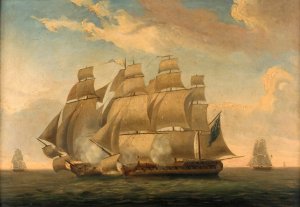
Action between HMS Magicienne and La Sibylle, 2 January 1783 by Robert Dodd
Events
Background
Captain Thomas Graves was in command of HMS Magicienne and was part of the British blockade off Cap-François, Saint-Domingue by the Royal Naval Jamaica station.
Off Cap-François into the open sea, a French convoy was sighted by HMS Endymion. At 0630 the Endymion made a signal that the convoy was French. The French convoy had sailed from Cap François on 27 December 1782 carrying goods and money to the Chesapeake. A ship of the convoy had strayed and steered toward the British ship. At 0900 the Endymion came up with her and captured which turned out to be the Celerity, a rich prize, valued at 20,000 Francs. Meanwhile, the Magicienne came up to assist in shifting the prisoners and goods. At 0930 Endymion signalled Magicienne to chase to the northeast. Kergariou decided to steer toward the British in order to draw them away from the convoy and signalled the convoy to continue on its course.
Action[edit]
Graves then set about clearing his ship for action. Shortly after the three leewardmost of the French vessels bore away and followed the French convoy. The French warships raised their colours and prepared to give battle.
At 1230 the Magicienne closed up with the smaller ship; the French sloop Railleur of 14 guns, and a short action took place. After having fired two broadsides into the sloop the French frigate Sibylle dropped back to assist the struggling Railleur, and Magicienne moved away. Sibylle was rated at 600 tons and mounted twenty-six 12-pounders and six 6-pounders. She had been coppered and was a fast sailing frigate. She had a crew of 271 men under the Comte de Kergariou-Locmaria. Magicienne sailed on and soon got on the port quarter of the Sybille. The guns were practically muzzle to muzzle as men hurled shot by the hand and frequently at each other through the port holes with half pikes and gun rammers to distract each other from firing.
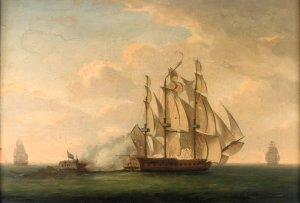
HMS Magicienne (left) lays dismasted after battling Le Sybille.
At 1415 the Magicienne had nearly silenced the Sybille’s fire and the British began to hope and expect that the French would soon surrender. Then, a French shot brought down Magicienne’s mizzen and fore-topmast. The wreck fell clear of the Sybille and she fell astern. Just after Magicienne’s masts fell, a broadside from the British ship cleared Sybille’s forecastle and killed eleven men. Kargariou was struck down on the quarterdeck and his men thought he was dead for some time but was only wounded. Lieutenant de vaisseau Morel-d’Escures, the second in command continued the action.
About 1420 the Magicienne’s fore and main masts went overboard. Sybille now made off as Endymion and Emerald were seen to approach. Magicienne was unable to do any thing except fire every available gun into her stern. The action had lasted for an hour and forty-five minutes.
Aftermath
The Magicienne was towed by Endymion and Emerald and went to Jamaica a fortnight later. The only prize, the Celerity, never made port and was lost on a rock on 9 January off the island of Heneaga. The Sybille however being so damaged was captured on 22 January 1783 by HMS Hussar under Thomas McNamara Russell. Thomas Graves later addressed two engravings of the battle, one represented its beginning, and the other its end.
Magicienne was a frigate of the French Navy, lead ship of her class. The British captured her in 1781 and she served with the Royal Navy until her crew burned her in 1810 to prevent her capture after she grounded at Isle de France (now Mauritius). During her service with the Royal Navy she captured several privateers and participated in the Battle of San Domingo.
Class and type: Magicienne class frigate
Displacement: 600 tonnes & 1260 tonnes fully loaded
Length: 44.2 m (145 ft)
Beam: 11.2 m (37 ft)
Draught: 5.2 m (17 ft) (22 French feet)
Armament:
The Sibylle class was a class of five 32-gun sail frigates designed by Jacques-Noël Sané and built for the French Navy in the late 1770s. They carried 26 x 12-pounder guns on the upper deck and 6 x 8-pounder guns on the forecastle and quarter deck.
Displacement: 600 tonnes
Length: 43.9 metres
Beam: 11.2 metres
Draught: 5.4 metres
Propulsion: Sail
Complement: 260
Armament:
Builder: Brest
Begun: April 1777
Launched: 1 September 1777
Fate: Captured by the Royal Navy in February 1783, broken up in 1784
https://en.wikipedia.org/wiki/Action_of_2_January_1783
https://en.wikipedia.org/wiki/French_frigate_Magicienne_(1778)
https://en.wikipedia.org/wiki/Sibylle-class_frigate
2 January 1783 - Action of 2 January 1783
The Action of 2 January 1783 was a minor naval battle that took place in the Caribbean during the last stages of the American War of Independence. Severe fighting between a Royal Navy frigate HMS Magicienne and a French frigate Sibylle went on for nearly two hours but in that time both frigates were reduced to a wreck.

Action between HMS Magicienne and La Sibylle, 2 January 1783 by Robert Dodd
Events
Background
Captain Thomas Graves was in command of HMS Magicienne and was part of the British blockade off Cap-François, Saint-Domingue by the Royal Naval Jamaica station.
Off Cap-François into the open sea, a French convoy was sighted by HMS Endymion. At 0630 the Endymion made a signal that the convoy was French. The French convoy had sailed from Cap François on 27 December 1782 carrying goods and money to the Chesapeake. A ship of the convoy had strayed and steered toward the British ship. At 0900 the Endymion came up with her and captured which turned out to be the Celerity, a rich prize, valued at 20,000 Francs. Meanwhile, the Magicienne came up to assist in shifting the prisoners and goods. At 0930 Endymion signalled Magicienne to chase to the northeast. Kergariou decided to steer toward the British in order to draw them away from the convoy and signalled the convoy to continue on its course.
Action[edit]
Graves then set about clearing his ship for action. Shortly after the three leewardmost of the French vessels bore away and followed the French convoy. The French warships raised their colours and prepared to give battle.
At 1230 the Magicienne closed up with the smaller ship; the French sloop Railleur of 14 guns, and a short action took place. After having fired two broadsides into the sloop the French frigate Sibylle dropped back to assist the struggling Railleur, and Magicienne moved away. Sibylle was rated at 600 tons and mounted twenty-six 12-pounders and six 6-pounders. She had been coppered and was a fast sailing frigate. She had a crew of 271 men under the Comte de Kergariou-Locmaria. Magicienne sailed on and soon got on the port quarter of the Sybille. The guns were practically muzzle to muzzle as men hurled shot by the hand and frequently at each other through the port holes with half pikes and gun rammers to distract each other from firing.

HMS Magicienne (left) lays dismasted after battling Le Sybille.
At 1415 the Magicienne had nearly silenced the Sybille’s fire and the British began to hope and expect that the French would soon surrender. Then, a French shot brought down Magicienne’s mizzen and fore-topmast. The wreck fell clear of the Sybille and she fell astern. Just after Magicienne’s masts fell, a broadside from the British ship cleared Sybille’s forecastle and killed eleven men. Kargariou was struck down on the quarterdeck and his men thought he was dead for some time but was only wounded. Lieutenant de vaisseau Morel-d’Escures, the second in command continued the action.
About 1420 the Magicienne’s fore and main masts went overboard. Sybille now made off as Endymion and Emerald were seen to approach. Magicienne was unable to do any thing except fire every available gun into her stern. The action had lasted for an hour and forty-five minutes.
Aftermath
The Magicienne was towed by Endymion and Emerald and went to Jamaica a fortnight later. The only prize, the Celerity, never made port and was lost on a rock on 9 January off the island of Heneaga. The Sybille however being so damaged was captured on 22 January 1783 by HMS Hussar under Thomas McNamara Russell. Thomas Graves later addressed two engravings of the battle, one represented its beginning, and the other its end.
Magicienne was a frigate of the French Navy, lead ship of her class. The British captured her in 1781 and she served with the Royal Navy until her crew burned her in 1810 to prevent her capture after she grounded at Isle de France (now Mauritius). During her service with the Royal Navy she captured several privateers and participated in the Battle of San Domingo.
Class and type: Magicienne class frigate
Displacement: 600 tonnes & 1260 tonnes fully loaded
Length: 44.2 m (145 ft)
Beam: 11.2 m (37 ft)
Draught: 5.2 m (17 ft) (22 French feet)
Armament:
The Sibylle class was a class of five 32-gun sail frigates designed by Jacques-Noël Sané and built for the French Navy in the late 1770s. They carried 26 x 12-pounder guns on the upper deck and 6 x 8-pounder guns on the forecastle and quarter deck.
Displacement: 600 tonnes
Length: 43.9 metres
Beam: 11.2 metres
Draught: 5.4 metres
Propulsion: Sail
Complement: 260
Armament:
Builder: Brest
Begun: April 1777
Launched: 1 September 1777
Fate: Captured by the Royal Navy in February 1783, broken up in 1784
https://en.wikipedia.org/wiki/Action_of_2_January_1783
https://en.wikipedia.org/wiki/French_frigate_Magicienne_(1778)
https://en.wikipedia.org/wiki/Sibylle-class_frigate
Today in Naval History - Naval / Maritime Events in History
2 January 1793 - The Childers Incident marked the opening shots between British and French forces during the French Revolutionary Wars, the first phase of a 23-year-long war between the two countries.
The Childers Incident of 2 January 1793 marked the opening shots between British and French forces during the French Revolutionary Wars, the first phase of a 23-year-long war between the two countries. Following the French Revolution of 1789, diplomatic relations between the Kingdom of Great Britain and the French Republic had steadily deteriorated and France was in political and social turmoil. One of the strongest hotbeds of republican activity was the principal Atlantic naval base of the French Navy at Brest in Brittany, the scene of a significant mutiny in 1790.
On 2 January a small British warship, the 14-gun brig HMS Childers under Commander Robert Barlow, was ordered to enter the Roadstead of Brest to reconnoitre the state of readiness of the French fleet. As Childers entered the Goulet de Brest, the vessel came under fire from French batteries flying the tricolour. Although Barlow clearly identified his brig as a neutral British vessel the fire continued until he was able to withdraw. Although Childers had been struck by a 48 lb (22 kg) cannonball, none of the crew were wounded. The incident was of itself inconsequential, with minimal damage and no casualties on either side, but it marked a symbolic moment in the deterioration of relations between Britain and France in the approach to war, which broke out on 1 February 1793.
Background
Following the French Revolution of 1789 relations between the newly declared French Republic and its European neighbours sharply deteriorated. In April 1791, the Declaration of Pillnitz was jointly issued by the Austria and Prussiastating their support for King Louis XVI.[1] In February 1792 Austria and Prussia formally allied and the French Legislative Assembly responded on 20 April 1792 by declaring war on Austria. This first conflict, known as the War of the First Coalition, began on land as other than France the principal European seapowers remained neutral. The arrest of the French king in August 1792 and the expansion of the war into Northern Italy brought about the start of the naval war in the Mediterranean Sea.
Britain had remained neutral throughout the first stages of the war. Although unsympathetic to the violence and upheaval of the French Revolution, Britain's Prime Minister William Pitt the Younger was unwilling to go to war alongside the absolutist monarchies of Eastern Europe.[3] Nevertheless, the Royal Navy had made extensive preparations for war should it occur, starting with the Spanish Armament of 1790. The French Atlantic Fleet however was in poor condition: the principal fleet base at Brest in Brittany had been the scene of a significant mutiny in 1790 and by 1791 desertion rates among French naval officers were running at more than 80%. Despite its strong republican politics and command difficulties, the fleet itself was very strong, having been expanded and improved during the 1780s – indeed the tax rises to pay for the French Navy had been one of the causes of the original Revolution in 1789.
Childers incident

Map of the Roadstead of Brest
The strength of the French Atlantic fleet was a major cause of concern to the British Admiralty, and in late 1792 orders were issued for the small British brig, the 14-gun HMS Childers under Commander Robert Barlow, to enter the Roadstead of Brest and investigate the state of readiness of the French fleet.
On 2 January 1793, Childers was approaching the entrance to the roadstead under overcast skies and with a light, unreliable breeze. The only entrance to Brest harbour is through a narrow waterway known as the Goulet de Brest. The Goulet lies between the Pointe du Petit Minou and the Pointe du Portzic on the north shore and the îlot des Capucins and the Pointe des Espagnols on the Roscanvel peninsula to the south. Due to its importance as the entrance to Brest, the shores of the Goulet were heavily fortified. As Childers entered the Goulet one of the forts covering the entrance from the southern shore fired a shot at a distance of 0.75 nautical miles (1.39 km) which passed over the brig into the sea beyond.
Assuming this warning shot had been fired in the belief that his brig, which was not flying a flag, may be an enemy vessel, Barlow ordered the British naval ensign and the pennant of the Channel Fleet run up. Thus clearly identified as a neutral British warship, Barlow allowed Childers to drift closer inshore with the tide.[10] The French battery responded by raising tricolour flags and red pennants, a move copied by the other batteries covering the Goulet. Having drifted much closer to two batteries Childers suddenly came under heavy fire, the batteries containing very large 48-pounder cannon.
Under fire and with the wind too calm for sailing, Barlow ran out oars to try and pull his brig away from the French batteries. The diminutive size of his vessel made it a difficult target and he was soon able to take advantage of a fresh breeze to withdraw from the crossfire. A single shot struck the brig, smashing into one of the 4-pounder cannon on deck and breaking it into three pieces, although none of the crew were wounded by the strike.
Aftermath
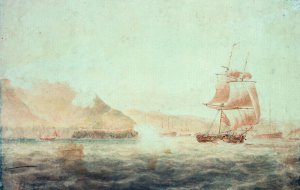
French batteries firing at Childers off Brest 1793; National Maritime Museum
Having successfully withdrawn Childers from danger, Barlow returned to Britain on 4 January after battling a strong gale in the Channel. ing at the small Cornish port of Fowey, Barlow took an express coach directly to the Admiralty in London,[8] arriving on 11 January carrying the 48 lb (22 kg) cannonball as evidence of the incident and what British historian William James called the "strong spirit of hostility on the part of the new republic". Historian Edward Pelham Brenton, writing in 1825, noted however that French hostility on this occasion was justified, commenting that "in the then troubled state of Europe Childers and her captain had no business to be prying into the equipments at Brest within gunshot of the forts: if we had seen a French vessel of war running from the Needles to St Helens, and making observations, I suspect we should, at such a crisis, have taken the liberty to bring her to action."
ing at the small Cornish port of Fowey, Barlow took an express coach directly to the Admiralty in London,[8] arriving on 11 January carrying the 48 lb (22 kg) cannonball as evidence of the incident and what British historian William James called the "strong spirit of hostility on the part of the new republic". Historian Edward Pelham Brenton, writing in 1825, noted however that French hostility on this occasion was justified, commenting that "in the then troubled state of Europe Childers and her captain had no business to be prying into the equipments at Brest within gunshot of the forts: if we had seen a French vessel of war running from the Needles to St Helens, and making observations, I suspect we should, at such a crisis, have taken the liberty to bring her to action."
On 24 January the French ambassador was expelled in response to the execution of Louis XVI in Paris on 21 January and on 1 February the National Convention declared war on Great Britain. The naval campaign in the Atlantic began in earnest in March 1793, when a French battle squadron briefly put to sea before a mutiny forced it to return. The war between Britain and France begun in the Goulet on 2 January 1793 was to last, with a 14-month break in 1802–1803, until 1815
HMS Childers was a brig-sloop of the British Royal Navy, initially armed with 10 carriage guns which were later increased to 14 guns. The first brig-sloop to be built for the Navy, she was ordered from a commercial builder during the early years of the American War of Independence, and went on to support operations in the English Channel and the Caribbean. Laid up for a time after the end of the American War of Independence, she returned to service shortly before the outbreak of the French Revolutionary Wars. She had an active career in both the French Revolutionary and Napoleonic Wars, capturing numerous French privateers and during the Gunboat War participated in a noteworthy single-ship action. The navy withdrew her from service at the beginning of 1811, at which time she was broken up.
Class and type: Childers-class brig-sloop
Tons burthen: 206 15⁄94 (bm)
Length:
Depth of hold: 10 ft 11 3⁄4 in (3.3 m)
Propulsion: Sails
Sail plan: Two masted brig-rigged
Complement: 80
Armament:
https://en.wikipedia.org/wiki/Childers_Incident
https://en.wikipedia.org/wiki/HMS_Childers_(1778)
2 January 1793 - The Childers Incident marked the opening shots between British and French forces during the French Revolutionary Wars, the first phase of a 23-year-long war between the two countries.
The Childers Incident of 2 January 1793 marked the opening shots between British and French forces during the French Revolutionary Wars, the first phase of a 23-year-long war between the two countries. Following the French Revolution of 1789, diplomatic relations between the Kingdom of Great Britain and the French Republic had steadily deteriorated and France was in political and social turmoil. One of the strongest hotbeds of republican activity was the principal Atlantic naval base of the French Navy at Brest in Brittany, the scene of a significant mutiny in 1790.
On 2 January a small British warship, the 14-gun brig HMS Childers under Commander Robert Barlow, was ordered to enter the Roadstead of Brest to reconnoitre the state of readiness of the French fleet. As Childers entered the Goulet de Brest, the vessel came under fire from French batteries flying the tricolour. Although Barlow clearly identified his brig as a neutral British vessel the fire continued until he was able to withdraw. Although Childers had been struck by a 48 lb (22 kg) cannonball, none of the crew were wounded. The incident was of itself inconsequential, with minimal damage and no casualties on either side, but it marked a symbolic moment in the deterioration of relations between Britain and France in the approach to war, which broke out on 1 February 1793.
Background
Following the French Revolution of 1789 relations between the newly declared French Republic and its European neighbours sharply deteriorated. In April 1791, the Declaration of Pillnitz was jointly issued by the Austria and Prussiastating their support for King Louis XVI.[1] In February 1792 Austria and Prussia formally allied and the French Legislative Assembly responded on 20 April 1792 by declaring war on Austria. This first conflict, known as the War of the First Coalition, began on land as other than France the principal European seapowers remained neutral. The arrest of the French king in August 1792 and the expansion of the war into Northern Italy brought about the start of the naval war in the Mediterranean Sea.
Britain had remained neutral throughout the first stages of the war. Although unsympathetic to the violence and upheaval of the French Revolution, Britain's Prime Minister William Pitt the Younger was unwilling to go to war alongside the absolutist monarchies of Eastern Europe.[3] Nevertheless, the Royal Navy had made extensive preparations for war should it occur, starting with the Spanish Armament of 1790. The French Atlantic Fleet however was in poor condition: the principal fleet base at Brest in Brittany had been the scene of a significant mutiny in 1790 and by 1791 desertion rates among French naval officers were running at more than 80%. Despite its strong republican politics and command difficulties, the fleet itself was very strong, having been expanded and improved during the 1780s – indeed the tax rises to pay for the French Navy had been one of the causes of the original Revolution in 1789.
Childers incident

Map of the Roadstead of Brest
The strength of the French Atlantic fleet was a major cause of concern to the British Admiralty, and in late 1792 orders were issued for the small British brig, the 14-gun HMS Childers under Commander Robert Barlow, to enter the Roadstead of Brest and investigate the state of readiness of the French fleet.
On 2 January 1793, Childers was approaching the entrance to the roadstead under overcast skies and with a light, unreliable breeze. The only entrance to Brest harbour is through a narrow waterway known as the Goulet de Brest. The Goulet lies between the Pointe du Petit Minou and the Pointe du Portzic on the north shore and the îlot des Capucins and the Pointe des Espagnols on the Roscanvel peninsula to the south. Due to its importance as the entrance to Brest, the shores of the Goulet were heavily fortified. As Childers entered the Goulet one of the forts covering the entrance from the southern shore fired a shot at a distance of 0.75 nautical miles (1.39 km) which passed over the brig into the sea beyond.
Assuming this warning shot had been fired in the belief that his brig, which was not flying a flag, may be an enemy vessel, Barlow ordered the British naval ensign and the pennant of the Channel Fleet run up. Thus clearly identified as a neutral British warship, Barlow allowed Childers to drift closer inshore with the tide.[10] The French battery responded by raising tricolour flags and red pennants, a move copied by the other batteries covering the Goulet. Having drifted much closer to two batteries Childers suddenly came under heavy fire, the batteries containing very large 48-pounder cannon.
Under fire and with the wind too calm for sailing, Barlow ran out oars to try and pull his brig away from the French batteries. The diminutive size of his vessel made it a difficult target and he was soon able to take advantage of a fresh breeze to withdraw from the crossfire. A single shot struck the brig, smashing into one of the 4-pounder cannon on deck and breaking it into three pieces, although none of the crew were wounded by the strike.
Aftermath

French batteries firing at Childers off Brest 1793; National Maritime Museum
Having successfully withdrawn Childers from danger, Barlow returned to Britain on 4 January after battling a strong gale in the Channel.
 ing at the small Cornish port of Fowey, Barlow took an express coach directly to the Admiralty in London,[8] arriving on 11 January carrying the 48 lb (22 kg) cannonball as evidence of the incident and what British historian William James called the "strong spirit of hostility on the part of the new republic". Historian Edward Pelham Brenton, writing in 1825, noted however that French hostility on this occasion was justified, commenting that "in the then troubled state of Europe Childers and her captain had no business to be prying into the equipments at Brest within gunshot of the forts: if we had seen a French vessel of war running from the Needles to St Helens, and making observations, I suspect we should, at such a crisis, have taken the liberty to bring her to action."
ing at the small Cornish port of Fowey, Barlow took an express coach directly to the Admiralty in London,[8] arriving on 11 January carrying the 48 lb (22 kg) cannonball as evidence of the incident and what British historian William James called the "strong spirit of hostility on the part of the new republic". Historian Edward Pelham Brenton, writing in 1825, noted however that French hostility on this occasion was justified, commenting that "in the then troubled state of Europe Childers and her captain had no business to be prying into the equipments at Brest within gunshot of the forts: if we had seen a French vessel of war running from the Needles to St Helens, and making observations, I suspect we should, at such a crisis, have taken the liberty to bring her to action."On 24 January the French ambassador was expelled in response to the execution of Louis XVI in Paris on 21 January and on 1 February the National Convention declared war on Great Britain. The naval campaign in the Atlantic began in earnest in March 1793, when a French battle squadron briefly put to sea before a mutiny forced it to return. The war between Britain and France begun in the Goulet on 2 January 1793 was to last, with a 14-month break in 1802–1803, until 1815
HMS Childers was a brig-sloop of the British Royal Navy, initially armed with 10 carriage guns which were later increased to 14 guns. The first brig-sloop to be built for the Navy, she was ordered from a commercial builder during the early years of the American War of Independence, and went on to support operations in the English Channel and the Caribbean. Laid up for a time after the end of the American War of Independence, she returned to service shortly before the outbreak of the French Revolutionary Wars. She had an active career in both the French Revolutionary and Napoleonic Wars, capturing numerous French privateers and during the Gunboat War participated in a noteworthy single-ship action. The navy withdrew her from service at the beginning of 1811, at which time she was broken up.
Class and type: Childers-class brig-sloop
Tons burthen: 206 15⁄94 (bm)
Length:
- 79 ft 0 in (24.1 m) (gundeck)
- 60 ft 9 1⁄2 in (18.5 m) (keel)
Depth of hold: 10 ft 11 3⁄4 in (3.3 m)
Propulsion: Sails
Sail plan: Two masted brig-rigged
Complement: 80
Armament:
- 10 × 4-pounder guns (increased to 14 guns by 1793) + 12 x ½-pounder swivel guns
- Later:14 x 12-pounder carronades
https://en.wikipedia.org/wiki/Childers_Incident
https://en.wikipedia.org/wiki/HMS_Childers_(1778)
Today in Naval History - Naval / Maritime Events in History
2 January 1804 - HMS Creole (38), Cptn. Austin Bissell, foundered in passage from Jamaica.
Créole was a 40-gun frigate of the French Navy, a one-off design by Jacques-Augustin Lamothe. The French Navy loaned her to a privateer in 1797. Later, she served in the Brest squadron, took part in Ganteaume's expeditions of 1801 to Egypt, and was involved in the French acquisition of Santo Domingo (also known as the Era de Francia) and briefly detained Toussaint Louverture before he was brought to France. The 74-gun ships HMS Vanguard and HMS Cumberland captured her Santo Domingo on 30 June 1803. The Royal Navy took her into service but she foundered soon afterwards during an attempt to sail to Britain; her crew were rescued.
Displacement: 1,350 tons (French)
Length: 48.93 m (160.5 ft)
Beam: 11.91 m (39.1 ft)
Draught: 5.8 m (19 ft)
Complement:
Career
Early career
After her launch, Créole was fitted for four months before being lent 19 October 1797 to a privateer from Nantes. She was commissioned in the Navy on 29 April 1798 and started patrolling off Brest in February 1799.
On 12 April, capitaine de vaisseau Pierre-Paulin Gourrège took command. On 26 April 1799, Créole departed Brest with the oceanic fleet and took part in Bruix' expedition of 1799 into the Mediterranean. She was detached to Oneglia, along with Romaine and Vautour, to support the French invasion of Italy.
The British hired armed cutter Sandwich was under the command of Lieutenant George Lempriere and cruising off the coast of Barcelona on 14 June 1799 when she sighted a large fleet. Lempriere believed the vessels to be a British fleet and sailed towards them. When the strange vessels did not reply to the recognition signals, Lempriere realized that they were enemy vessels and attempted to sail away.[5] The French fleet detached a lugger, possibly Affronteur, to pursue Sandwich. A frigate joined the lugger in pursuit and towards evening the lugger opened fire with her bow chasers. The frigate then too opened fire, with Sandwich returning fire as best she could. By 1a.m. the frigate was within musket shot of Sandwich and any further resistance would have been futile. Lempriere then struck to Créole.
In 1800, Créole was part of a division under contre-amiral Lacrosse, tasked to cruise off Morbihan and cut off the royalists from their British support. In order to avoid the British blockade, the squadron anchored to Camaret, but attracted the attention of the British and sailed back to harbour to avoid engagement. The division was retasked to ferry 4600 troops to Santo Domingo, but again ran into the British blockade, turned back and adjourned its mission. During the cruise, Créole sustained some damage in a collision with Fidèle.
Ganteaume's expeditions of 1801
Main article: Ganteaume's expeditions of 1801
On 27 January 1801, Créole departed Brest with a division under contre-amiral Ganteaume, tasked to ferry ammunitions and reinforcements to the Armée d'Égypte, taking part in Ganteaume's expeditions of 1801. After several false starts due to unfavourable weather or to the British blockade, Ganteaume eventually set sail on 23 February on a heavy sea which soon dispersed his squadron. The next day, Créole rejoined Indivisible, and the two ships sailed together until they finally made contact with their division.
Ganteaume reached Toulon on 18 February; Gourrège left Créole to take command of the flagship Indivisible on 9 March. The squadron set sail on 25 April. His crew much weakened by an epidemic, Ganteaume managed to establish a blockade of Elba on 1 May and bombard Portoferraio on 6 May, supporting the Siege of Porto Ferrajo, but he had to detach Formidable, Indomptable, Dessaix and Créole to ferry the sick to Livorno and return to Toulon.
Créole took an incidental part in the Action of 24 June 1801, where the lone British 74-gun HMS Swiftsure met the French squadron and was captured after a running battle.
Santo Domingo
On 9 January 1802, Créole departed Toulon with a division under contre-amiral Ganteaume, ferrying troops to Santo Domingo to consolidate the French occupation of Santo Domingo. After Toussaint Louverture surrendered, he was embarked on Créole before being transferred on Héros and ferried to France, where he died in prison. Boarding the frigate, Louverture stated:
“In overthrowing me you have cut down in Saint-Domingue only the trunk of the tree of liberty; it will spring up again from the roots, for they are many and they are deep.”
In 1803, Créole ferried troops to Port-au-Prince under Commander Jean-Marie-Pierre Lebastard, travelling to Jean-Rabel from Cap-Français with 530 soldiers under General Morgan. Her crew suffered from the yellow feverthat was endemic to the campaign, so that only 150 men were fit and the frigate was 177 short of her usual complement. In the morning of 30 June, Créole met five British ships of the line, who closed in to investigate and gave chase. Créole was unable to escape the ships of the line as Vanguard and Cumberland came up and flanked her. Vanguard opened fire, and after a single token gunshot, Créole struck to her overwhelmingly better-armed opponents.
Fate
A prize crew conveyed Créole to Port Royal in Jamaica for repair. There the Royal Navy commissioned her as HMS Creole under Captain Austin Bissell.
In late 1803 Créole sailed for Britain with a prize crew and numerous French prisoners. Créole was in a poor state, and on 26 December she sprang a leak. The crew and prisoners manned her pumps but were unable to prevent the accumulation of water such that by 30 December the water was rising by two feet per hour. Two leaks became evident, one forward and one aft of the hold. The crew threw her guns, shot, iron ballast and some stores overboard, and slung a sail under the hull. Still, by 2 January the pumps were again unable to prevent the accumulation of water. The crew and the prisoners were exhausted and so Bissell decided to abandon ship. Cumberland came up to take everyone off Créole. The last men left on 3 January, at which time she sank beneath the waves at 40°42′N 51°24′W.
https://en.wikipedia.org/wiki/French_frigate_Créole_(1797)
2 January 1804 - HMS Creole (38), Cptn. Austin Bissell, foundered in passage from Jamaica.
Créole was a 40-gun frigate of the French Navy, a one-off design by Jacques-Augustin Lamothe. The French Navy loaned her to a privateer in 1797. Later, she served in the Brest squadron, took part in Ganteaume's expeditions of 1801 to Egypt, and was involved in the French acquisition of Santo Domingo (also known as the Era de Francia) and briefly detained Toussaint Louverture before he was brought to France. The 74-gun ships HMS Vanguard and HMS Cumberland captured her Santo Domingo on 30 June 1803. The Royal Navy took her into service but she foundered soon afterwards during an attempt to sail to Britain; her crew were rescued.
Displacement: 1,350 tons (French)
Length: 48.93 m (160.5 ft)
Beam: 11.91 m (39.1 ft)
Draught: 5.8 m (19 ft)
Complement:
- 340 (wartime)
- 260 (peaceime)
- UD: 28 x 18-pounder long guns
- Spardeck: 12 x 8-pounder long guns
Career
Early career
After her launch, Créole was fitted for four months before being lent 19 October 1797 to a privateer from Nantes. She was commissioned in the Navy on 29 April 1798 and started patrolling off Brest in February 1799.
On 12 April, capitaine de vaisseau Pierre-Paulin Gourrège took command. On 26 April 1799, Créole departed Brest with the oceanic fleet and took part in Bruix' expedition of 1799 into the Mediterranean. She was detached to Oneglia, along with Romaine and Vautour, to support the French invasion of Italy.
The British hired armed cutter Sandwich was under the command of Lieutenant George Lempriere and cruising off the coast of Barcelona on 14 June 1799 when she sighted a large fleet. Lempriere believed the vessels to be a British fleet and sailed towards them. When the strange vessels did not reply to the recognition signals, Lempriere realized that they were enemy vessels and attempted to sail away.[5] The French fleet detached a lugger, possibly Affronteur, to pursue Sandwich. A frigate joined the lugger in pursuit and towards evening the lugger opened fire with her bow chasers. The frigate then too opened fire, with Sandwich returning fire as best she could. By 1a.m. the frigate was within musket shot of Sandwich and any further resistance would have been futile. Lempriere then struck to Créole.
In 1800, Créole was part of a division under contre-amiral Lacrosse, tasked to cruise off Morbihan and cut off the royalists from their British support. In order to avoid the British blockade, the squadron anchored to Camaret, but attracted the attention of the British and sailed back to harbour to avoid engagement. The division was retasked to ferry 4600 troops to Santo Domingo, but again ran into the British blockade, turned back and adjourned its mission. During the cruise, Créole sustained some damage in a collision with Fidèle.
Ganteaume's expeditions of 1801
Main article: Ganteaume's expeditions of 1801
On 27 January 1801, Créole departed Brest with a division under contre-amiral Ganteaume, tasked to ferry ammunitions and reinforcements to the Armée d'Égypte, taking part in Ganteaume's expeditions of 1801. After several false starts due to unfavourable weather or to the British blockade, Ganteaume eventually set sail on 23 February on a heavy sea which soon dispersed his squadron. The next day, Créole rejoined Indivisible, and the two ships sailed together until they finally made contact with their division.
Ganteaume reached Toulon on 18 February; Gourrège left Créole to take command of the flagship Indivisible on 9 March. The squadron set sail on 25 April. His crew much weakened by an epidemic, Ganteaume managed to establish a blockade of Elba on 1 May and bombard Portoferraio on 6 May, supporting the Siege of Porto Ferrajo, but he had to detach Formidable, Indomptable, Dessaix and Créole to ferry the sick to Livorno and return to Toulon.
Créole took an incidental part in the Action of 24 June 1801, where the lone British 74-gun HMS Swiftsure met the French squadron and was captured after a running battle.
Santo Domingo
On 9 January 1802, Créole departed Toulon with a division under contre-amiral Ganteaume, ferrying troops to Santo Domingo to consolidate the French occupation of Santo Domingo. After Toussaint Louverture surrendered, he was embarked on Créole before being transferred on Héros and ferried to France, where he died in prison. Boarding the frigate, Louverture stated:
“In overthrowing me you have cut down in Saint-Domingue only the trunk of the tree of liberty; it will spring up again from the roots, for they are many and they are deep.”
In 1803, Créole ferried troops to Port-au-Prince under Commander Jean-Marie-Pierre Lebastard, travelling to Jean-Rabel from Cap-Français with 530 soldiers under General Morgan. Her crew suffered from the yellow feverthat was endemic to the campaign, so that only 150 men were fit and the frigate was 177 short of her usual complement. In the morning of 30 June, Créole met five British ships of the line, who closed in to investigate and gave chase. Créole was unable to escape the ships of the line as Vanguard and Cumberland came up and flanked her. Vanguard opened fire, and after a single token gunshot, Créole struck to her overwhelmingly better-armed opponents.
Fate
A prize crew conveyed Créole to Port Royal in Jamaica for repair. There the Royal Navy commissioned her as HMS Creole under Captain Austin Bissell.
In late 1803 Créole sailed for Britain with a prize crew and numerous French prisoners. Créole was in a poor state, and on 26 December she sprang a leak. The crew and prisoners manned her pumps but were unable to prevent the accumulation of water such that by 30 December the water was rising by two feet per hour. Two leaks became evident, one forward and one aft of the hold. The crew threw her guns, shot, iron ballast and some stores overboard, and slung a sail under the hull. Still, by 2 January the pumps were again unable to prevent the accumulation of water. The crew and the prisoners were exhausted and so Bissell decided to abandon ship. Cumberland came up to take everyone off Créole. The last men left on 3 January, at which time she sank beneath the waves at 40°42′N 51°24′W.
https://en.wikipedia.org/wiki/French_frigate_Créole_(1797)
Today in Naval History - Naval / Maritime Events in History
2 January 1833 – Reassertion of British sovereignty over the Falkland Islands.
In December 1832, two naval vessels were sent by the United Kingdom to re-assert British sovereignty over the Falkland Islands (Spanish: Islas Malvinas), after the United Provinces of the River Plate (part of which later became Argentina) ignored British diplomatic protests over the appointment of Luis Vernet as governor of the Falkland Islands and a dispute over fishing rights.
Background
In 1765, Captain John Byron explored Saunders Island, which lies 1.5 miles (2.5 km) off the coast of West Falkland. He named the harbour Port Egmont, and claimed this and other islands for Britain, on the grounds of prior discovery. The next year Captain John MacBride established a British settlement at Port Egmont. The British presence in the west continued, until interrupted by Spain (who had acquired the French colony), during the Falkland Crisis from 10 July 1770 to 22 January 1771. Economic pressures led Britain to unilaterally withdraw from many overseas settlements in 1774.

Luis Vernet
On 20 May 1776 the British forces under the command of Lieutenant Clayton formally took their leave of Port Egmont, leaving a plaque asserting Britain's continuing sovereignty over the islands.[1] The Falkland Islands remained an important outpost for whalers and sealers who used the islands to shelter from the worst of the South Atlantic weather. By merit of their location, the Falkland Islands have often been the last refuge for ships damaged at sea. Most numerous among those using the islands were British and American sealers, where typically between 40 and 50 ships were engaged in hunting fur seals.
In 1823, after its war of independence against Spain, the United Provinces granted land on East Falkland to Luis Vernet, who first travelled to the islands the following year. That first expedition failed almost as soon as it landed, and a second attempt, in 1826, sanctioned by the British (but delayed until winter by a Brazilian blockade), also failed after arrival in the islands. In 1828, the United Provinces government granted Vernet all of East Falkland, including all its resources, with exemption from taxation if a colony could be established within three years. He took settlers, some of them British, and before leaving once again sought permission first from the British Consulate in Buenos Aires. After receiving consent, Vernet agreed to provide regular reports to the British consul and expressed the desire for British protection for his settlement should they decide to re-establish their presence in the islands.
On Vernet's return to the Falklands, Puerto Soledad was renamed Puerto Luis. The United Provinces proclaimed Luis Vernet as governor of the islands in 1829. British diplomatic protests at the appointment and declarations of sovereignty were ignored. The United Provinces also granted Vernet exclusive rights to seal hunting in the islands. This too was disputed by the British and US consulates at Buenos Aires but once again the diplomatic protests were ignored. Vernet continued to provide regular reports to the British consul throughout this period.
In 1831, Luis Vernet seized three US vessels (Breakwater, Superior and Harriet) hunting seals in Falklands waters, confiscating their catch and arresting their crews. Vernet returned to the mainland, bringing senior officers of the US vessels to stand trial for violating restrictions on seal hunting. The US consul protested violently against the seizure of US ships and the USS Lexington sailed to the Falklands. The log of the Lexington reports only the destruction of arms and a powder store, though in his claim against the US government for compensation (rejected by the US government of President Grover Cleveland in 1885) Vernet stated that the settlement was destroyed. The Islands were declared free from all government, the seven senior members of the settlement were arrested for piracy[4] and taken to Montevideo, where they were released without charge on the orders of Commodore Rogers.
This latter incident finally convinced the British Foreign Office to reassert its sovereignty claim over the islands. Throughout much of 1832, the United Provinces did not have a government representative in the islands. The Buenos Aires government commissioned Major Esteban Mestivier as the new governor of the islands, to set up a penal colony, but when he arrived at the settlement on 15 November 1832 his soldiers mutinied and killed him. The mutiny was put down by Major José María Pinedo, commander of the United Provinces schooner Sarandí. Order was restored just before the British arrived.
Arrival of the squadron

Sketch of a brig-sloop, probably HMS Clio, by Cmdr. William Farrington, c. 1812
Under the command of Captain John James Onslow, the brig-sloop HMS Clio, previously stationed at Rio de Janeiro, reached Port Egmont on 20 December 1832. It was later joined by HMS Tyne. Their first actions were to repair the fort at Port Egmont and affix a notice of possession.
Onslow arrived at Puerto Louis on 2 January 1833. Pinedo sent an officer to the British ship, where he was presented with the following written request to replace the Argentine flag with the British one, and leave the location.
Recognising Vernet's settlement had British permission, Onslow set about ensuring the continuation of that settlement for the replenishment of passing ships. The gauchos had not been paid since Vernet's departure and were anxious to return to the mainland. Onslow persuaded them to stay by paying them in silver for provisions and promising that in the absence of Vernet's authority they could earn their living from the feral cattle on the islands.
The British vessels did not stay long and departed two days later, leaving William Dickson (Vernet's storekeeper) in charge of the settlement. Dixon was provided with a flagpole and instructed to fly the British flag whenever a vessel was in harbour.
Argentina claims that the population of the islands was expelled in 1833; however, both British and Argentine sources from the time, including the log of the ARA Sarandí, suggest that the colonists were encouraged to remain under Vernet's deputy, Matthew Brisbane.
Aftermath

HMS Beagle
HMS Beagle arrived on 15 March 1833. Vernet dispatched his deputy Matthew Brisbane to the islands to take charge of his settlement March 1833. Meeting with Captain Fitzroy of the Beagle, he was encouraged to continue with Vernet's enterprise provided there was no attempt to further the ambitions of the United Provinces. Like Onslow before him, Fitzroy was forced to use his powers of persuasion to encourage the gauchos to continue working in Vernet's establishment:
In 26 August 1833, eight members of the settlement led by Antonio Rivero ran amok, killing the five senior members. In part this stemmed from the re-imposition of paying the wages of the gauchos in paper vouchers issued by Vernet.
In 1834 on his second visit Charles Darwin commented that:
In Buenos Aires, Vernet was effectively bankrupt and attempts to obtain compensation from the US Government for losses from the Lexington raid proved fruitless. The situation in Buenos Aires was chaotic and diplomatic relations with the US remained ruptured till 1839. He made several approaches to the British Government asking for support to re-establish his business at Port Louis, receiving support from Woodbine Parish (British chargé d'affaires in Buenos Aires from 1825 to 1832) as the best qualified person to develop the islands.
Vernet wrote to Lieutenant Smith offering advice, which was gratefully received and acted upon. Smith repeatedly urged Vernet to return to Port Louis but as Vernet became increasingly involved in the territorial dispute with the Government in Buenos Aires all communications ceased and no more accounts were sent. An approach to Lieutenant Lowcay to retrieve his property was rebuffed but later he was requested to remove his property as the Government could not be responsible for it.
HMS Clio was Cruizer-class brig-sloop of the Royal Navy, launched at James Betts' shipyard in Mistleythorn in Essex on 10 January 1807. Her establishment was 71 officers and men, 24 boys and 20 marines. She served in the Baltic during the Napoleonic Wars, accomplished the re-establishment of British rule on the Falkland Islands in 1833, and participated in the First Opium War. She was broken up in 1845.
https://en.wikipedia.org/wiki/Reassertion_of_British_sovereignty_over_the_Falkland_Islands_(1833)
https://en.wikipedia.org/wiki/HMS_Clio_(1807)
2 January 1833 – Reassertion of British sovereignty over the Falkland Islands.
In December 1832, two naval vessels were sent by the United Kingdom to re-assert British sovereignty over the Falkland Islands (Spanish: Islas Malvinas), after the United Provinces of the River Plate (part of which later became Argentina) ignored British diplomatic protests over the appointment of Luis Vernet as governor of the Falkland Islands and a dispute over fishing rights.
Background
In 1765, Captain John Byron explored Saunders Island, which lies 1.5 miles (2.5 km) off the coast of West Falkland. He named the harbour Port Egmont, and claimed this and other islands for Britain, on the grounds of prior discovery. The next year Captain John MacBride established a British settlement at Port Egmont. The British presence in the west continued, until interrupted by Spain (who had acquired the French colony), during the Falkland Crisis from 10 July 1770 to 22 January 1771. Economic pressures led Britain to unilaterally withdraw from many overseas settlements in 1774.

Luis Vernet
On 20 May 1776 the British forces under the command of Lieutenant Clayton formally took their leave of Port Egmont, leaving a plaque asserting Britain's continuing sovereignty over the islands.[1] The Falkland Islands remained an important outpost for whalers and sealers who used the islands to shelter from the worst of the South Atlantic weather. By merit of their location, the Falkland Islands have often been the last refuge for ships damaged at sea. Most numerous among those using the islands were British and American sealers, where typically between 40 and 50 ships were engaged in hunting fur seals.
In 1823, after its war of independence against Spain, the United Provinces granted land on East Falkland to Luis Vernet, who first travelled to the islands the following year. That first expedition failed almost as soon as it landed, and a second attempt, in 1826, sanctioned by the British (but delayed until winter by a Brazilian blockade), also failed after arrival in the islands. In 1828, the United Provinces government granted Vernet all of East Falkland, including all its resources, with exemption from taxation if a colony could be established within three years. He took settlers, some of them British, and before leaving once again sought permission first from the British Consulate in Buenos Aires. After receiving consent, Vernet agreed to provide regular reports to the British consul and expressed the desire for British protection for his settlement should they decide to re-establish their presence in the islands.
On Vernet's return to the Falklands, Puerto Soledad was renamed Puerto Luis. The United Provinces proclaimed Luis Vernet as governor of the islands in 1829. British diplomatic protests at the appointment and declarations of sovereignty were ignored. The United Provinces also granted Vernet exclusive rights to seal hunting in the islands. This too was disputed by the British and US consulates at Buenos Aires but once again the diplomatic protests were ignored. Vernet continued to provide regular reports to the British consul throughout this period.
In 1831, Luis Vernet seized three US vessels (Breakwater, Superior and Harriet) hunting seals in Falklands waters, confiscating their catch and arresting their crews. Vernet returned to the mainland, bringing senior officers of the US vessels to stand trial for violating restrictions on seal hunting. The US consul protested violently against the seizure of US ships and the USS Lexington sailed to the Falklands. The log of the Lexington reports only the destruction of arms and a powder store, though in his claim against the US government for compensation (rejected by the US government of President Grover Cleveland in 1885) Vernet stated that the settlement was destroyed. The Islands were declared free from all government, the seven senior members of the settlement were arrested for piracy[4] and taken to Montevideo, where they were released without charge on the orders of Commodore Rogers.
This latter incident finally convinced the British Foreign Office to reassert its sovereignty claim over the islands. Throughout much of 1832, the United Provinces did not have a government representative in the islands. The Buenos Aires government commissioned Major Esteban Mestivier as the new governor of the islands, to set up a penal colony, but when he arrived at the settlement on 15 November 1832 his soldiers mutinied and killed him. The mutiny was put down by Major José María Pinedo, commander of the United Provinces schooner Sarandí. Order was restored just before the British arrived.
Arrival of the squadron

Sketch of a brig-sloop, probably HMS Clio, by Cmdr. William Farrington, c. 1812
Under the command of Captain John James Onslow, the brig-sloop HMS Clio, previously stationed at Rio de Janeiro, reached Port Egmont on 20 December 1832. It was later joined by HMS Tyne. Their first actions were to repair the fort at Port Egmont and affix a notice of possession.
Onslow arrived at Puerto Louis on 2 January 1833. Pinedo sent an officer to the British ship, where he was presented with the following written request to replace the Argentine flag with the British one, and leave the location.
I have to direct you that I have received directions from His Excellency and Commander-in-Chief of His Britannic Majesty's ships and vessels of war, South America station, in the name of His Britannic Majesty, to exercise the rights of sovereignty over these Islands.
It is my intention to hoist to-morrow the national flag of Great Britain on shore when I request you will be pleased to haul down your flag on shore and withdraw your force, taking all stores belonging to your Government.
Pinedo entertained plans for resisting, but finally desisted because of his obvious numerical inferiority and the want of enough nationals among his crew (approximately 80% of his forces were British mercenaries who refused to fight their countrymen). The British forces disembarked on 3 January and switched the flags, delivering the Argentine one to Pinedo, who left on 5 January.It is my intention to hoist to-morrow the national flag of Great Britain on shore when I request you will be pleased to haul down your flag on shore and withdraw your force, taking all stores belonging to your Government.
Recognising Vernet's settlement had British permission, Onslow set about ensuring the continuation of that settlement for the replenishment of passing ships. The gauchos had not been paid since Vernet's departure and were anxious to return to the mainland. Onslow persuaded them to stay by paying them in silver for provisions and promising that in the absence of Vernet's authority they could earn their living from the feral cattle on the islands.
The British vessels did not stay long and departed two days later, leaving William Dickson (Vernet's storekeeper) in charge of the settlement. Dixon was provided with a flagpole and instructed to fly the British flag whenever a vessel was in harbour.
Argentina claims that the population of the islands was expelled in 1833; however, both British and Argentine sources from the time, including the log of the ARA Sarandí, suggest that the colonists were encouraged to remain under Vernet's deputy, Matthew Brisbane.
Aftermath

HMS Beagle
HMS Beagle arrived on 15 March 1833. Vernet dispatched his deputy Matthew Brisbane to the islands to take charge of his settlement March 1833. Meeting with Captain Fitzroy of the Beagle, he was encouraged to continue with Vernet's enterprise provided there was no attempt to further the ambitions of the United Provinces. Like Onslow before him, Fitzroy was forced to use his powers of persuasion to encourage the gauchos to continue working in Vernet's establishment:
During the month we remained in Berkeley Sound, I had much trouble with the crews of whaling or small sealing vessels, as well as with the settlers, who all seemed to fancy that because the British flag was re-hoisted on the Falklands, they were at liberty to do what they pleased with Mr. Vernet's private property, as well as with the wild cattle and horses. The gauchos wished to leave the place, and return to the Plata, but as they were the only useful labourers on the islands, in fact, the only people on whom any dependance could be placed for a regular supply of fresh beef, I interested myself as much as possible to induce them to remain, and with partial success, for seven staid out of twelve.
Arriving in the Falklands, Fitzroy expected to find the thriving settlement reported by another British officer. Instead, he found the settlement in a derelict state, which Brisbane blamed upon the Lexington's raid. Fitzroy questioned several members of the settlement who corroborated Brisbane's account:Next morning Brisbane came on board with his papers, and I was quite satisfied with their tenor, and the explanation which he gave me of his business. Some misapprehension having since arisen about his being authorized by Vernet to act in his stead, I may here mention again (though no longer of any material consequence), that Brisbane's instructions from Vernet authorized him to act as his private agent only, to look after the remains of his private property, and that they had not the slightest reference to civil or military authority. This settled, I went to Port Louis, but was indeed disappointed. Instead of the cheerful little village I once anticipated finding – a few half-ruined stone cottages; some straggling huts built of turf; two or three stove boats; some broken ground where gardens had been, and where a few cabbages or potatoes still grew; some sheep and goats; a few long-legged pigs; some horses and cows; with here and there a miserable-looking human being – were scattered over the fore-ground of a view which had dark clouds, ragged-topped hills, and a wild waste of moorland to fill up the distance.
"How is this?" said I, in astonishment, to Mr. Brisbane; "I thought Mr. Vernet's colony was a thriving and happy settlement. Where are the inhabitants? the place seems deserted as well as ruined." "Indeed, Sir, it was flourishing," said he, "but the Lexington ruined it: Captain Duncan's men did such harm to the houses and gardens. I was myself treated as a pirate—rowed stern foremost on board the Lexington – abused on her quarter-deck most violently by Captain Duncan – treated by him more like a wild beast than a human being – and from that time guarded as a felon, until I was released by order of Commodore Rogers." "But," I said, "where are the rest of the settlers? I see but half a dozen, of whom two are old black women; where are the gauchos who kill the cattle?" "Sir, they are all in the country. They have been so much alarmed by what has occurred, and they dread the appearance of a ship of war so much, that they keep out of the way till they know what she is going to do." I afterwards interrogated an old German, while Brisbane was out of sight, and after him a young native of Buenos Ayres, who both corroborated Brisbane's account.
On departing from the islands Fitzroy expressed his concern for the settlement with its lack of regular authority in a virtually lawless group of islands."How is this?" said I, in astonishment, to Mr. Brisbane; "I thought Mr. Vernet's colony was a thriving and happy settlement. Where are the inhabitants? the place seems deserted as well as ruined." "Indeed, Sir, it was flourishing," said he, "but the Lexington ruined it: Captain Duncan's men did such harm to the houses and gardens. I was myself treated as a pirate—rowed stern foremost on board the Lexington – abused on her quarter-deck most violently by Captain Duncan – treated by him more like a wild beast than a human being – and from that time guarded as a felon, until I was released by order of Commodore Rogers." "But," I said, "where are the rest of the settlers? I see but half a dozen, of whom two are old black women; where are the gauchos who kill the cattle?" "Sir, they are all in the country. They have been so much alarmed by what has occurred, and they dread the appearance of a ship of war so much, that they keep out of the way till they know what she is going to do." I afterwards interrogated an old German, while Brisbane was out of sight, and after him a young native of Buenos Ayres, who both corroborated Brisbane's account.
In 26 August 1833, eight members of the settlement led by Antonio Rivero ran amok, killing the five senior members. In part this stemmed from the re-imposition of paying the wages of the gauchos in paper vouchers issued by Vernet.
In 1834 on his second visit Charles Darwin commented that:
After the possession of these miserable islands had been contested by France, Spain, and England, they were left uninhabited. The government of Buenos Aires then sold them to a private individual, but likewise used them, as old Spain had done before, for a penal settlement. England claimed her right and seized them. The Englishman who was left in charge of the flag was consequently murdered. A British officer was next sent, unsupported by any power: and when we arrived, we found him in charge of a population, of which rather more than half were runaway rebels and murderers.
— The Voyage of the Beagle
Lieutenant Henry Smith was installed as the first British resident in January 1834; he immediately set about establishing British authority, arresting the murderers. The United Kingdom has held the territory ever since but for a two months period after the 1982 invasion, during the Falklands War.— The Voyage of the Beagle
In Buenos Aires, Vernet was effectively bankrupt and attempts to obtain compensation from the US Government for losses from the Lexington raid proved fruitless. The situation in Buenos Aires was chaotic and diplomatic relations with the US remained ruptured till 1839. He made several approaches to the British Government asking for support to re-establish his business at Port Louis, receiving support from Woodbine Parish (British chargé d'affaires in Buenos Aires from 1825 to 1832) as the best qualified person to develop the islands.
Vernet wrote to Lieutenant Smith offering advice, which was gratefully received and acted upon. Smith repeatedly urged Vernet to return to Port Louis but as Vernet became increasingly involved in the territorial dispute with the Government in Buenos Aires all communications ceased and no more accounts were sent. An approach to Lieutenant Lowcay to retrieve his property was rebuffed but later he was requested to remove his property as the Government could not be responsible for it.
HMS Clio was Cruizer-class brig-sloop of the Royal Navy, launched at James Betts' shipyard in Mistleythorn in Essex on 10 January 1807. Her establishment was 71 officers and men, 24 boys and 20 marines. She served in the Baltic during the Napoleonic Wars, accomplished the re-establishment of British rule on the Falkland Islands in 1833, and participated in the First Opium War. She was broken up in 1845.
https://en.wikipedia.org/wiki/Reassertion_of_British_sovereignty_over_the_Falkland_Islands_(1833)
https://en.wikipedia.org/wiki/HMS_Clio_(1807)
Today in Naval History - Naval / Maritime Events in History
2 January 2000 - Retired Adm. Elmo R. Zumwalt, Jr., the 19th Chief of Naval Operations, dies at Duke University Medical Center, Durham, N.C.
Elmo Russell "Bud" Zumwalt Jr. (November 29, 1920 – January 2, 2000) was a United States Navy officer and the youngest person to serve as Chief of Naval Operations. As an admiral and later the 19th Chief of Naval Operations, Zumwalt played a major role in United States military history, especially during the Vietnam War. A decorated war veteran, Zumwalt reformed United States Navy personnel policies in an effort to improve enlisted life and ease racial tensions. After he retired from a 32-year navy career, he launched an unsuccessful campaign for the United States Senate.
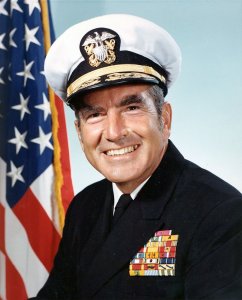
https://en.wikipedia.org/wiki/Elmo_Zumwalt
2 January 2000 - Retired Adm. Elmo R. Zumwalt, Jr., the 19th Chief of Naval Operations, dies at Duke University Medical Center, Durham, N.C.
Elmo Russell "Bud" Zumwalt Jr. (November 29, 1920 – January 2, 2000) was a United States Navy officer and the youngest person to serve as Chief of Naval Operations. As an admiral and later the 19th Chief of Naval Operations, Zumwalt played a major role in United States military history, especially during the Vietnam War. A decorated war veteran, Zumwalt reformed United States Navy personnel policies in an effort to improve enlisted life and ease racial tensions. After he retired from a 32-year navy career, he launched an unsuccessful campaign for the United States Senate.

https://en.wikipedia.org/wiki/Elmo_Zumwalt
Today in Naval History - Naval / Maritime Events in History
Other Events on 2 January
1797 - HM sloop Viper, Cptn. Henry Harding Parker, foundered off the Shannon after engaging the French fleet, which was attempting to land insurrectionists in Ireland. The crew perished.
HMS Vipere (1794) was a 16-gun brig-sloop, formerly a French privateer, which Flora captured in 1794. Vipere foundered in the estuary of the River Shannon on 2 January 1797 with the loss of her entire crew of 120 men
http://collections.rmg.co.uk/collec...el-358068;browseBy=vessel;vesselFacetLetter=V
1809 - Fifth Rate frigate 'HMS Aimable' (1782 -32), ex French frigate 'L'Aimable' (1776), captured French Sixth Rate corvette 'L'Iris' (1806 - 24)
https://threedecks.org/index.php?display_type=show_ship&id=2936
https://threedecks.org/index.php?display_type=show_ship&id=19565
https://threedecks.org/index.php?display_type=show_ship&id=6064
1809 - HMS Imperieuse (38), Thomas Cochrane, captured French cutter Gauloise (7), lugger Julie (5) and 11 supply vessels laden with wheat at Cadaques, just north of the Bay of Rosas
HMS Imperieuse was a 38-gun fifth-rate, previously the Spanish ship Medea (1797). She was captured in 1804 and taken into service as HMS Iphigenia but renamed Imperieuse in 1805, placed on harbour service in 1818, and sold in 1838.
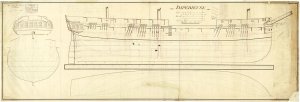
lines & profile NMM, Progress Book, volume 6, folio 329 states that 'Imperieuse' (1804) arrived at Plymouth Dockyard in October 1804 and was docked in February 1806 to be recoppered. She was launched in October 1806 and sailed in November 1806, having had a "large repair & fitted". After capture she was renamed 'Iphigenia' before being named again as 'Imperieuse'.
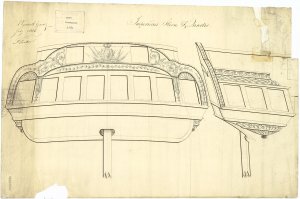
stern NMM, Progress Book, volume 6, folio 329 states that 'Imperieuse' (1804) arrived at Plymouth Dockyard in October 1804 and was docked in February 1806 to be recoppered. She was launched in October 1806 and sailed in November 1806, having had a "large repair & fitted". After capture she was renamed 'Iphigenia' before being named again as 'Imperieuse'.
In August 1806, Thomas Cochrane took command of the 38-gun frigate HMS Imperieuse, formerly the Spanish frigate Medea. One of his midshipmen was Frederick Marryat, who later wrote fictionalised accounts of his adventures with Cochrane.
In Imperieuse, Cochrane raided the Mediterranean coast of France during the continuing Napoleonic Wars. In 1808, Cochrane and a Spanish guerrilla force captured the fortress of Mongat, which straddled the road between Gerona and Barcelona. This delayed General Duhesme's French army for a month. On another raid, Cochrane copied code books from a signal station, leaving behind the originals so that the French would believe them uncompromised. When Imperieuse ran short of water, she sailed up the estuary of the Rhone to replenish. A French army marched into Catalonia and besieged Rosas, and Cochrane took part in the defence of the town. He occupied and defended Fort Trinidad (Castell de la Trinitat) for a number of weeks before the fall of the city forced him to leave; Cochrane was one of the last two men to quit the fort.
While captain of Speedy, Pallas, and Imperieuse, Cochrane became an effective practitioner of coastal warfare during the period. He attacked shore installations such as the Martello tower at Son Bou on Menorca, and he captured enemy ships in harbour by leading his men in boats in "cutting out" operations. He was a meticulous planner of every operation, which limited casualties among his men and maximised the chances of success.
In 1809, Cochrane commanded the attack by a flotilla of fire ships on Rochefort, as part of the Battle of the Basque Roads. The attack did considerable damage, but Cochrane blamed fleet commander Admiral Gambier for missing the opportunity to destroy the French fleet, accusations that resulted in the Court-martial of James, Lord Gambier. Cochrane claimed that, as a result of expressing his opinion publicly, the admiralty denied him the opportunity to serve afloat. But documentation shows that he was focussed on politics at this time and, indeed, refused a number of offers of command.
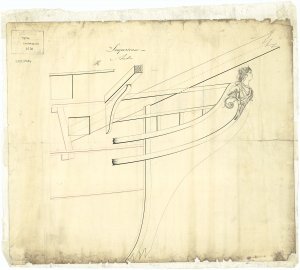
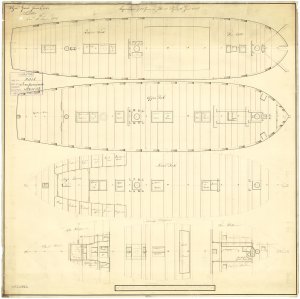
https://en.wikipedia.org/wiki/Thomas_Cochrane,_10th_Earl_of_Dundonald
http://collections.rmg.co.uk/collec...el-320421;browseBy=vessel;vesselFacetLetter=I
1921 - SS Santa Isabel (1915), a Spanish cargo liner which sank in a storm in 1921
On the night of January 2nd, 1921, the Spanish passenger ship SANTA ISABEL, en route from A Coruña to Villagarcia with general cargo, 84 crew and 187 passengers, was navigating in bad weather with heavy rains, reducing the visibility to nearly zero. She struck the 'Bajos de Pegar' (Pegar Shoal), 200 metres from Isla de Sálvora and started sinking very fast. Only 27 crew and 29 passengers were saved. The ship was subsequently salvaged in situ and only a few pieces of her remain.
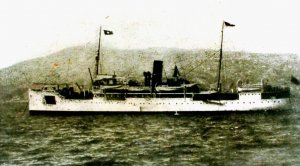
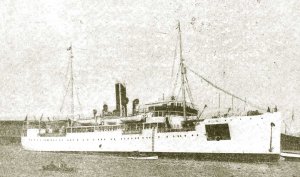
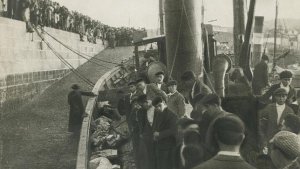
Read more at wrecksite:
https://www.wrecksite.eu/wreck.aspx?158026
2003 – The oil-spil oft he tanker Prestige reached the coast of France
https://en.wikipedia.org/wiki/Prestige_oil_spill
https://en.wikipedia.org/wiki/MV_Prestige
Other Events on 2 January
1797 - HM sloop Viper, Cptn. Henry Harding Parker, foundered off the Shannon after engaging the French fleet, which was attempting to land insurrectionists in Ireland. The crew perished.
HMS Vipere (1794) was a 16-gun brig-sloop, formerly a French privateer, which Flora captured in 1794. Vipere foundered in the estuary of the River Shannon on 2 January 1797 with the loss of her entire crew of 120 men
http://collections.rmg.co.uk/collec...el-358068;browseBy=vessel;vesselFacetLetter=V
1809 - Fifth Rate frigate 'HMS Aimable' (1782 -32), ex French frigate 'L'Aimable' (1776), captured French Sixth Rate corvette 'L'Iris' (1806 - 24)
https://threedecks.org/index.php?display_type=show_ship&id=2936
https://threedecks.org/index.php?display_type=show_ship&id=19565
https://threedecks.org/index.php?display_type=show_ship&id=6064
1809 - HMS Imperieuse (38), Thomas Cochrane, captured French cutter Gauloise (7), lugger Julie (5) and 11 supply vessels laden with wheat at Cadaques, just north of the Bay of Rosas
HMS Imperieuse was a 38-gun fifth-rate, previously the Spanish ship Medea (1797). She was captured in 1804 and taken into service as HMS Iphigenia but renamed Imperieuse in 1805, placed on harbour service in 1818, and sold in 1838.

lines & profile NMM, Progress Book, volume 6, folio 329 states that 'Imperieuse' (1804) arrived at Plymouth Dockyard in October 1804 and was docked in February 1806 to be recoppered. She was launched in October 1806 and sailed in November 1806, having had a "large repair & fitted". After capture she was renamed 'Iphigenia' before being named again as 'Imperieuse'.

stern NMM, Progress Book, volume 6, folio 329 states that 'Imperieuse' (1804) arrived at Plymouth Dockyard in October 1804 and was docked in February 1806 to be recoppered. She was launched in October 1806 and sailed in November 1806, having had a "large repair & fitted". After capture she was renamed 'Iphigenia' before being named again as 'Imperieuse'.
In August 1806, Thomas Cochrane took command of the 38-gun frigate HMS Imperieuse, formerly the Spanish frigate Medea. One of his midshipmen was Frederick Marryat, who later wrote fictionalised accounts of his adventures with Cochrane.
In Imperieuse, Cochrane raided the Mediterranean coast of France during the continuing Napoleonic Wars. In 1808, Cochrane and a Spanish guerrilla force captured the fortress of Mongat, which straddled the road between Gerona and Barcelona. This delayed General Duhesme's French army for a month. On another raid, Cochrane copied code books from a signal station, leaving behind the originals so that the French would believe them uncompromised. When Imperieuse ran short of water, she sailed up the estuary of the Rhone to replenish. A French army marched into Catalonia and besieged Rosas, and Cochrane took part in the defence of the town. He occupied and defended Fort Trinidad (Castell de la Trinitat) for a number of weeks before the fall of the city forced him to leave; Cochrane was one of the last two men to quit the fort.
While captain of Speedy, Pallas, and Imperieuse, Cochrane became an effective practitioner of coastal warfare during the period. He attacked shore installations such as the Martello tower at Son Bou on Menorca, and he captured enemy ships in harbour by leading his men in boats in "cutting out" operations. He was a meticulous planner of every operation, which limited casualties among his men and maximised the chances of success.
In 1809, Cochrane commanded the attack by a flotilla of fire ships on Rochefort, as part of the Battle of the Basque Roads. The attack did considerable damage, but Cochrane blamed fleet commander Admiral Gambier for missing the opportunity to destroy the French fleet, accusations that resulted in the Court-martial of James, Lord Gambier. Cochrane claimed that, as a result of expressing his opinion publicly, the admiralty denied him the opportunity to serve afloat. But documentation shows that he was focussed on politics at this time and, indeed, refused a number of offers of command.


https://en.wikipedia.org/wiki/Thomas_Cochrane,_10th_Earl_of_Dundonald
http://collections.rmg.co.uk/collec...el-320421;browseBy=vessel;vesselFacetLetter=I
1921 - SS Santa Isabel (1915), a Spanish cargo liner which sank in a storm in 1921
On the night of January 2nd, 1921, the Spanish passenger ship SANTA ISABEL, en route from A Coruña to Villagarcia with general cargo, 84 crew and 187 passengers, was navigating in bad weather with heavy rains, reducing the visibility to nearly zero. She struck the 'Bajos de Pegar' (Pegar Shoal), 200 metres from Isla de Sálvora and started sinking very fast. Only 27 crew and 29 passengers were saved. The ship was subsequently salvaged in situ and only a few pieces of her remain.



Read more at wrecksite:
https://www.wrecksite.eu/wreck.aspx?158026
2003 – The oil-spil oft he tanker Prestige reached the coast of France
https://en.wikipedia.org/wiki/Prestige_oil_spill
https://en.wikipedia.org/wiki/MV_Prestige


